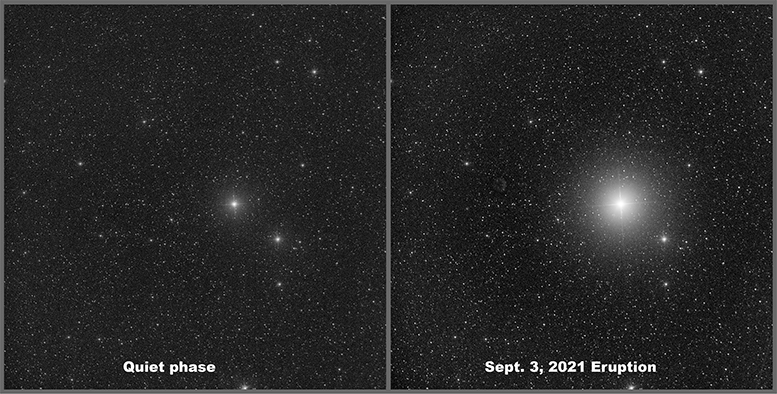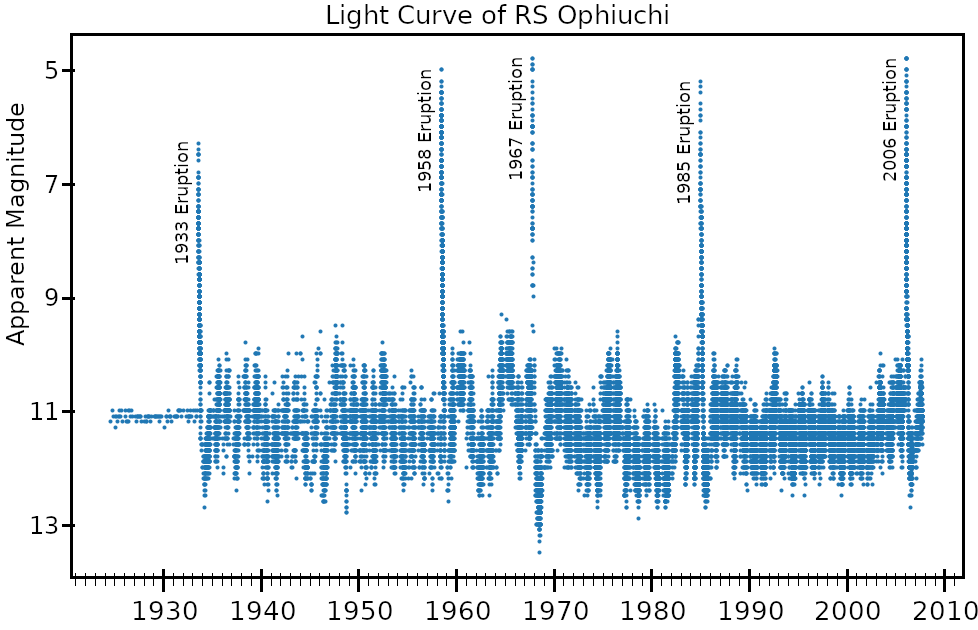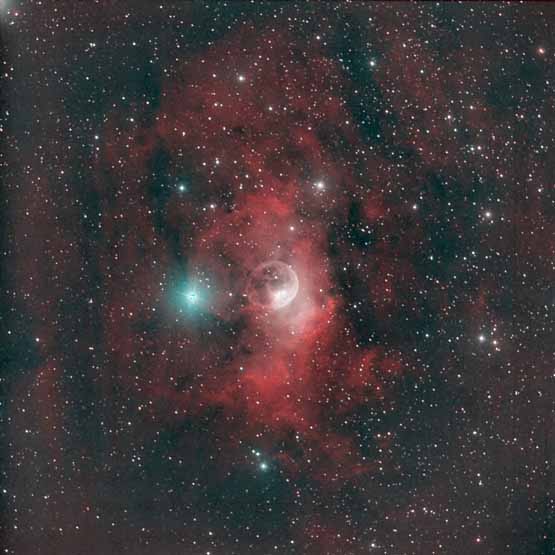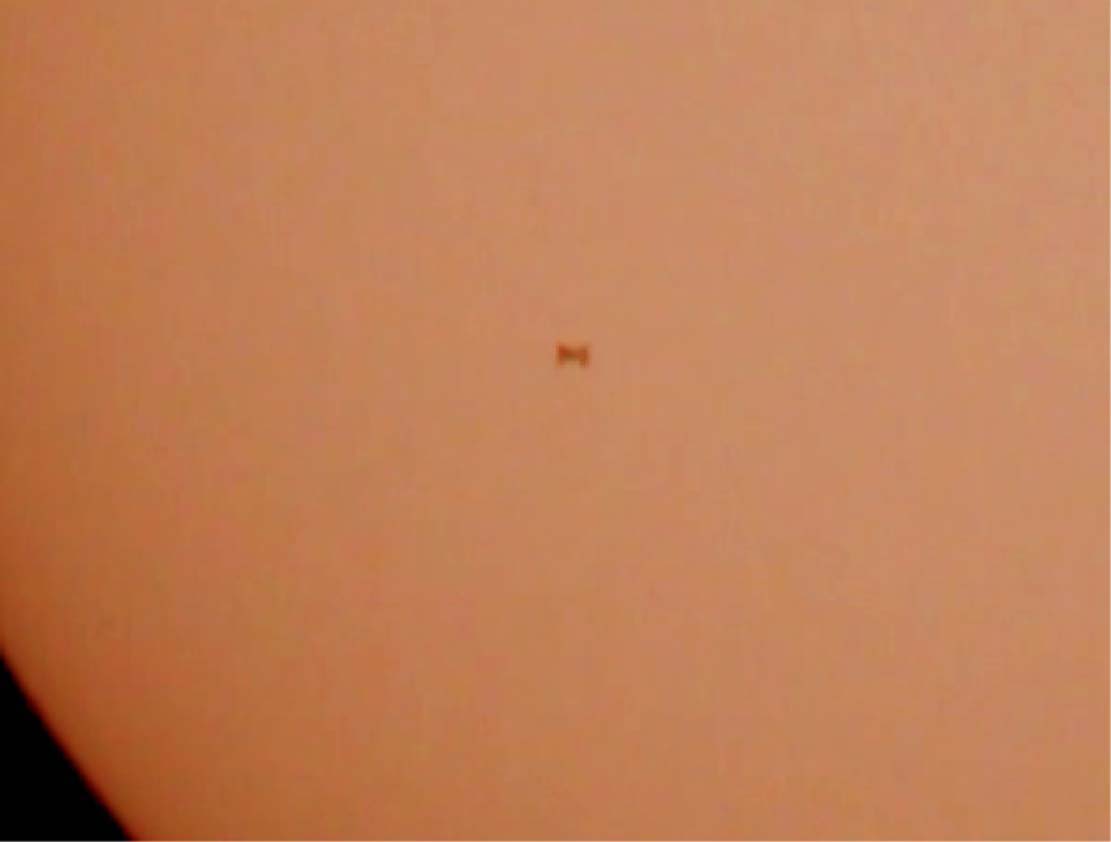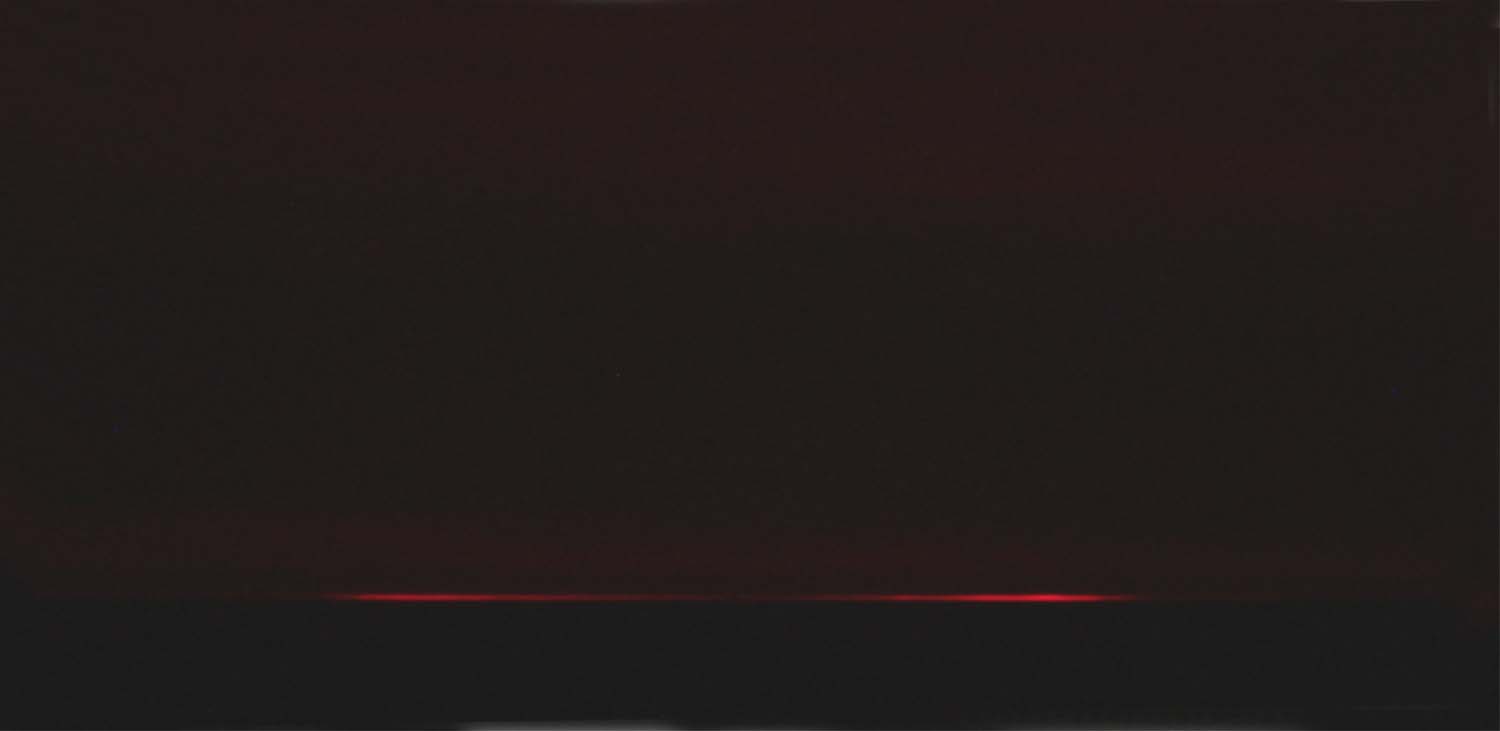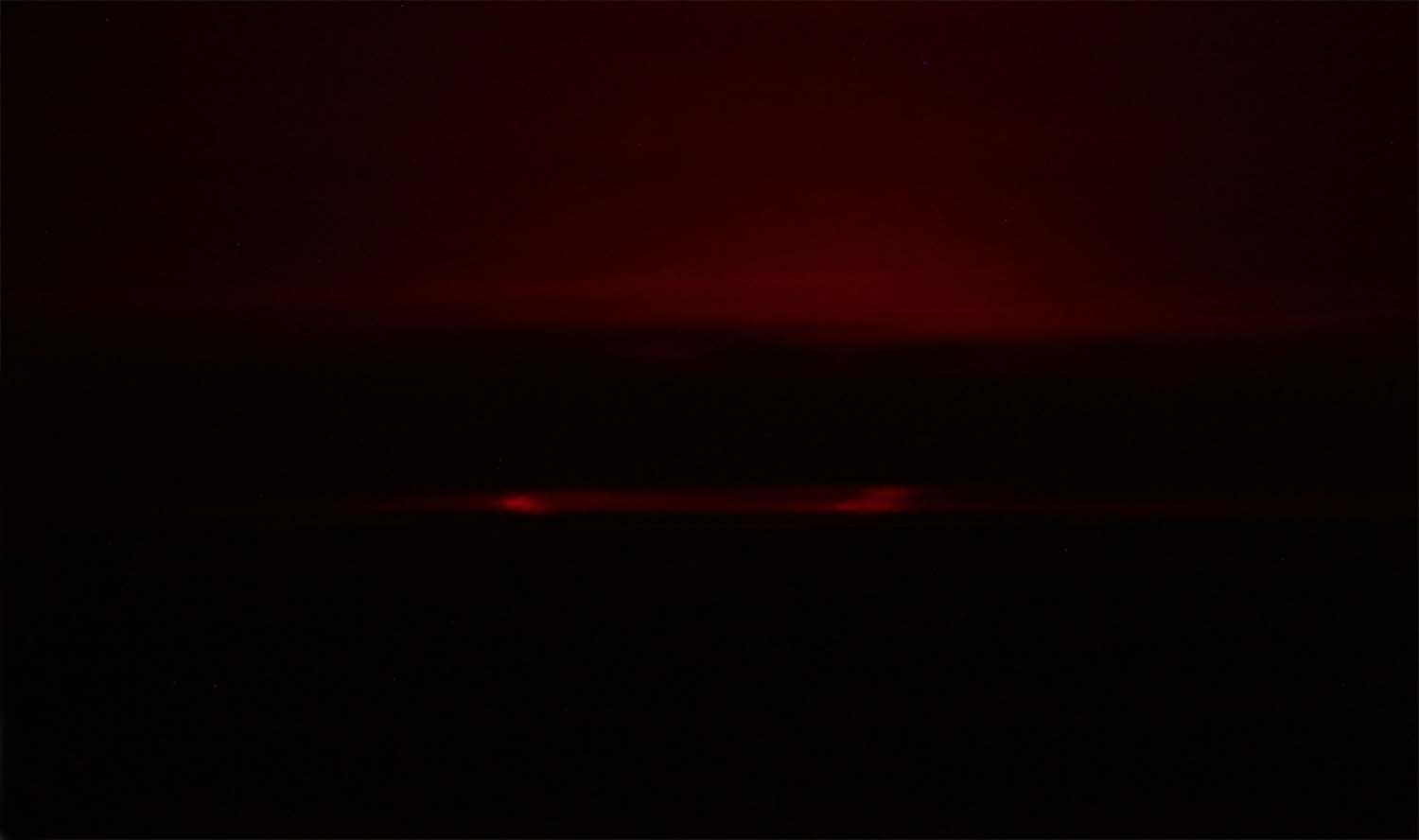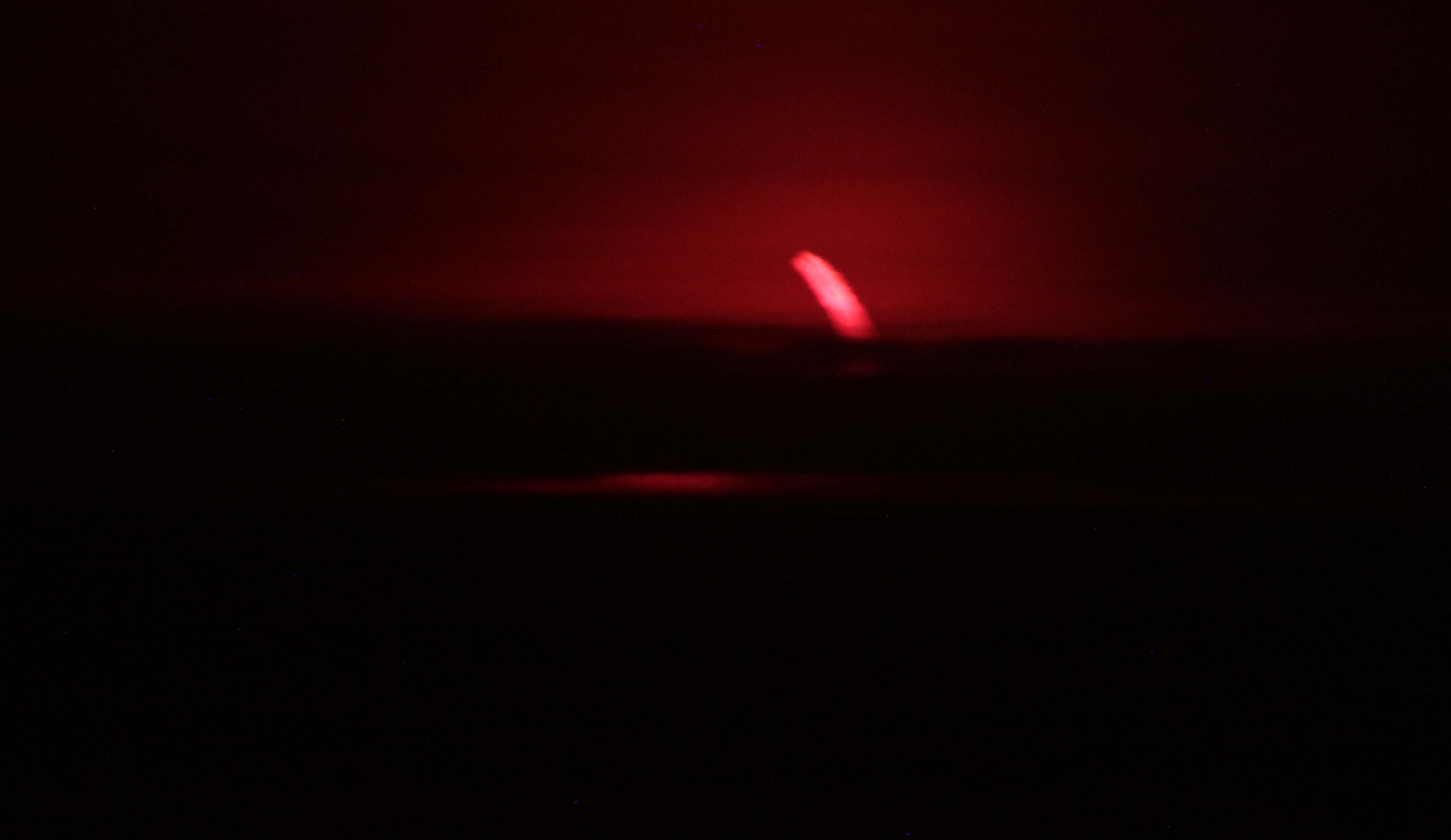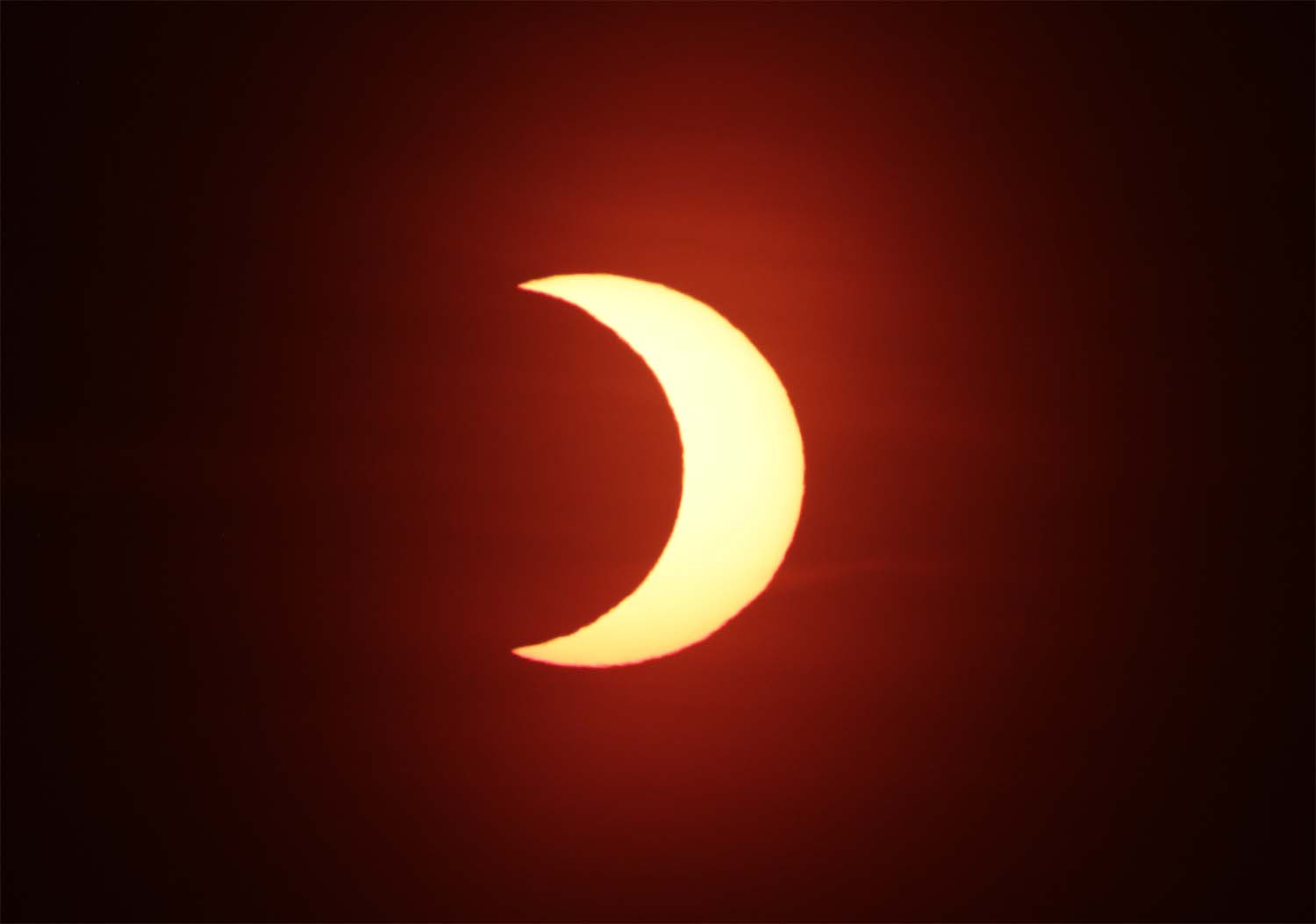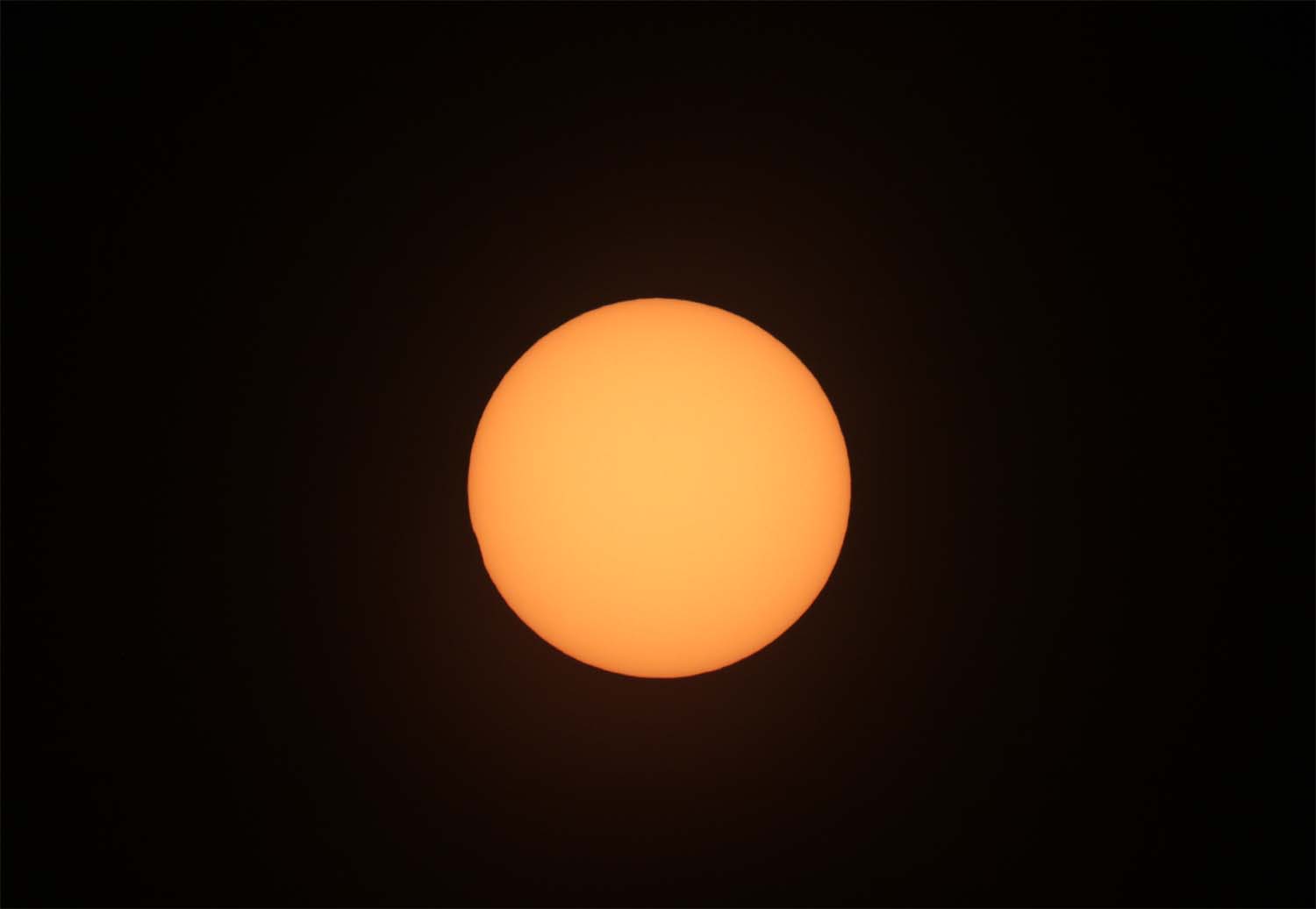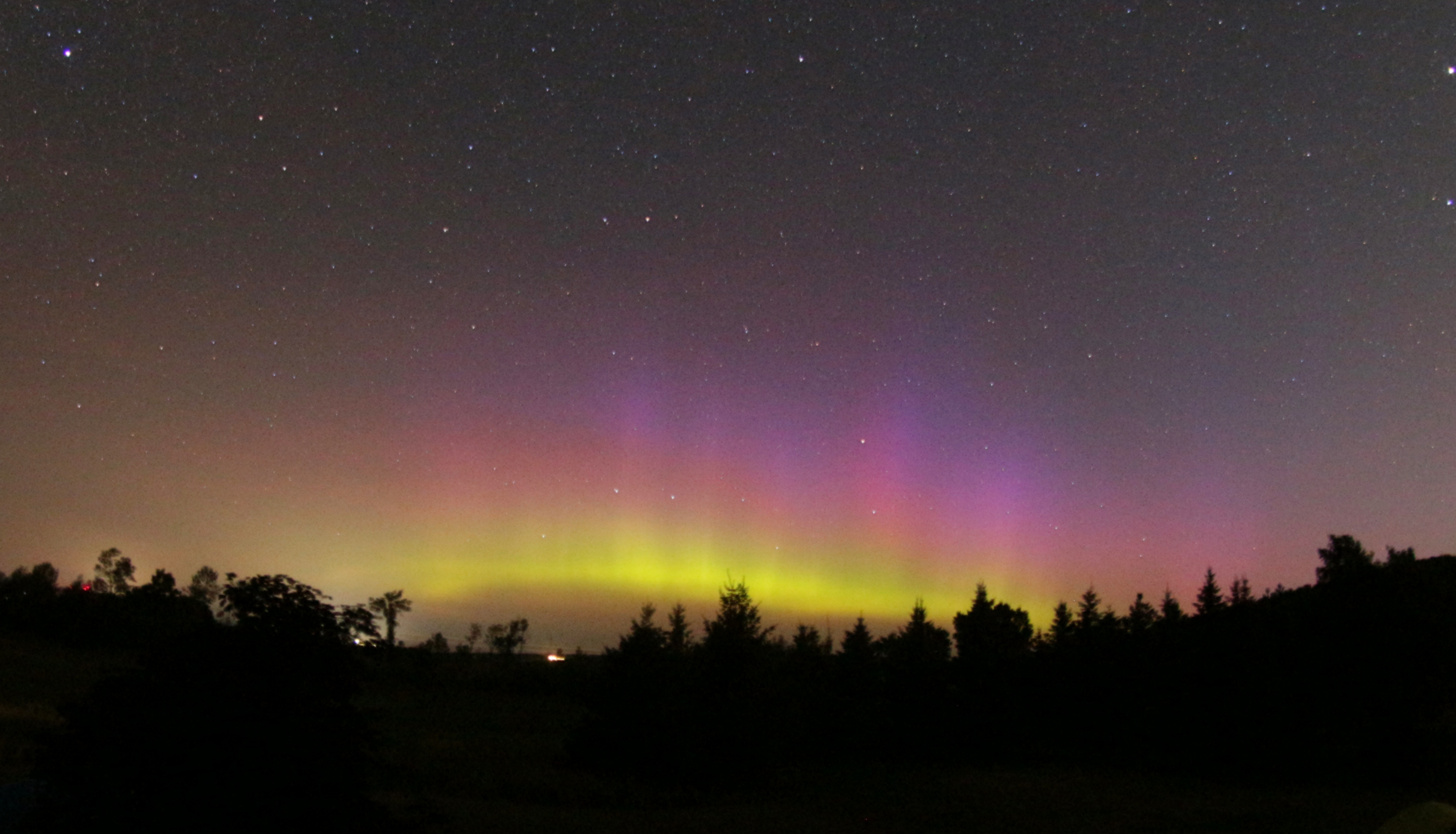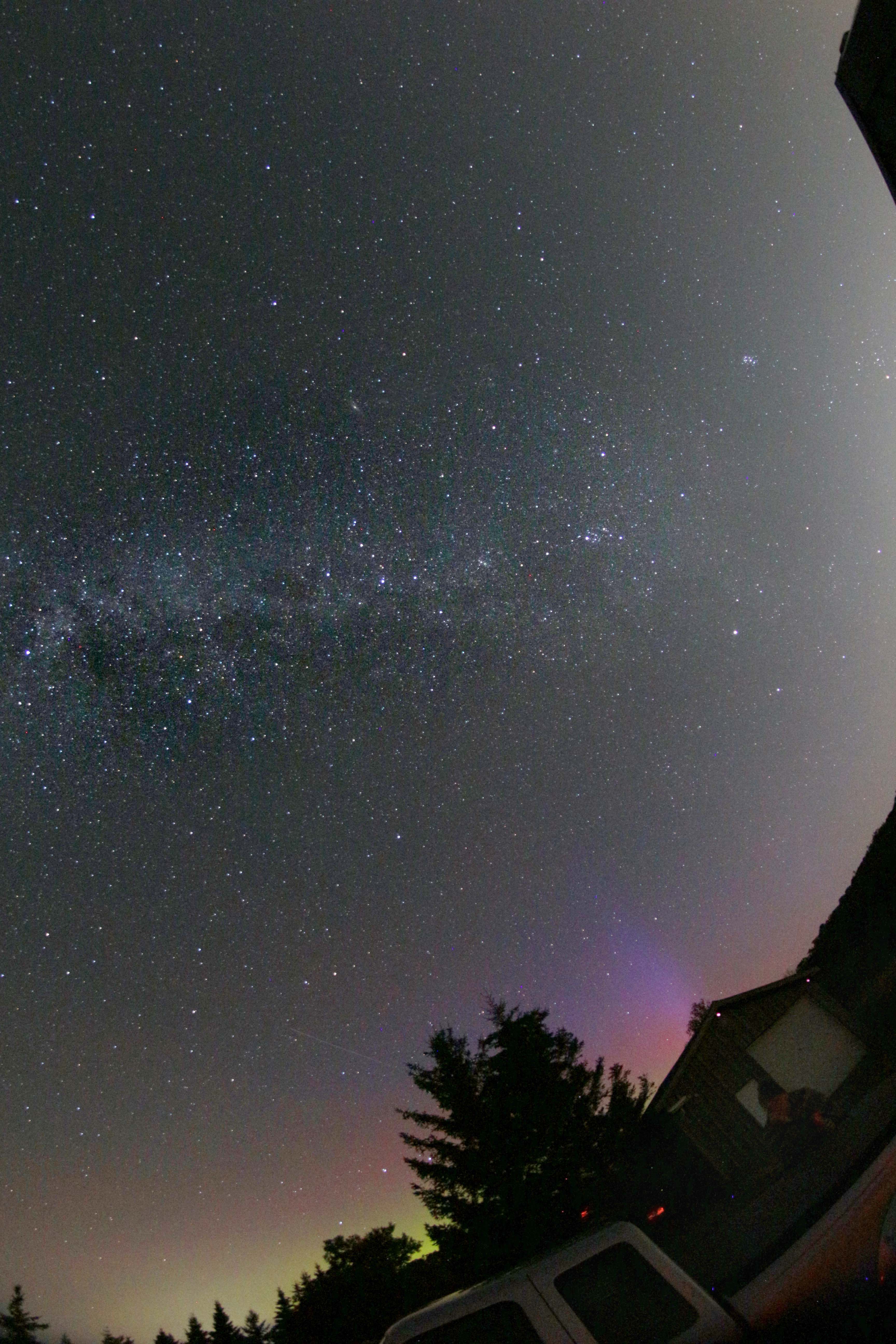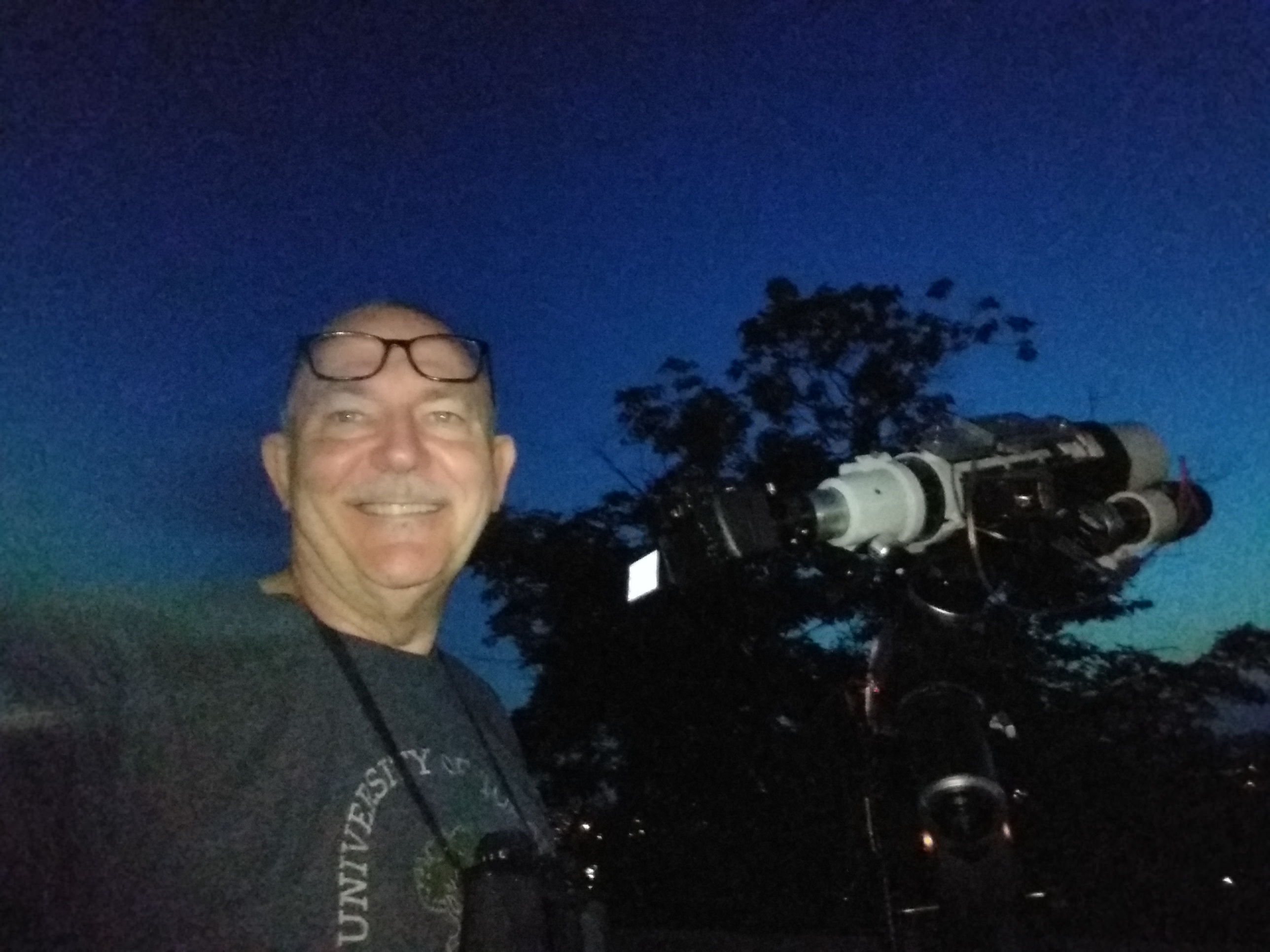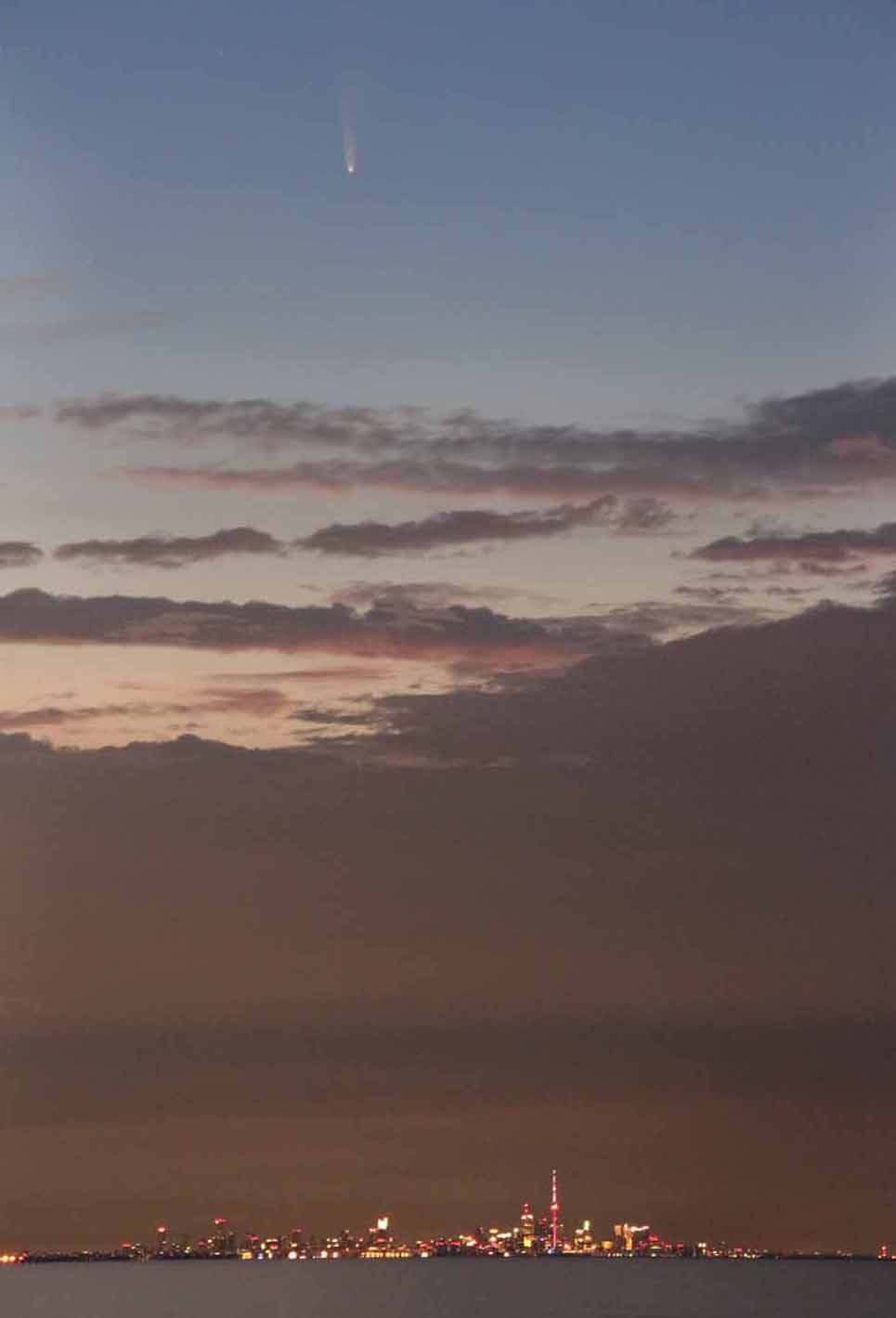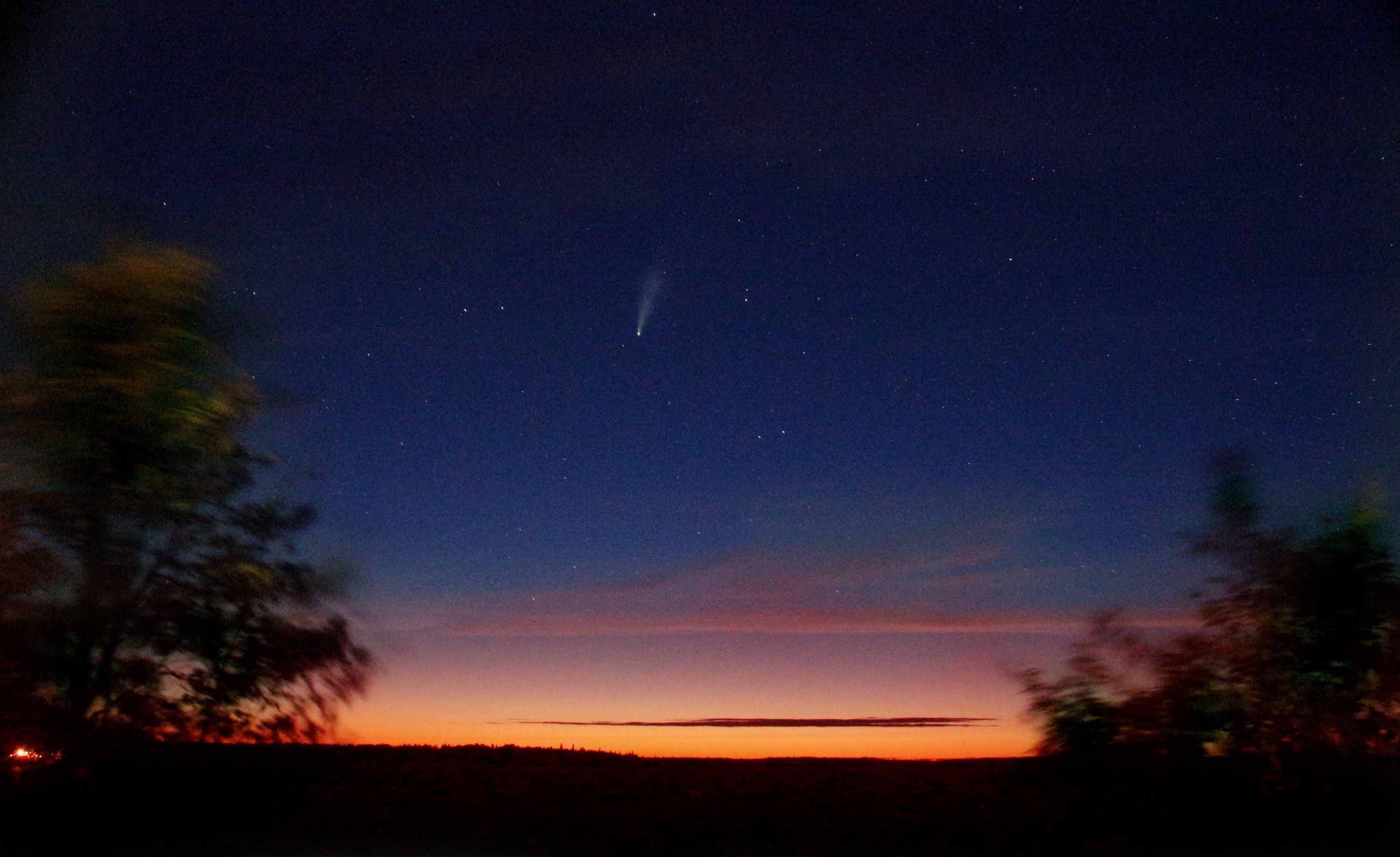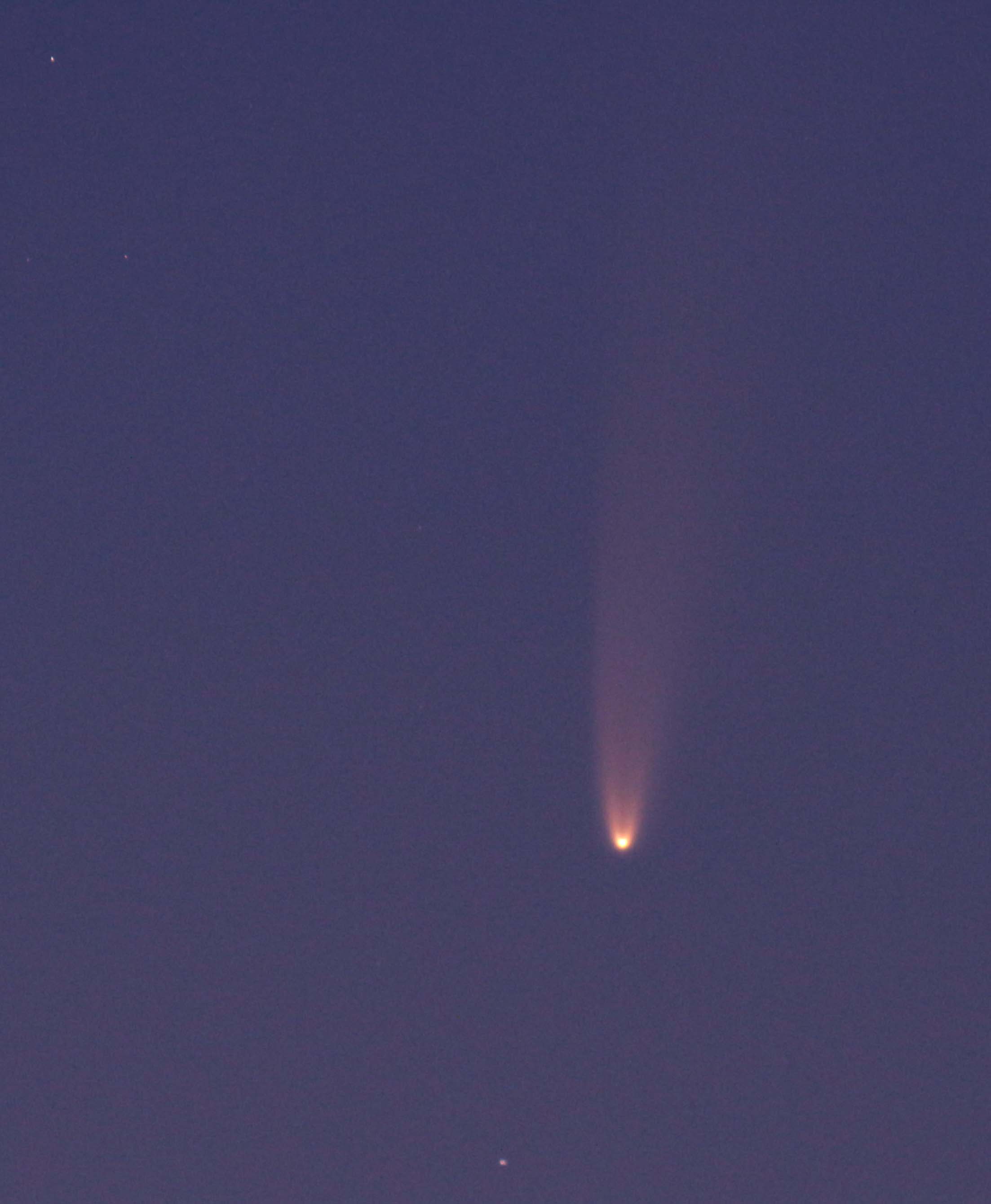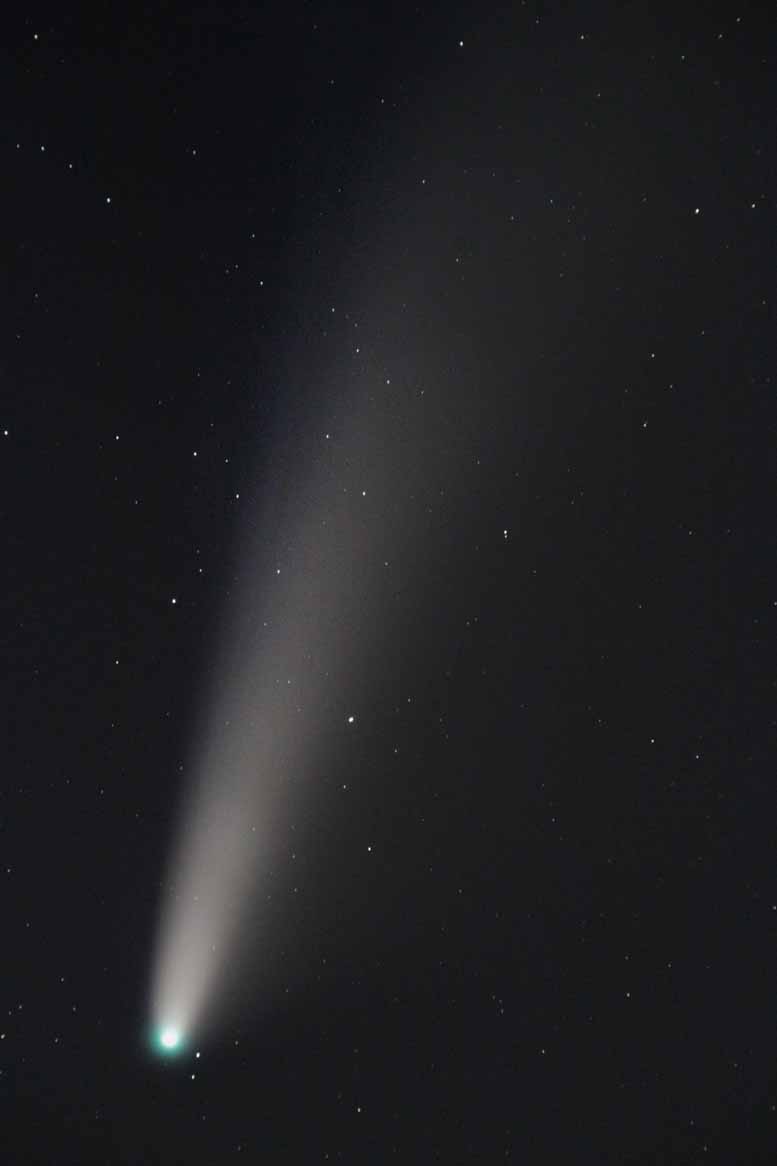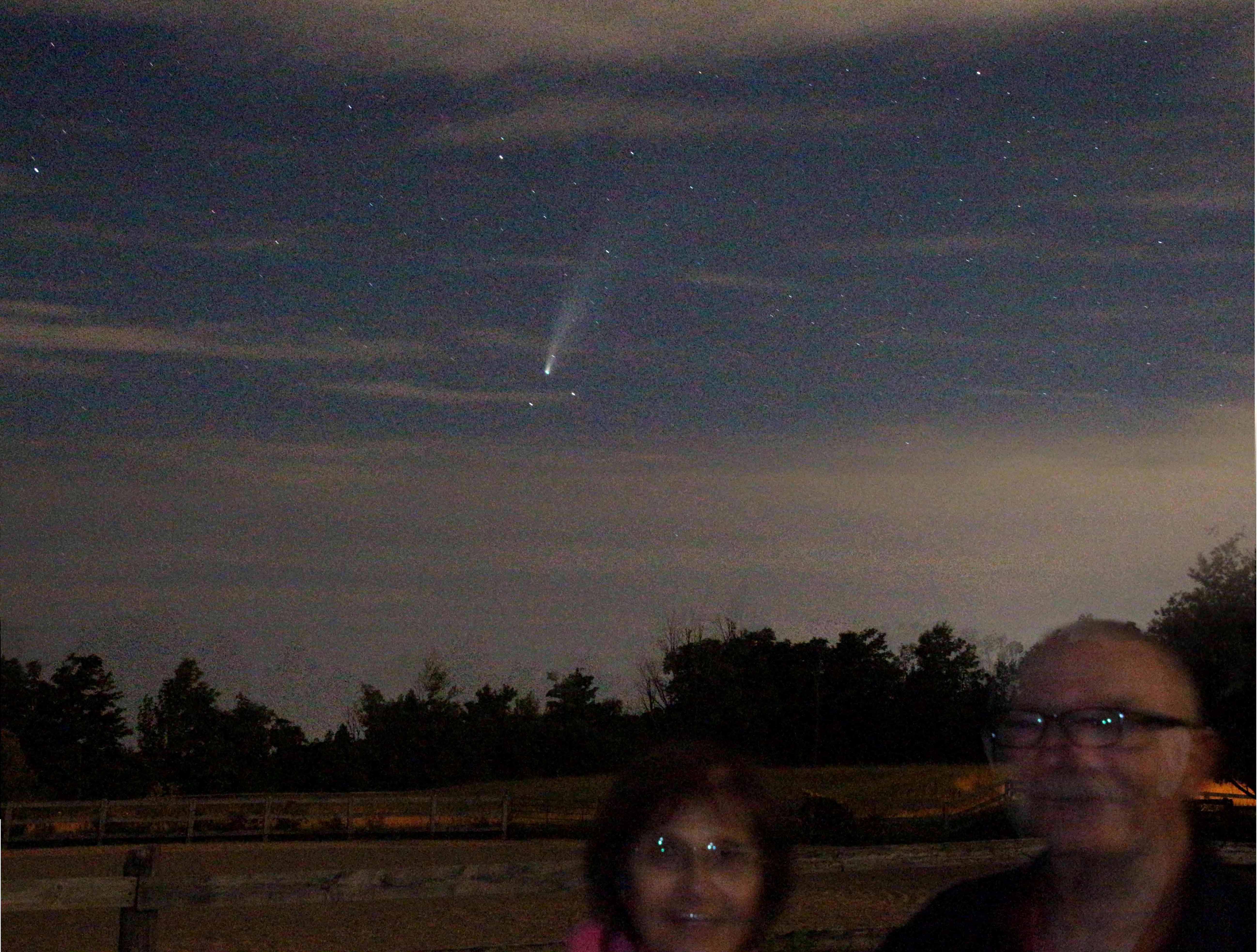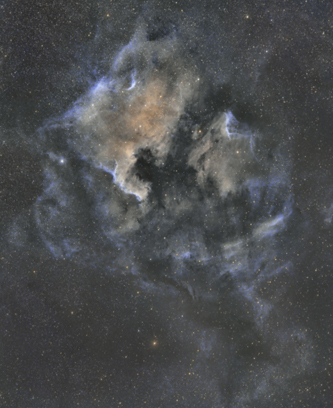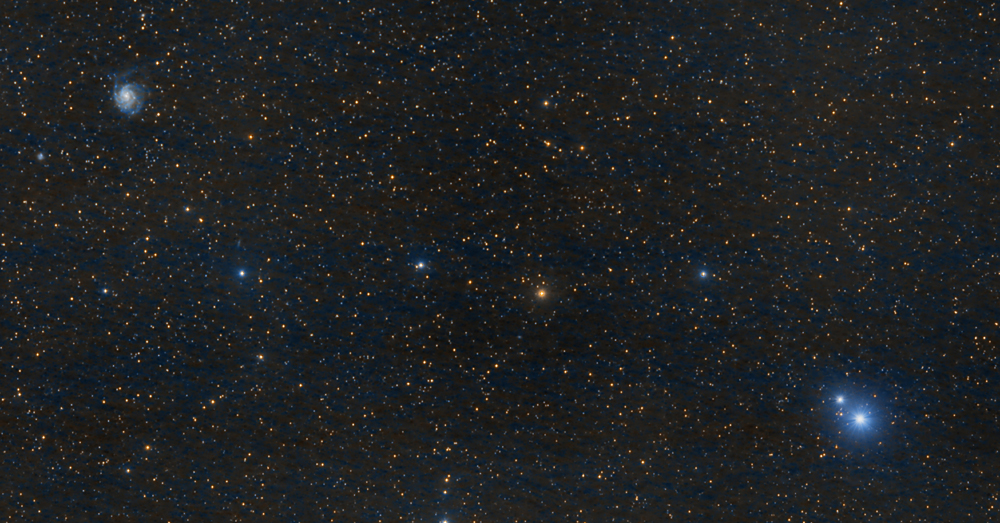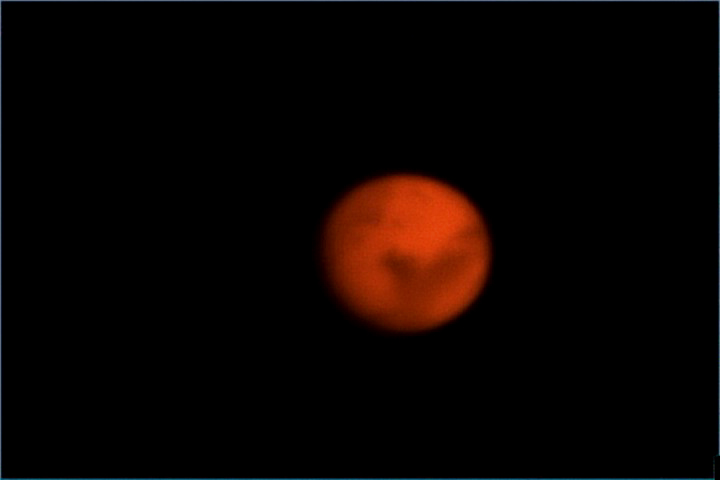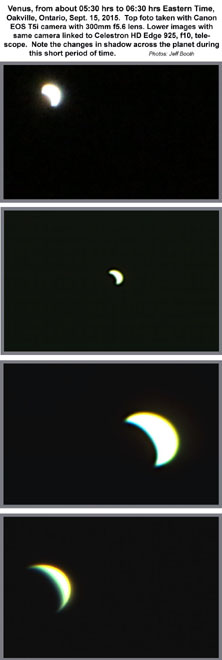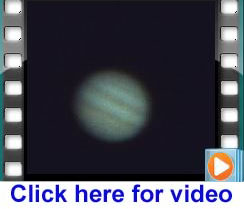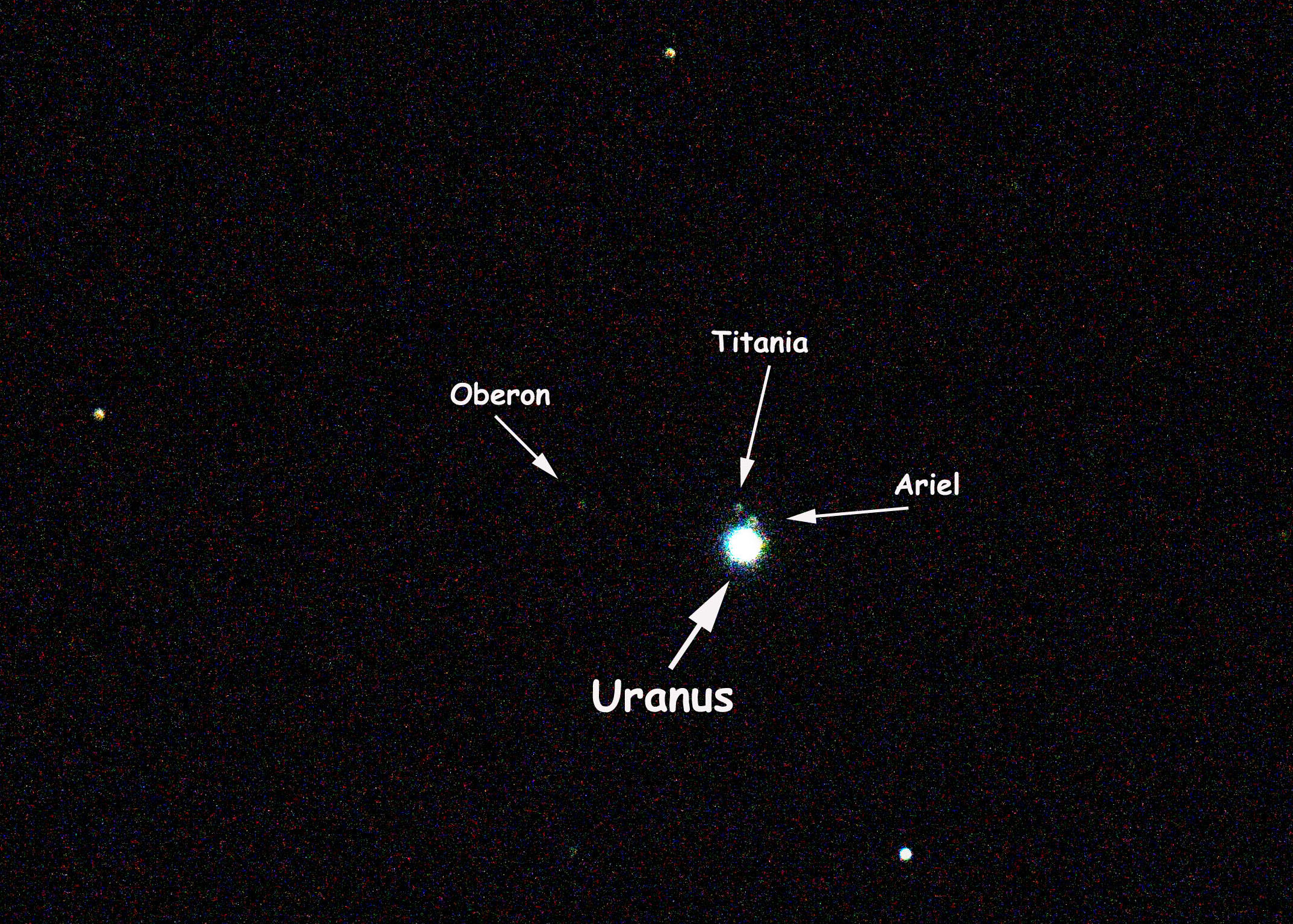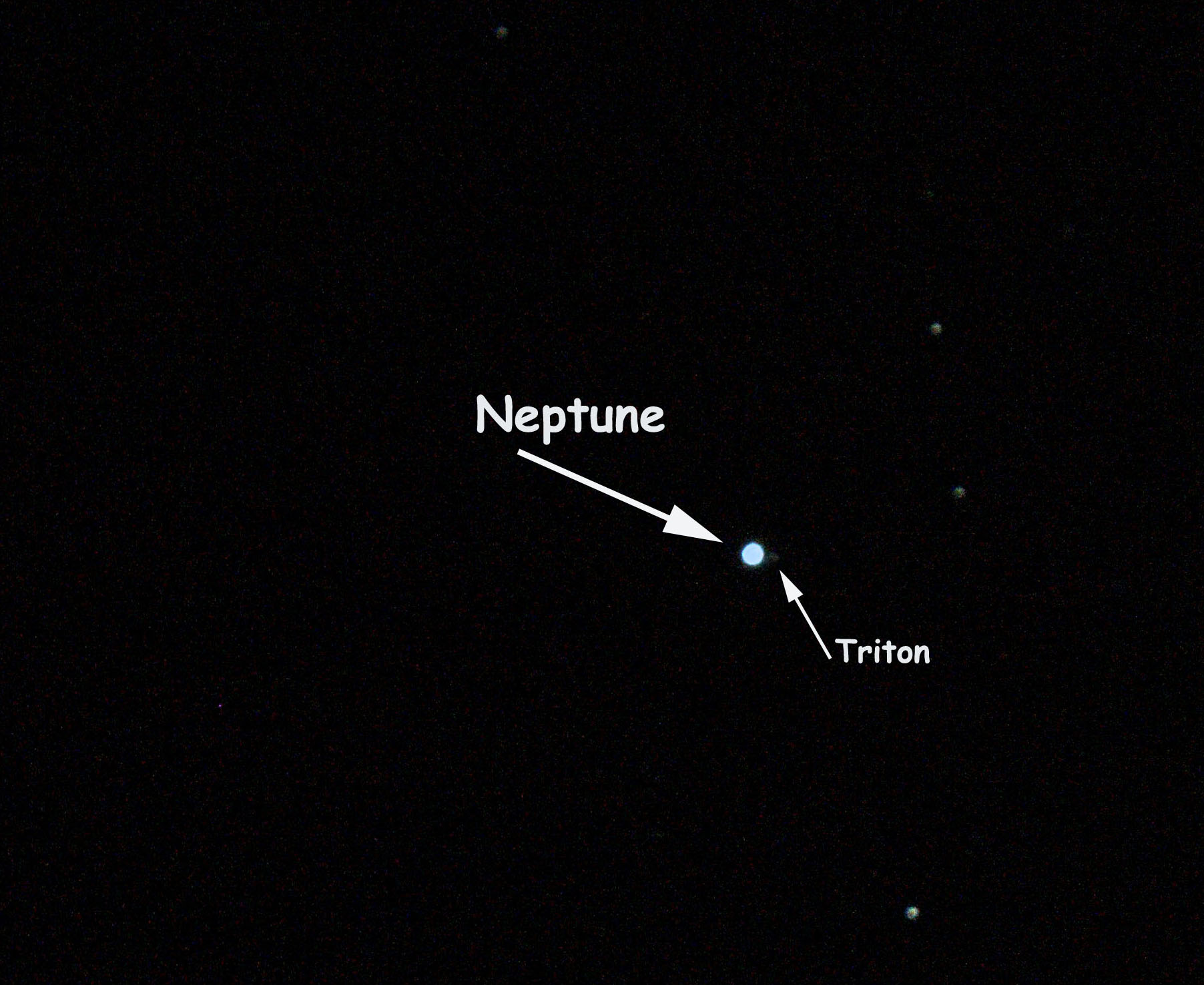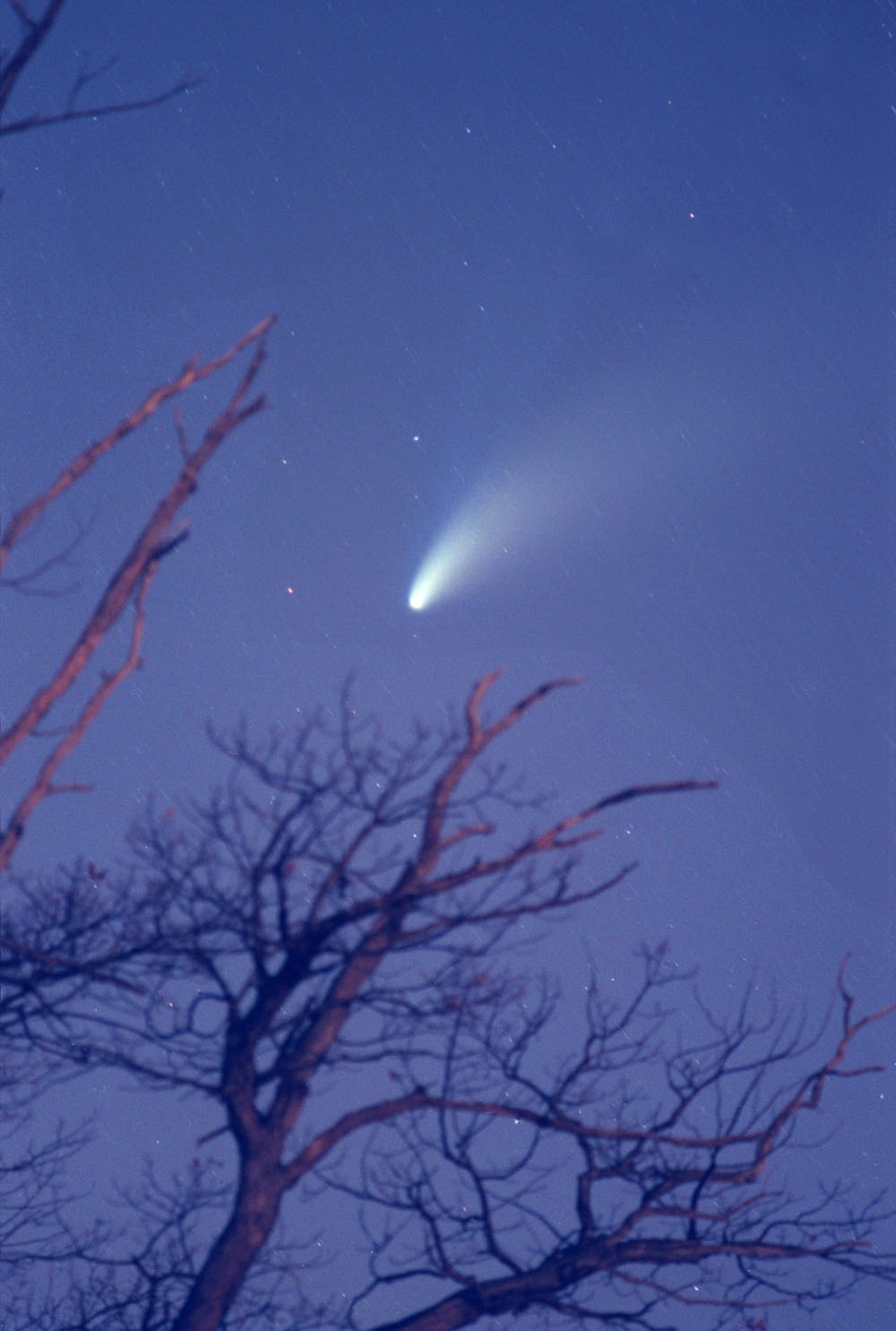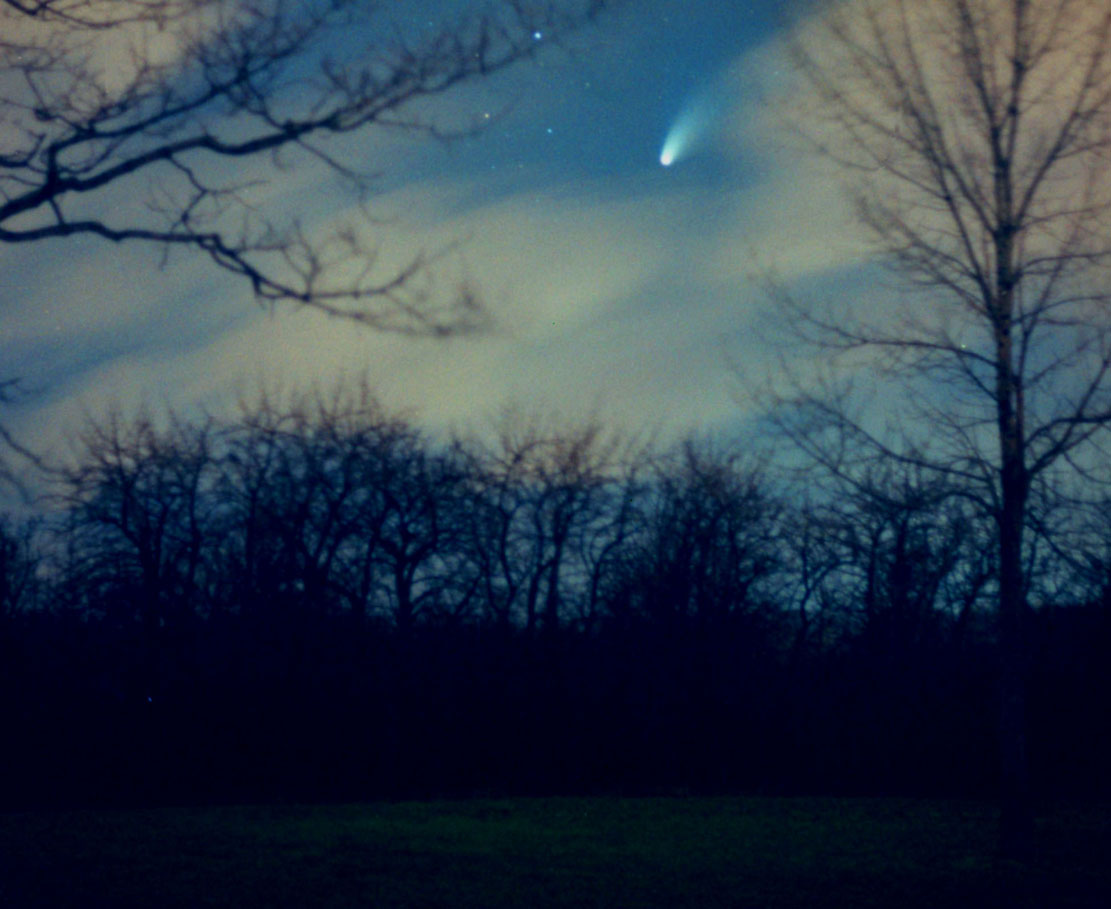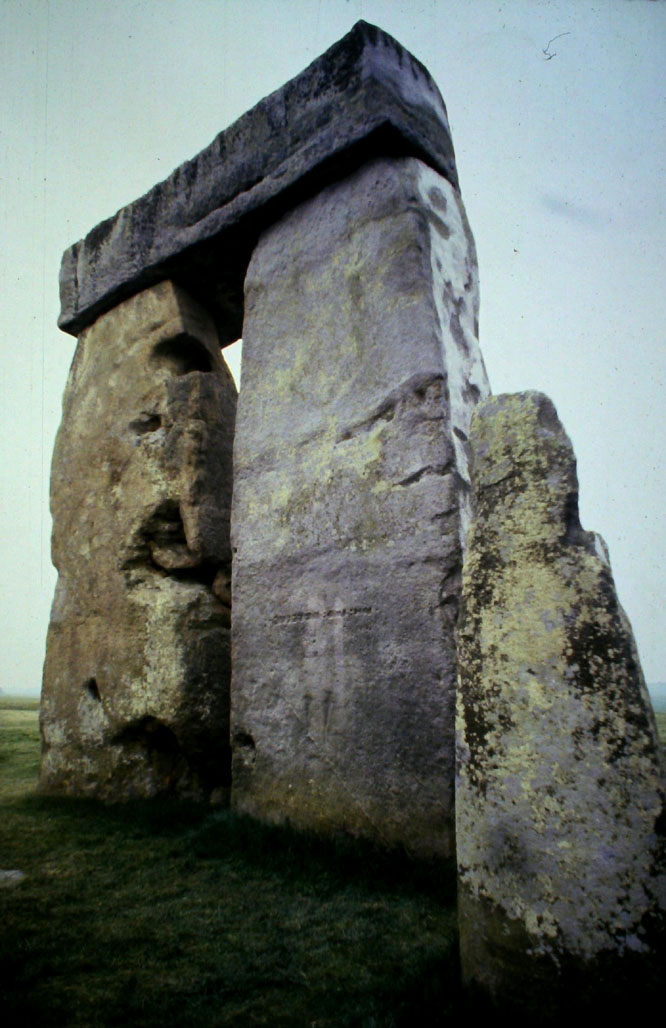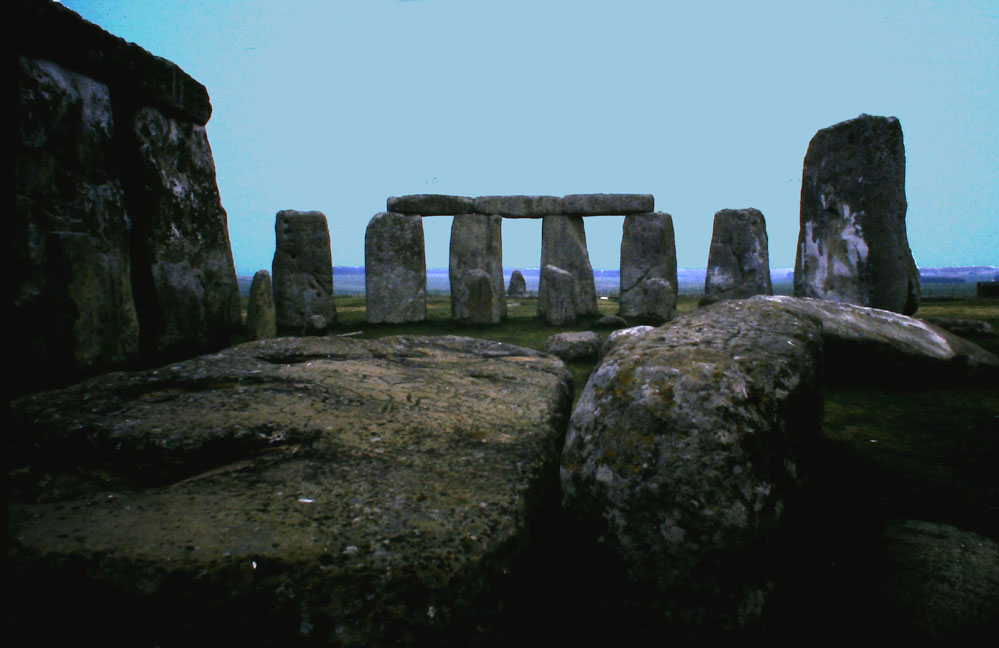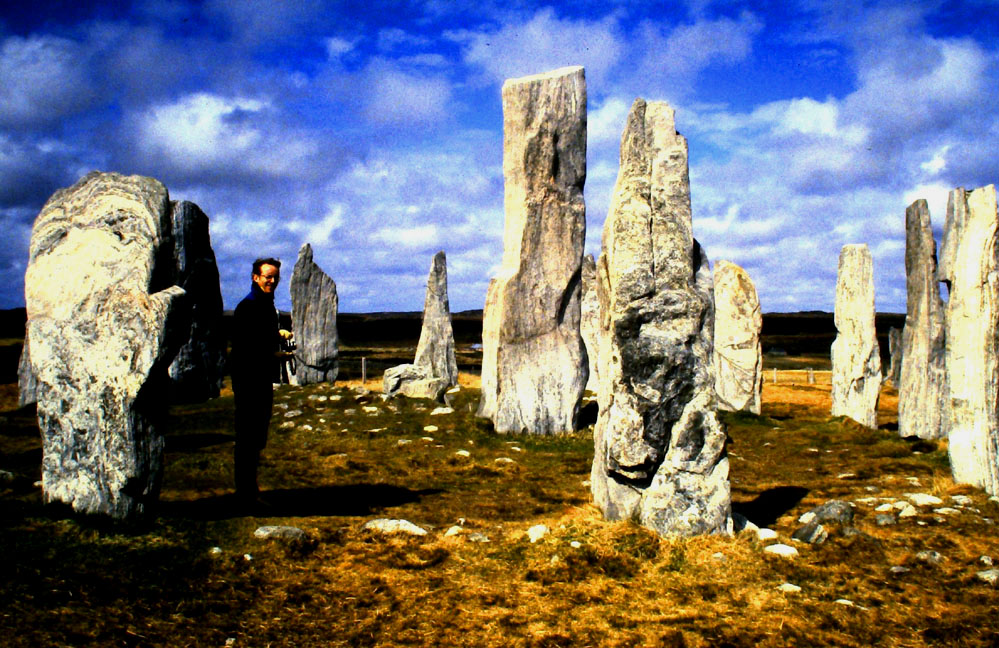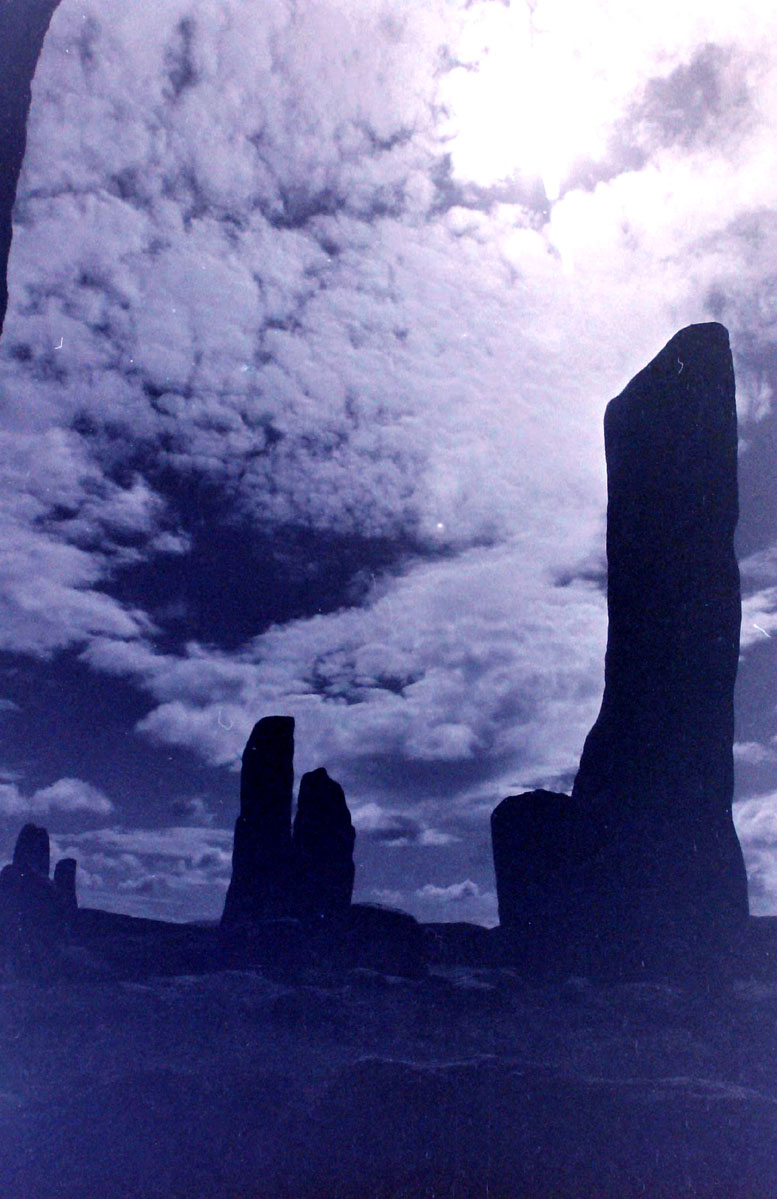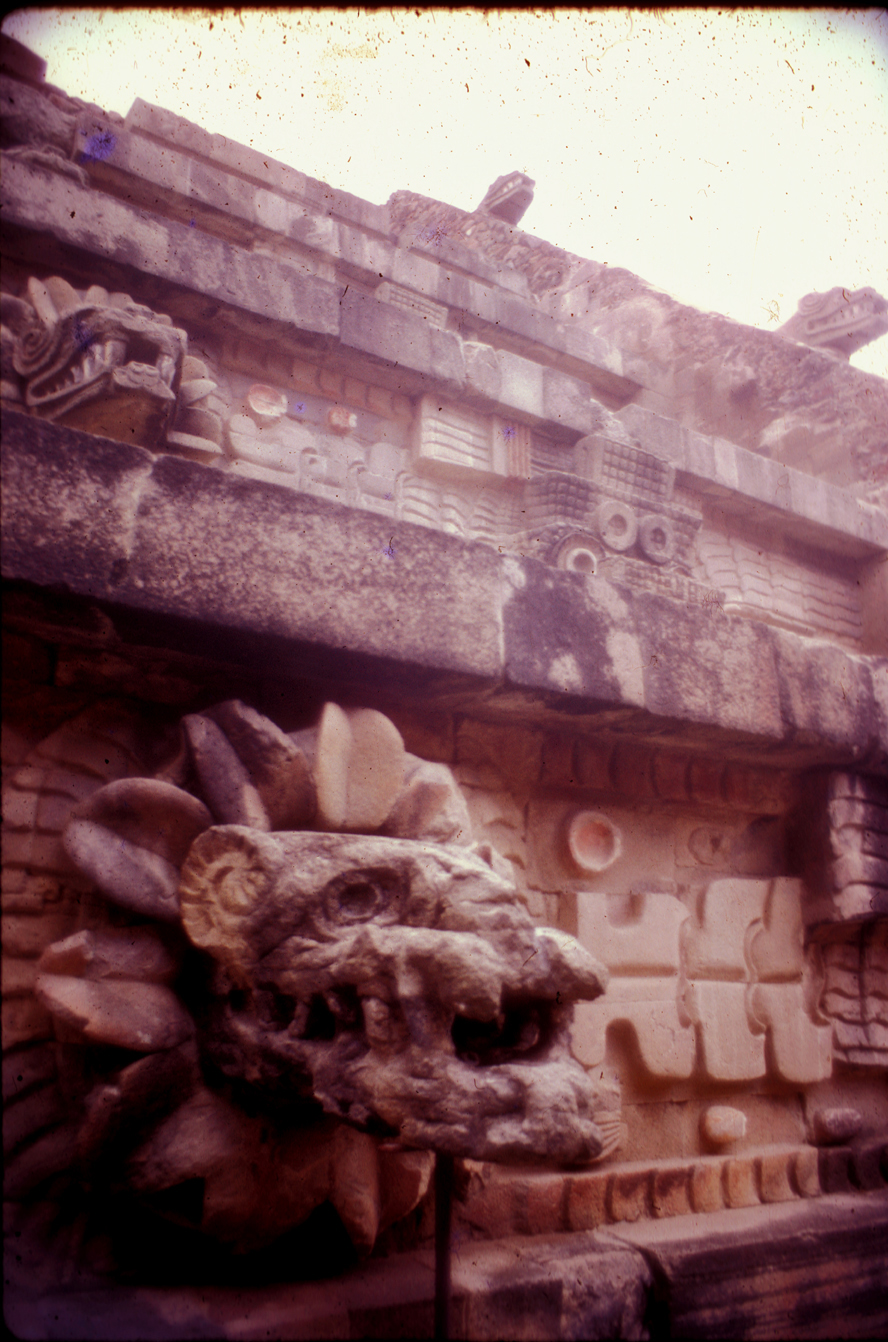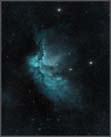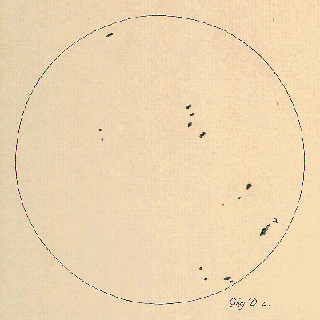 Welcome to galileostelescope.net
Welcome to galileostelescope.net
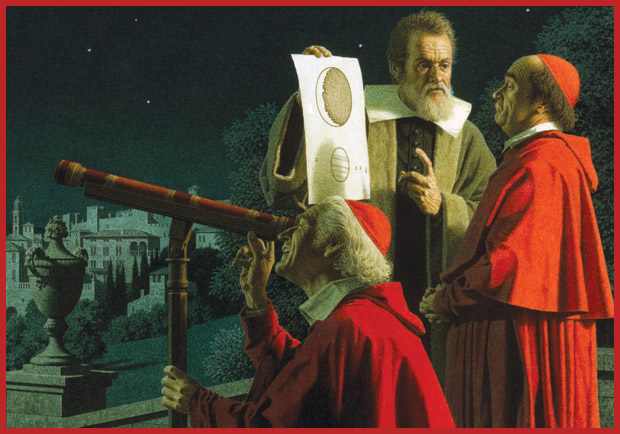 To see a reproduction of Galileo's 1609 handmade telescope, held in the collection of the Royal Astronomical Society of Canada, please click: GALILEO'S TELESCOPE > More on Galileo Galilei here: GALILEO > To see an image of a RASC reproduction of Sir Isaac Newton's revolutionary reflecting telescope, circa 1609, click:  |
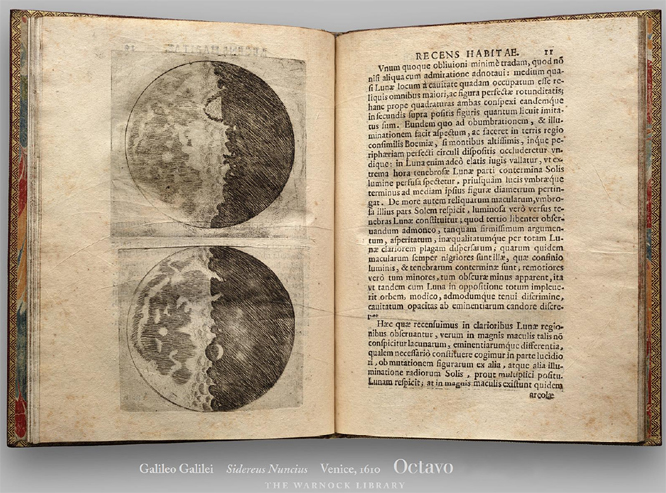 Galileo Galilei's seminal Sidereus Nuncius (Starry Messenger), from 1610, was the first published scientific work based on observations made through a telescope. Please click the pages to view this work (in translation). ------------------------------------------------ The animated graphic, above left, is of his record of sunspot activity, published a few years later in Istoria e Dimostrazioni Intorno Alle Macchie Solari e Loro Accidenti Rome (History and Demonstrations Concerning Sunspots and their Properties, published 1613). Click here for more: SUNSPOT DRAWINGS |
The Webmaster, Tessie, is happy to share a photograph of herself.
(Tessie is our beloved rescue cat ... and you can see some astro gear behind her ...
Email the webmaster

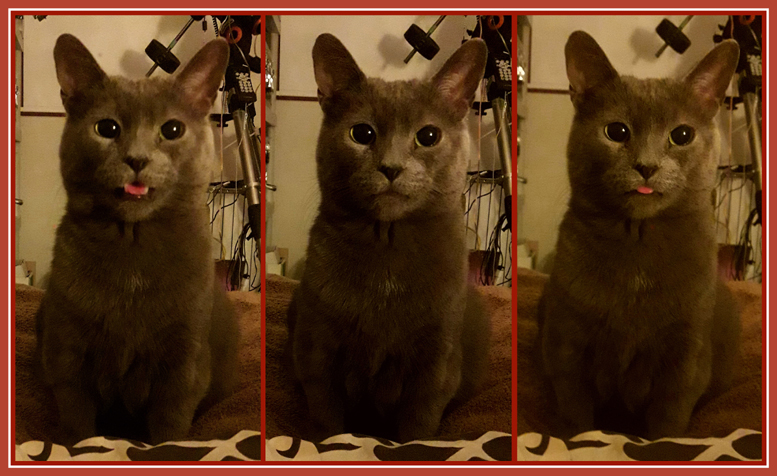
Tessie, by the way, is our informal name for her. Her correct name, implanted on her microchip, is Tess.
For the record, she owned the name before the recently launched Transiting Exoplanet Survey Satellite (Tess) lifted off from Cape Canaveral in April 2018 ....
For more on this remarkable NASA satellite and the science it will facilitate, click here:

All astronomical images (and processing of supporting data) on this website are the work of Tessie's main human.
OK, there may be a very small number that are otherwise ... these will be pointed out.
|
The 'Green'
comet
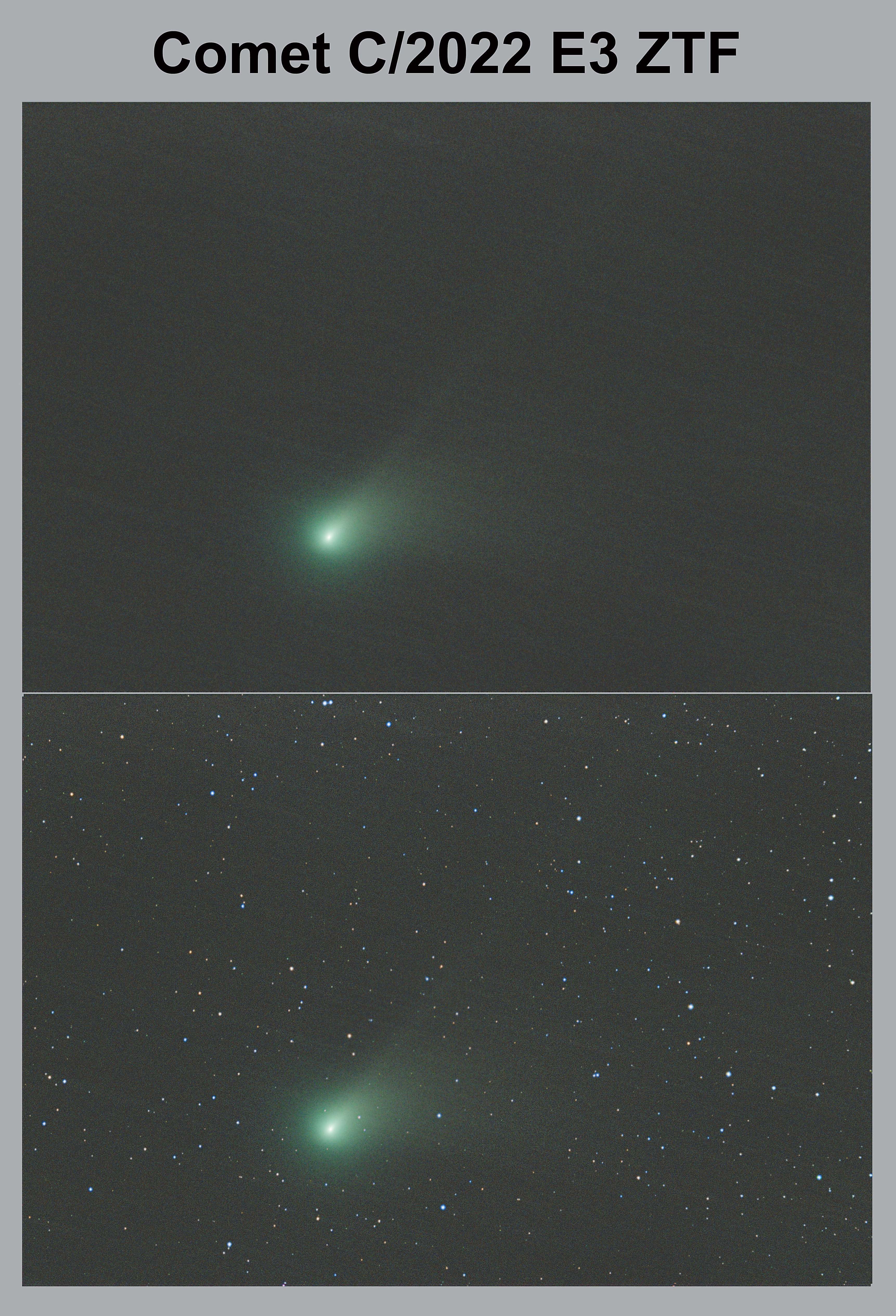 THIS IS the comet that was the newsmaker in early 2023, it was last near Earth when Neanderthals hunted here. C/2022 E3 (ZTF) is a long-period comet from the Oort cloud that was discovered by the Zwicky Transient Facility (ZTF) on 2 March 2022. The comet has a bright green glow around its nucleus, due to the effect of sunlight on diatomic carbon and (highly toxic) cyanogen. The comet's systematic designation starts with C to indicate that it is not a periodic comet, and "2022 E3" means that it was the third comet to be discovered in the first half of March 2022.[5] The comet nucleus was estimated to be about a kilometer in size, rotating every 8.5 to 8.7 hours. Its tails of dust and gas extended for millions of kilometers and, during January 2023, an anti-tail was also visible.[10] The comet reached its perihelion on 12 January 2023, at a distance of 1.11 AU (166 million km; 103 million mi), and the closest approach to Earth was on 1 February 2023, at a distance of 0.28 AU (42 million km; 26 million mi). The comet reached magnitude 5 and was visible with the naked eye under moonless dark skies. The images here were captured Feb. 12, from our Oakville backyard using a SkyWatcher 600 ED f/7.5 telesope with Canon T5i DSLR. The image is a stacking of 325x 15-second exposures. One image was processed to best show the two tails, the other image was processed to show the comet 'normally', against a starfield. Processed in PixInsight. Two tails? Yes, indeed. There is the gas tail and there is the dust tail. As a comet approaches the inner Solar System, solar radiation causes the volatile materials within the comet to vaporize and stream out of the nucleus, carrying dust away with them. The streams of dust and gas thus released form a huge, extremely tenuous atmosphere around the comet called the coma, and the force exerted on the coma by the Sun's radiation pressure and solar wind cause an enormous tail to form, which points away from the Sun. The streams of dust and gas each form their own distinct tail, pointing in slightly different directions. The tail of dust is left behind in the comet's orbit in such a manner that it often forms a curved tail called the antitail, only when it seems that it is directed towards the Sun. At the same time, the ion tail, made of gases, always points along the streamlines of the solar wind as it is strongly affected by the magnetic field of the plasma of the solar wind. The ion tail follows the magnetic field lines rather than an orbital trajectory. Parallax viewing from the Earth may sometimes mean the tails appear to point in opposite directions. |
|
Total Lunar Eclipse -
The
 Red Moon Red Moonof Nov. 8, 2022  HERE’S A
fun photo (above) … or two
... (below) ... Location was
Moffat Park, in rural west Milton, in Ontario,
Canada … a reasonably dark location. (2) with Comet Neowise, in 2020, (3) with the annular solar eclipse of 2021, (4) and now, a total Lunar eclipse...
There are lots of
great images of the total Lunar eclipse,
of 2019, further down on this web page
... just scroll down until you see a
large
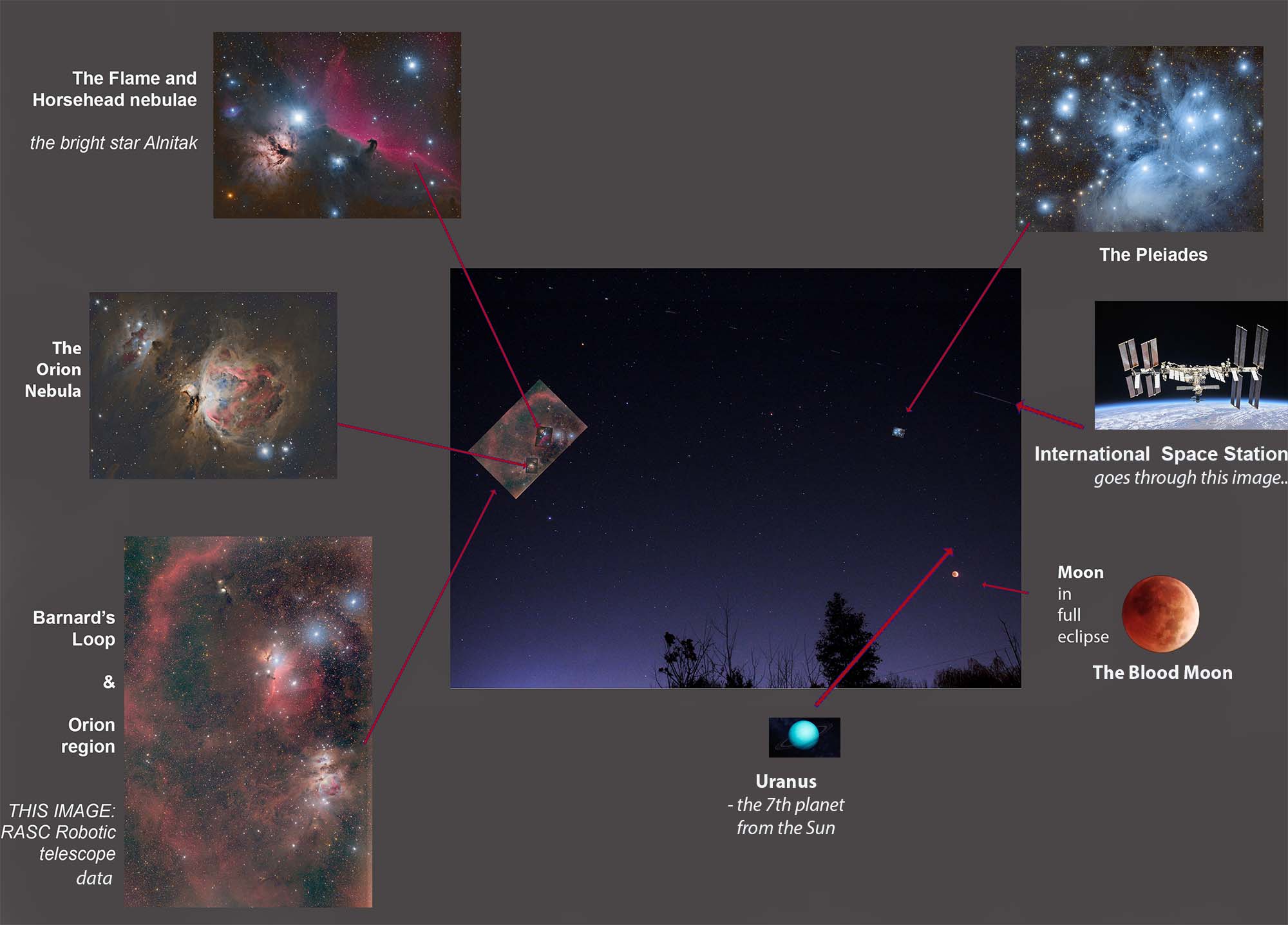 |
|||||
Recurrent Nova
2021 eruption imaged by RASC remote telescope Click to enlarge image
Supernova
NGC7814 (The Little Sombrero Galaxy) and Super Nova SN2021rhu %20and%20Super%20Nova%20SN%202021rhu%20-%20FINAL%20-%20with%20Pre-Eruption%20Inset%20-%20web.jpg)
|
|
Remote Telescope data -
TRIFFID NEBULA - #1
Royal Astronomical Society of Canada's facility, near Auberry, California ABOVE:
About 25 hours' worth of
Hydrogen Alpha, Oxygen III and
Sulphur II data, with two
different processing workflows
and two different crops of the
final image.
For larger views: CLICK IMAGES -----------------
Thanks to RASC, and its wholly-owned SkyNews magazine, for providing the 25-hours' worth of data that produced these images! Our remote telescope is located in the Sierra Remote Observatories, in California, high up, and toward the Nevada state line. Far, far from urban light pollution! -----------------
The instrument is a 16-inch Ritchey Chretien telescope f/8.9, with a focal length of 3550mm. The mount here is an awesome Paramount ME. The camera is an equally-awesome 16MP SBIG with narrowband filters: Ha 9 (7nm), OIII (8.5nm) and SII (8nm). The processing of this data required about 30 hours of work ... done mostly with PixInsight ... with a small amount of work later performed in PhotoShop. -----------------
NGC 7635, also known as the Bubble Nebula, Sharpless 162, or Caldwell 11, is an H II region emission nebula in the constellation Cassiopeia. It lies close to the direction of the open cluster Messier 52. The 'bubble' is created by the stellar wind from a massive hot, 8.7 magnitude young central star, SAO 20575 (BD+60°2522). This star is located inside the 'bubble' at about the 4-o'clock position. The nebula is near a giant molecular cloud which contains the expansion of the bubble nebula while itself being excited by the hot central star, causing it to glow. It was discovered in 1787 by William Herschel. The star BD+60°2522 is thought to have a mass of about 44 times that of our own Sun. |
|
Remote Telescope data -
TRIFFID NEBULA - #2
Royal Astronomical Society of Canada's facility, near Auberry, California 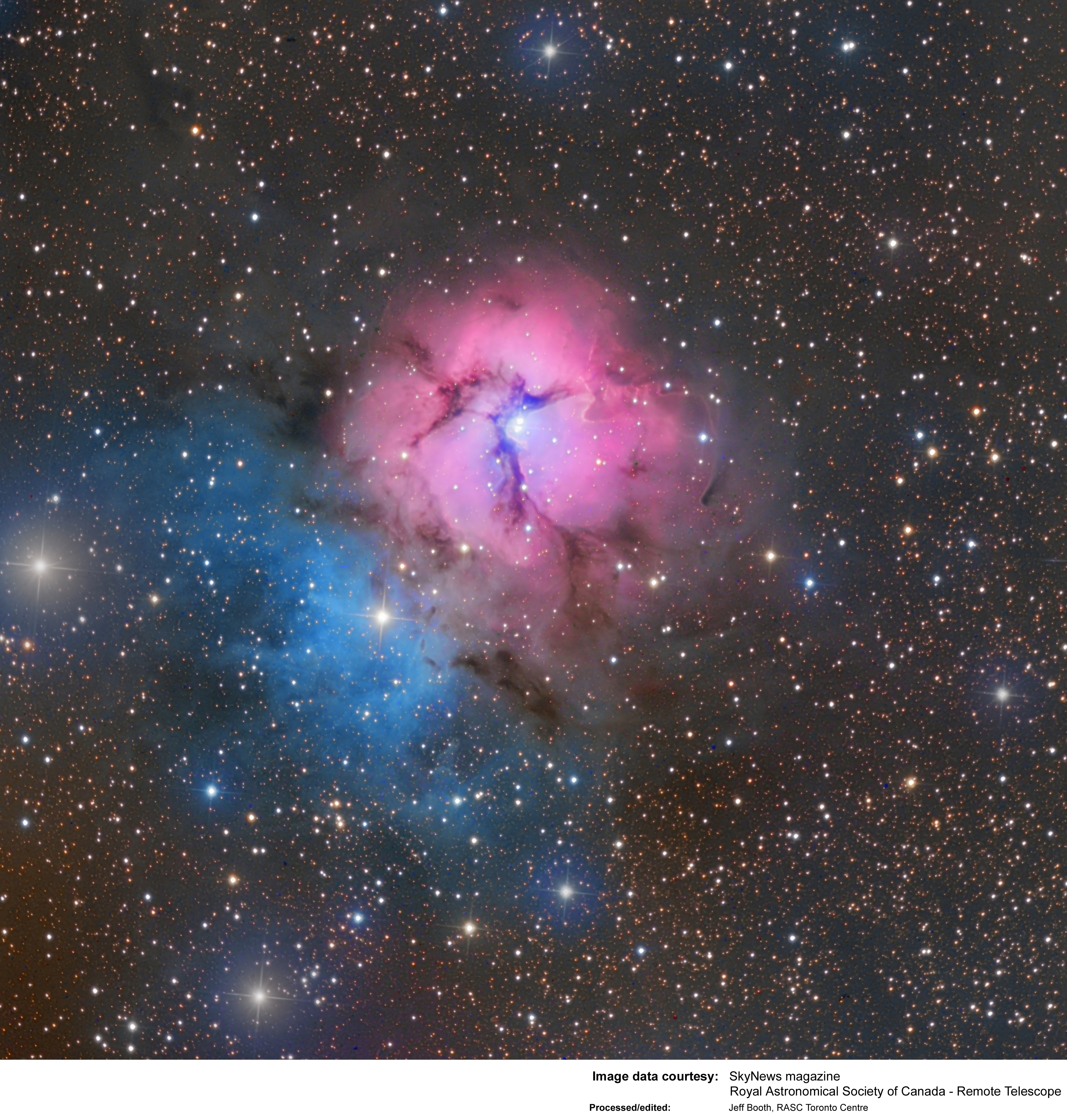 Thanks to RASC, and its wholly-owned SkyNews magazine, for providing the 8-hours' worth of data that produced this image! Our remote telescope is located in the Sierra Remote Observatories, in California, high up, and toward the Nevada state line. Far, far from urban light pollution! The instrument is a 16-inch Ritchey Chretien telescope f/8.9, with a focal length of 3550mm. The mount here is an awesome Paramount ME. The camera is an equally-awesome 16MP SBIG with narrowband filters: Ha 9 (7nm), OIII (8.5nm) and SII (8nm). There are also a set of RGB and L. This image has 8 hours' worth of Luminance, plus 80 minutes each of R, G and B. The processing of this data required about 20 hours of work ... done mostly with PixInsight. -----------------
Below, is a related image, captured by myself, at the E.C. Carr Astronomical Observatory, in 2019. I was all set up to spend several hours on this same -- but wider region of the constellation Sagittarius -- to capture not only the interesting Triffid Nebula but also its much larger neighbour, The Lagoon Nebula. I managed to collect only 4 minutes of data, in the Hydrogen alpha (Hα) wavelength (that is why it is only B&W) when clouds suddenly moved in, bringing everything to a sudden halt. Due to COVID shutdown, I have been unable to return to the observatory to finish this project. Hopefully next year ... 2022? ----------- H-alpha (Hα) is a specific visible spectral line in the Balmer series with a wavelength of 656.28 nanometres ; it occurs when a hydrogen electron falls from its third to second lowest energy level. H-alpha light is the brightest hydrogen line in the visible spectral range. It is important to astronomers as it is emitted by many emission nebulae and can be used to observe certain -- often spectacular -- features. ----------- The instrument here was a 400mm SkyWatcher Esprit f/5, on top of a Celestron CGEM mount, with a ZWO 1600 Cool camera, with the imaging sensor running at -15C. Tracking was with PHD Guiding. Processed in PixInsight. The Triffid Nebula, in the two images, is rotated very roughly, by about 180 degrees.  |
|
Newest & Oldest
Click
the RASA graphic, below, to see the latest
addition to the family's astro toolbox. It's a RASA 11" with a CGX-L mount. The mount will support a 75-pound payload. This instrument arrived back in August -- but is still waiting for special light filters, some from China, others from Germany. Hopefully, soon we'll get "First Light" with this f2.2, 620mm behemoth ... By the way ... this is not an optical telescope -- you cannot look through it! All of its operations and all of its work is done through linked computers, either wirelessly or via a cable connection. In the lower, right corner of that image, there is a small, entry-level telescope. That was my first instrument, purchased when a teenager. Still have it ... but over the next few days it will be given to a young family near the top of the dark-sky Bruce Peninsula area. It's nice that it will be going to an eager-to-learn family.... so, oldest and newest in one image... that shaky, old instrument a 4.5" Newtonian reflector and, even in light-polluted skies, can easily resolve the four big moons of Jupiter and the rings around Saturn. |
| Video of Comet
Atlas Click HERE! Two hours' worth of Comet Atlas moving through the Cosmos. Imaged from our backyard. |
As the World Turns -- no really,
the world turning! Click HERE! Two hours' worth of the Earth turning. Really, watch the world rotate. Imaged from our backyard. |
The
Moon - in colour
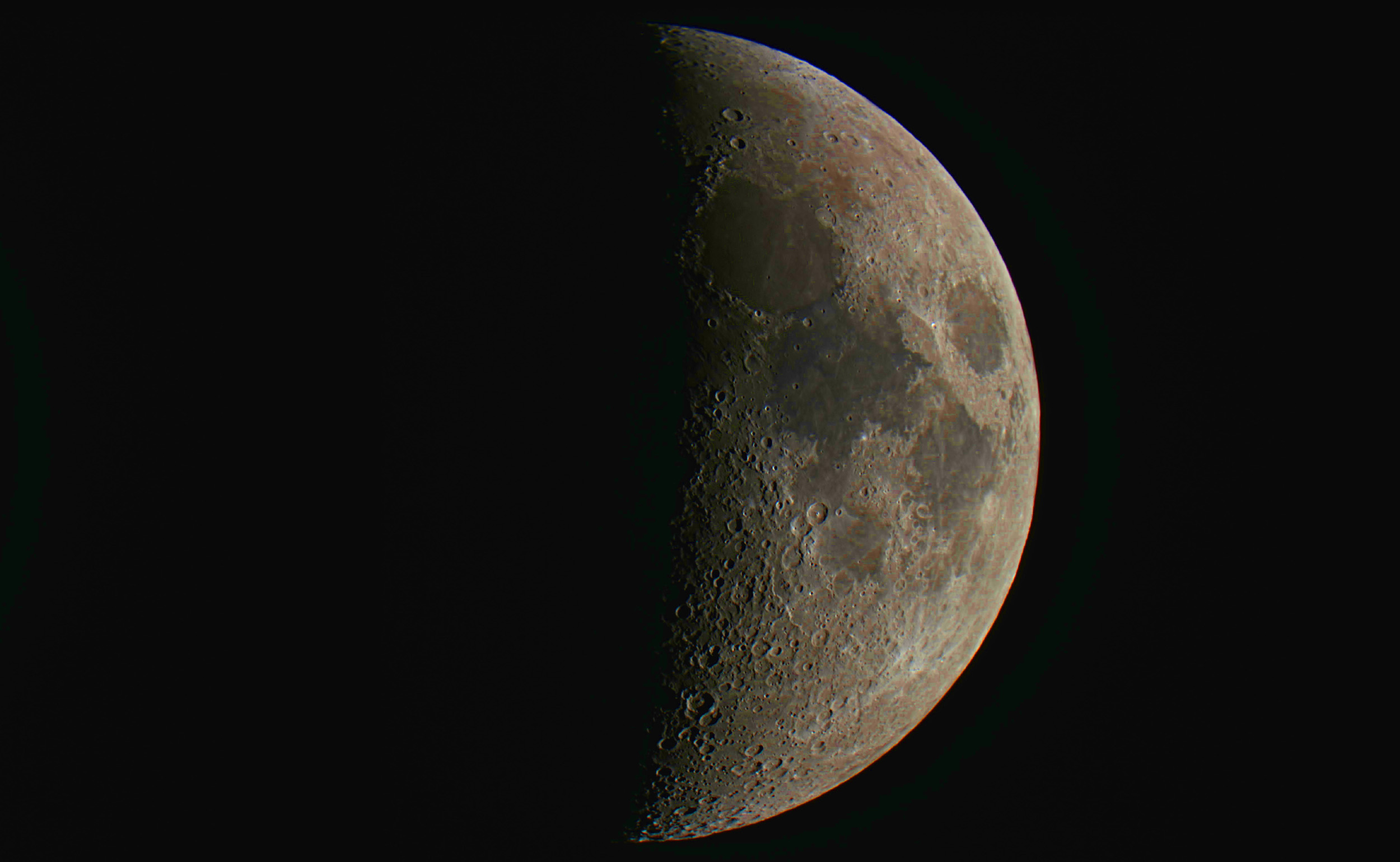 Our Moon is normally just a bright white or grayish colour, right? Well, it DOES have colour. It's just that the sunlight reflecting off it to our eyes is so very brilliant that we really can't see these colours. There is a technique, however, which allows the lunar colour palette to be revealed to us. This technique involves "stacking" several Moon images on top of each other using special software. Each image contributes just a little bit of colour to the final "stacked" image. This lunar image represents 109 photographs. You can easily see shades of grey and lots of browns. Technical: Camera: Canon T5i Telescope: Celestron Edge HD 8-inch, with a focal reducer, providing a focal length of 1,725mm. Mount: Celestron CGEM. Software used, in order: Planetary Imaging PreProcessor (PIPP), RegiStax, PixInsight, PhotoShop. The waxing Moon is 44% illuminated here. Best 109 images of 218 taken. (50% cutoff, in Planetary Imaging PreProcessor) |
|
Fun
in the Sun -- and WITH
the Sun
Solar
Transit of the International Space Station - video
The International Space Station goes around the Earth about every 90 minutes, or so. Every once in a while, depending on where you are, it crosses the Moon or the Sun. These crossings are called "transits". Recently, a solar transit was predicted for exactly where I live. So, I set up to try and image it.... It's altitude was just over 400km. And, the ISS is just over 100m in width ... Expressed differently, this was like photographing something about 100m long that is in Buffalo, N.Y., when you are in New York City -- it's that far! Also, it was moving at close to 7 km/second. EQUIPMENT: - Celestron Edge HD 8" telescope - With a 0.7x focal reducer, meaning the effective focal length was 1,725mm. - Mount was a Celestron German Equatorial - Camera: Canon T5i - Full-aperture solar filter (you must never look at the Sun without proper, safe solar filter protection!) - Processed with PhotoShop and Win Movie Maker. ----------------------------------------------------------------------------
The
Sun & the Storm
Click
the photo to see the video
A few days ago, we were imaging a vast field of sunspot activity -- just when an intense storm cell moved in. Here is a short video of that intense storm cell moving in -- fast -- blocking out what was a clear Sun. In seconds -- you can see the sun, viewed through a special solar filter, go from clear, unobstructed disc -- with a huge area of sunspot activity -- to completely dark. |
COVER
PHOTO !
The Wizard Nebula
The Royal Astronomical Society of Canada's choice for June/July 2021 ( See if you can find the Wizard ! He's right here... ) What a great bit of good news ... one of my images has been selected to grace the cover of the Royal Astronomical Society of Canada's Journal, for June 2021. Wow! What a rush ... The image is of the Wizard Nebula, in the constellation Cepheus. This nebula is a favourite for astronomers in the northern latitudes. It is best imaged in summer. This image represents a total of about three hours of exposure using Hydrogen alpha and Oxygen III filters and a ZWO 1600 cool monochrome camera, with the sensor running at -15C. This data was collected at the North Frontenac Dark Sky site, in eastern Ontario. Processing was with Pixinsight. Telescope was a SkyWatcher 80ED, f7.5, running on a Celestron CGEM mount. Guiding by PHD. Known also by its astronomical designation, NGC 7380, this open cluster of stars is circumpolar. It was discovered in 1787 by Caroline Hershel. It is extremely difficult to resolve visually. The star cluster spans about 20 light years. For those interested in stellar cosmology, this target is rich ... with at least one binary, two massive O-types and a number of variable stars. At least 14 stars are pre-main-sequence, while 17 are main sequence, just like our own Sun. There is another appearance
of The Wizard Nebula, further down on this
webpage.
|
|
SUNRISE
ANNULAR ECLIPSE
A different perspective - all images by Theresa O'Connor --------------------------------------------------------------------------
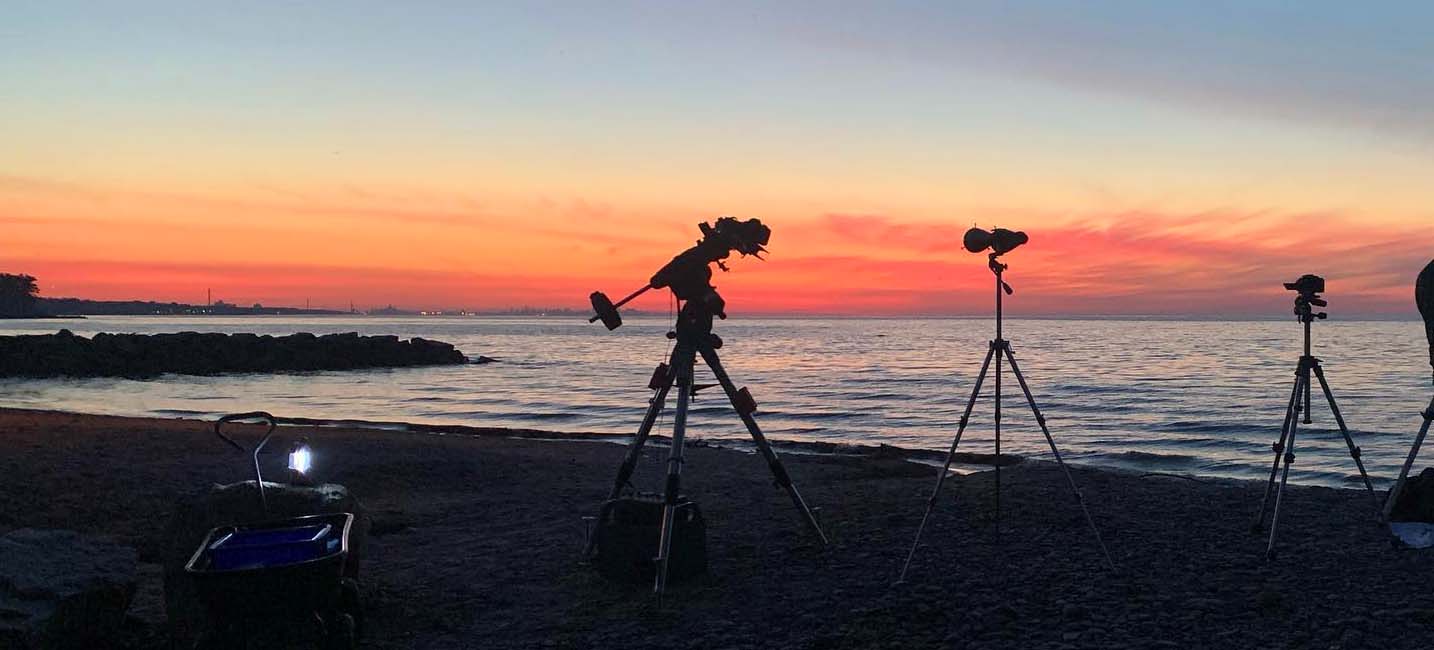 WAITING: In all, there were about 50 people gathered at the water's edge to witness this unique alignment of our solar system, where the Sun and the Moon and the Earth line up just perfectly .... We are looking 56 degrees ENE here -- precisely where the eclipsed Sun will rise. That built-up area, to the left of the equipment, is part of the Greater Toronto Area.  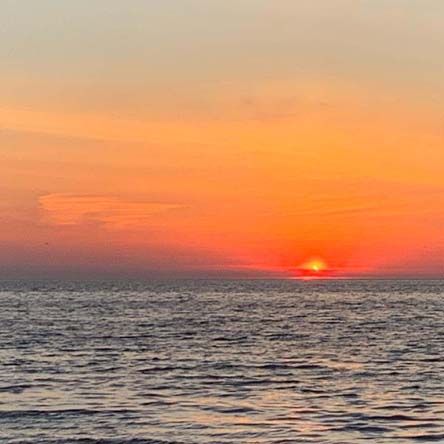
 For larger images, please click on them. IT BEGINS: A dense band of clouds -- right on the horizon -- denied us a perfect view of the rising, eclipsed Sun. However, it was still spectacular to witness this. LEFT: You can make out the annular Sun, with the dark shape of Moon in front of it. CENTRE: The exposed limbs of the Sun get noticeably brighter as it rises, still bedevilled by that low band of cloud. RIGHT: Above the cloud, at last. In this image the Sun and Moon are less than half a degree above the water horizon. About an hour later, it was all over. 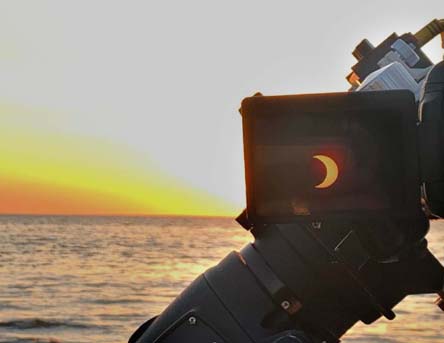 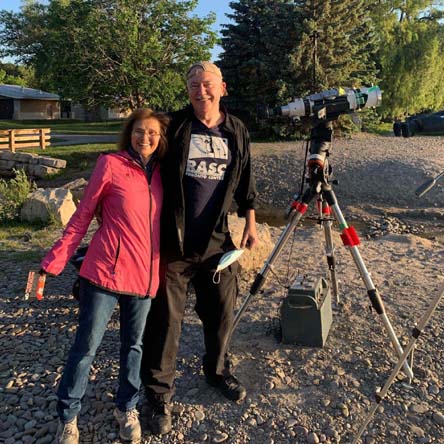 LEFT:
The view through a special, solar-safe
telescope.
RIGHT: Connie and Jeff and their "Eclipse Hug." Last time they did this was in Tennessee, in 2017, during the total eclipse of the Sun. |
|
Widefield within the
constellation Orion
 Click image to enlarge: This image is a mosaic of three panels within the Winter constellation Orion. This region, of the Northern sky, is always popular with astrophotographers -- for obvious reason. This field of view actually has 23 nebulae in it. The larger nebulae are, from left to right, The Flame Nebula, the Horsehead Nebula and the massive Great Orion Nebula. Formally, their scientific names are NGC2024/Sh2-277, Barnard 33 and Messier 42. The Horsehead Nebula is known as a 'dark' nebula. Also, it is worth pointing out that this region is rich in dust and you can easily see it here, illuminated by reflected light from the stars. This data was collected from our backyard, in heavily light-polluted Oakville, Ontario, Canada, during COVID lockdown. Each of the three panels has approximately one hour's worth of exposure. The light is filtered Hyrogen alpha. Camera used was a ZWO 1600 cool, with the sensor running at -15C. Mount was a Celestron CGEM. Processed with PixInsight. * * * * * It seems this mosaic caught the attention of the editor of the Royal Astronomical Society of Canada's editor ... from the December 2021 edition: |
Comet NEOWISE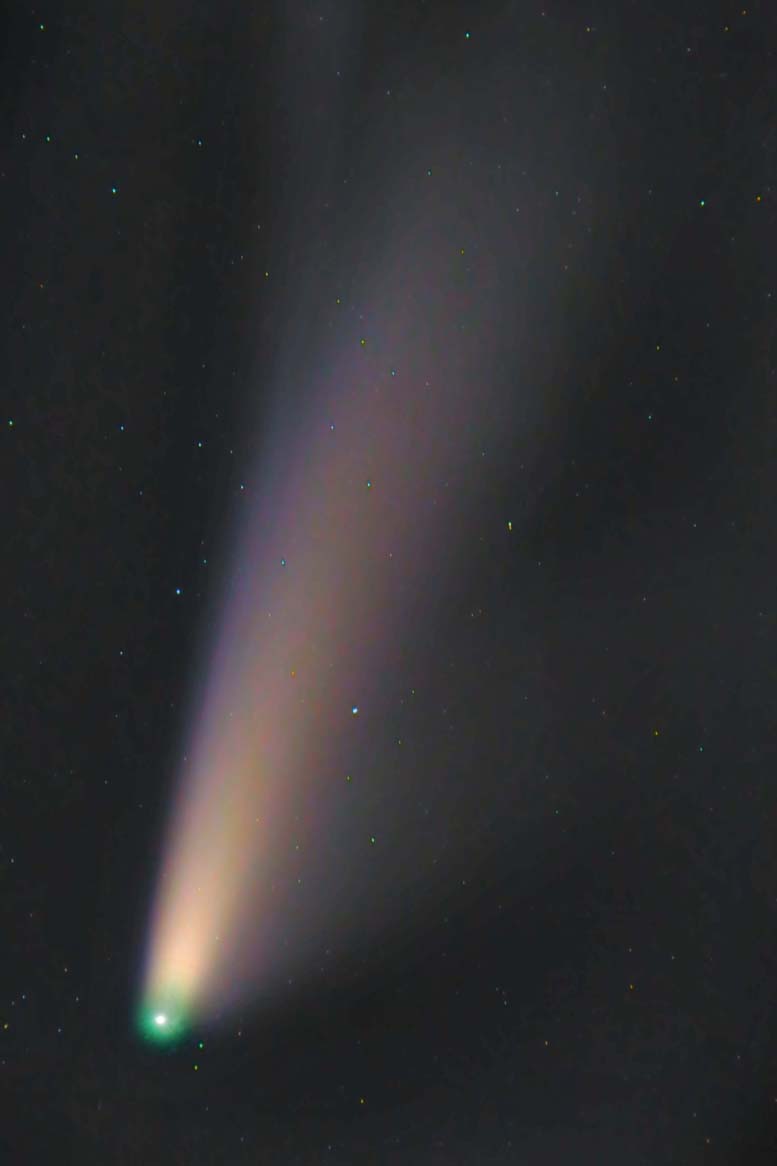 Click image to enlarge: Comet NEOWISE was a treat, during much of 2020. It wasn't expected to be a gorgeous showstopper -- but it certainly became one. In fact, it became what is described as a once-in-a-lifetime comet. This image was captured in the very dark skies in the mid-North of Ontario, Canada. If you look at the larger version of the image (click on it) you can actually see some detail in the comet nucleus. This comet, as it came into our solar system, was visible in the predawn hours then, later on as it left our solar system, it became an evening comet. Comet C/2020 F3 (NEOWISE) was discovered on March 27, 2020 – not from Earth’s surface – but from by a space observatory 326 miles (525 km) above Earth’s surface. It’s named for its discoverer, the Near Earth Object Wide-field Infrared Survey Explorer (NEOWISE) , which was launched by NASA in 2009. Comet NEOWISE was closest to the sun on July 3, 2020, passing at about 26.7 million miles (43 million km) from the Sun, or a bit closer than the average distance from the sun to Mercury. Unlike some comets, it survived the close encounter with our star and went on to become widely seen by binocular observers and astrophotographers. Imaged through a SkyWatcher 600mm f7.5 doublet refractor, using a Canon T5i. Mount was a Celestron CGEM. Data processed in PixInsight and PhotoShop. There are several other Comet NEOWISE images lower on this webpage. |
| Conjunction of Saturn &
Jupiter The eyepiece view - 2 planets and 8 moons -- all at the same time 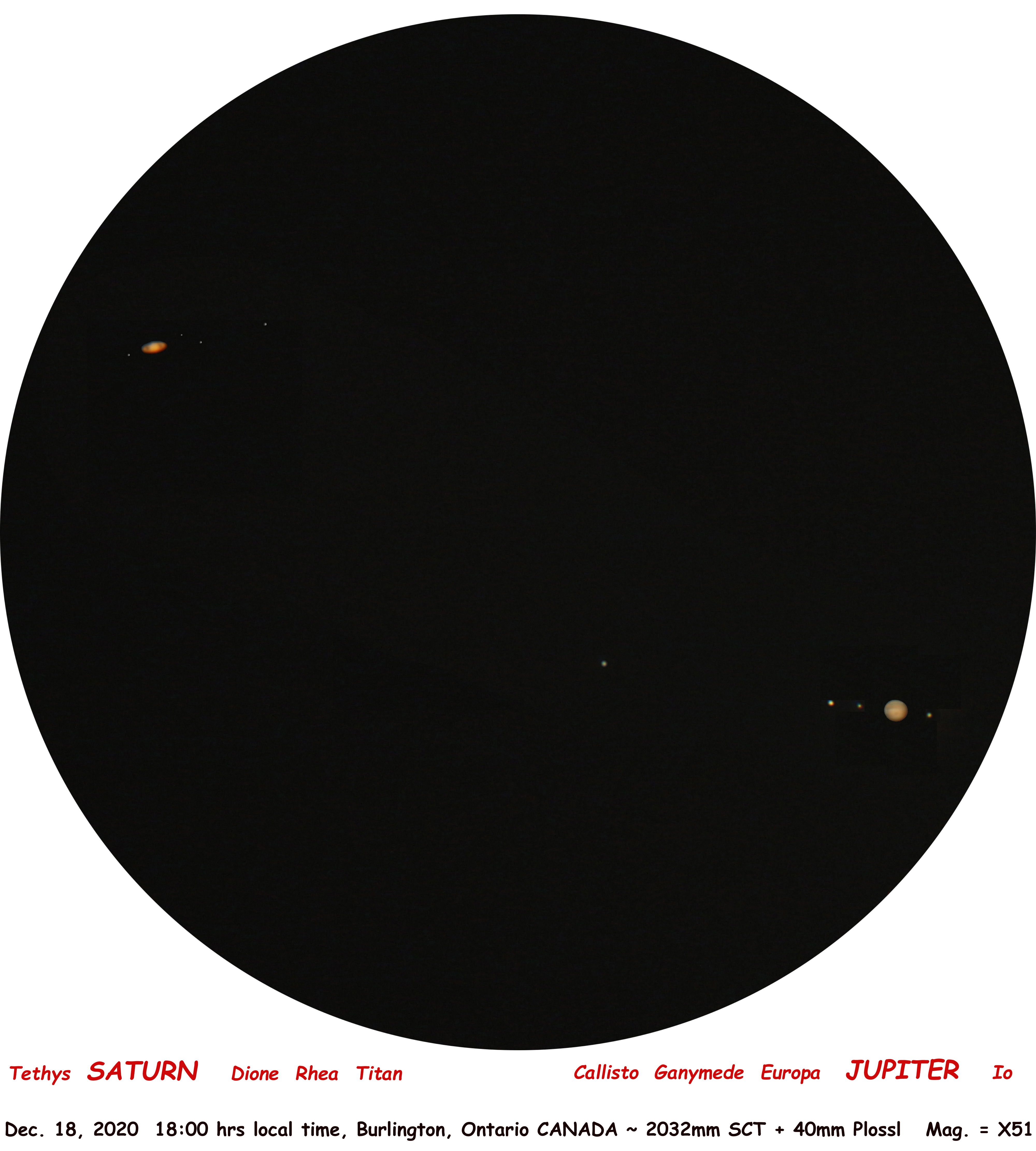 The 2020 conjunction of the giant planets Saturn and Jupiter is a remarkably rare event. These gas giants line up like this only once every 400 years or so. This image shows what a group of astro types saw when they looked through the eyepiece of a Schmidt–Cassegrain telescope, chosen because of its high magnification. Of the individuals who witnessed this, nobody had ever seen two planets at the same time in an eyepiece -- it is that rare. This data was collected three days before the actual closest approach of the planets, because heavy cloud moved in at the time of the closest alignment. We could easily see the four Galilean moons of Jupiter and we did, surprisingly, get to see Saturn's largest moon, Titan, visually. It was when longer camera exposures were inspected that we discovered we actually had four moons of Saturn captured. So ... in one eyepiece, we had two planets and eight moons. Once-in-a-lifetime experience ... or, perhaps once in 10 lifetimes. |
|
5-Panel Mosaic - in Cygnus
Extremely wide-angle view within the constellation Cygnus (the Swan) 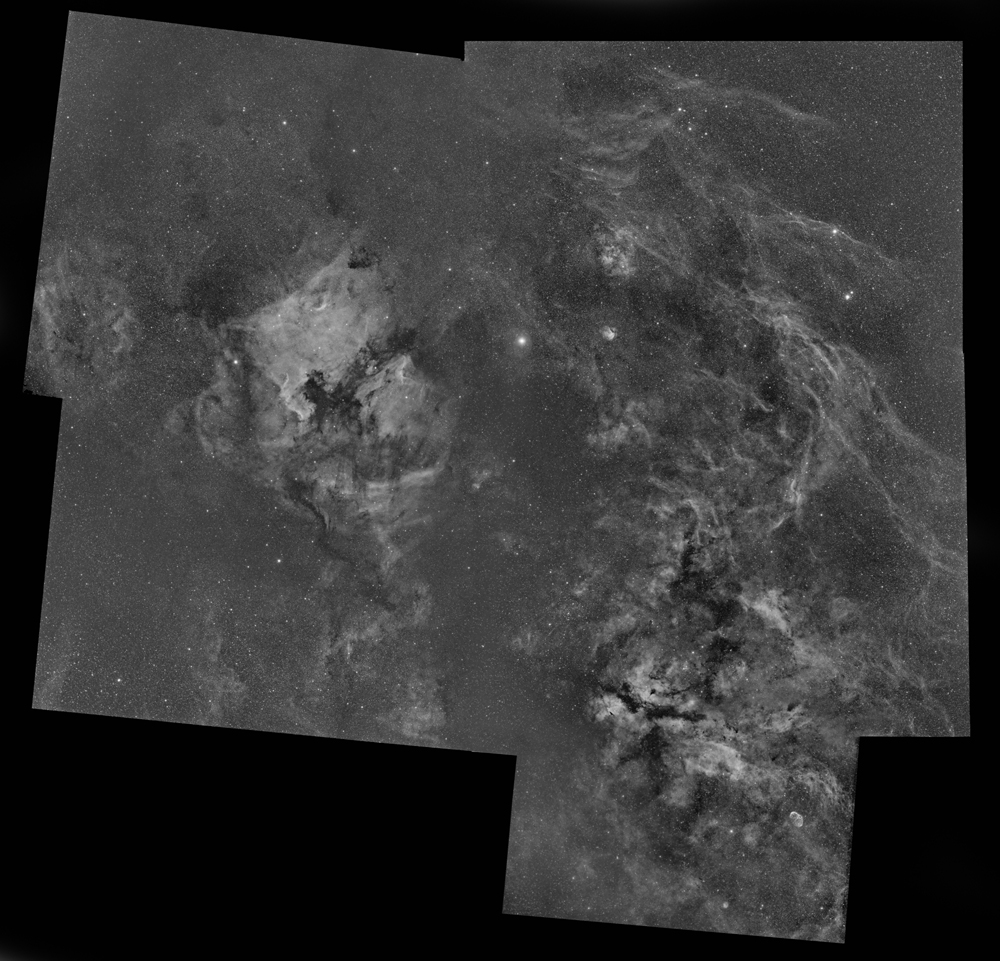 Click for the full-size image. Lots of details, lots of stars. This
image wasn't really expected. This was
only meant to be a test of creating a mosaic
from multiple images.
You can easily see the North America Nebula, to the left, with the Pelican Nebula immediately to its right. You can see the brightest star in the constellation, called Deneb (Alpha Cygni), just to the right again. Lower down, you can see the Crescent Nebula, looking like a floating brain in space. And lots and lots of other reflection nebulae, dust clouds and countless stars. Near the bottom right, you will see the bright star Sadr (Gamma Cygni), 3rd brightest in the constallation ... the region more closely around this star can be seen, in colour, immediately below this description.... When it comes to this kind of astro imaging, that is a vast tract of the cosmos. The image is roughly 15-degrees X 15-degrees and along the plane of the Milky Way, our home galaxy. The technology behind the creation of this image is complex, as each panel has to be precisely created, with a small computer in the telescope-and-mount controlling the tracking of the telescope and its specialized camera and a second, larger computer, checking on the smaller computer and constantly making minuscule corrections to its movement, in both Right Ascension and Declination. Then, in processing, the panels have to be matched with extreme accuracy. As these data were really only collected for a test, which was a clear success, through a Hydrogen alpha filter. So-called Ha filters, in isolation, produce these Black & White images. ------------------------- This image was actually selected by SkyNews Magazine as Runner Up for one of its Photo of the Week contests. (April 12, 2021) Click here to see a screen capture of the SkyNews announcement: 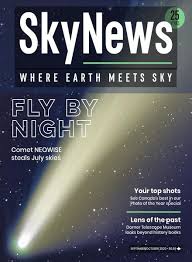 |
|
Sadr Region - in Cygnus
Wide-angle view of the 12 - 4-Panel Mosaic- Gygnus - 1000pxf the Milky Way around the bright star Sadr. 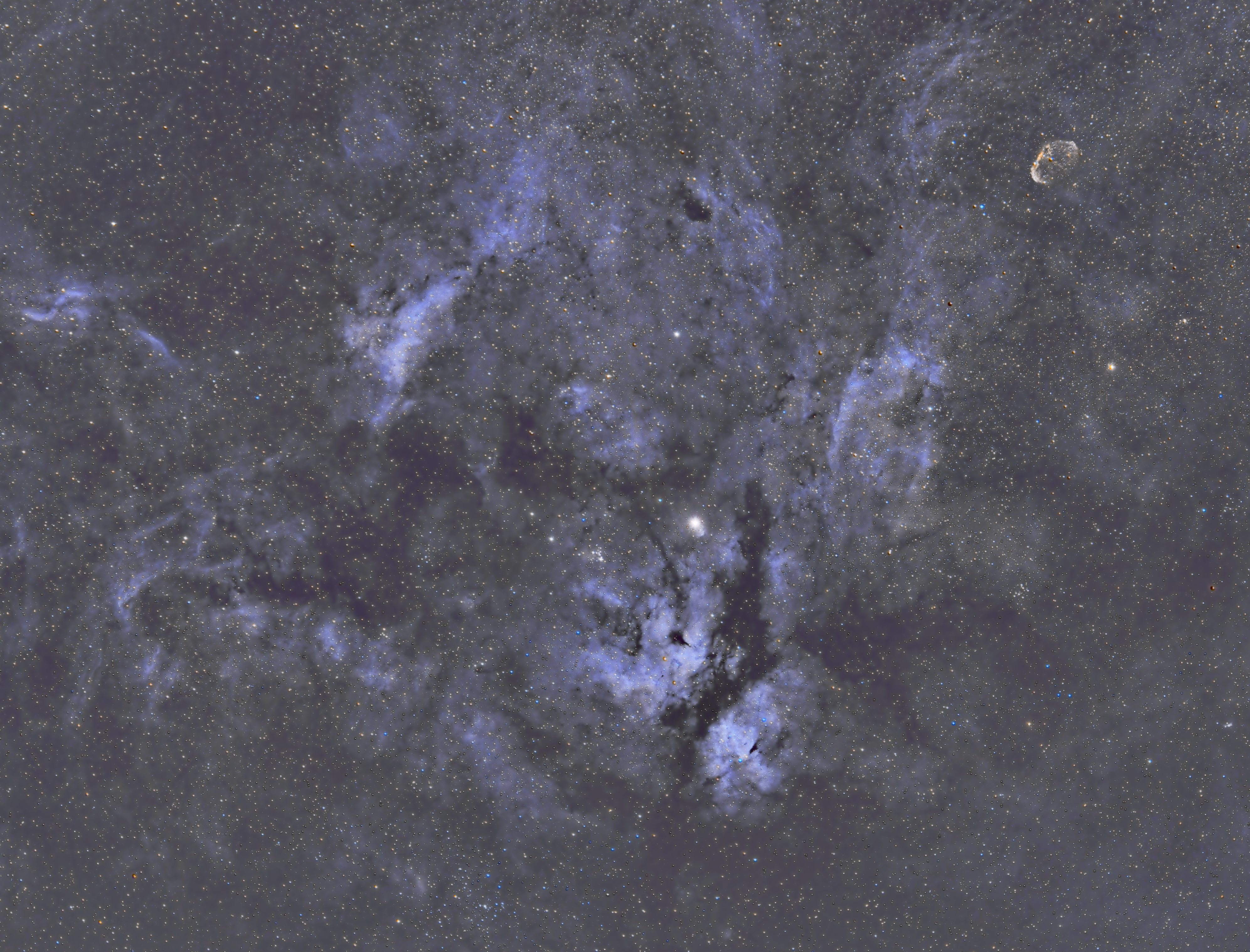 This
view is of a huge area of sky, roughly about
9-degrees wide by 5-degrees high.
Imaged from the E.C. Carr Astronomical
Observatory
---Image is of the region around the bright star Sadr. Sadr is the "hen's chest" star, in the centre of Cygnus, also known as The Swan. It is also in the centre of the five-star asterism known as the Northern Cross. The "Hen's Chest" name comes from its translation from the Arabic form of the star's name. Lots going on in this region, after all it is smack in the Milky Way. Lots of dust, tons of stars, lots of reflection nebulae -- and, of course, the brain-like Crescent Nebula floating there ... top right. --- Imaged with a ZWO cooled camera. using Hydrogen alpha, Oxygen III and Oxygen III filters (HOO combination). In total, about four hour's worth of exposure. No telescope here ... it was with a 135mm f2 camera lens. All mounted on a CGEM. There is another, similar image, farther down on this webpage. It is in Hydrogen alpha light only, which produces a Black & White image. |
|
Auroral display
Looking North, from the deck on the main accommodations at the E.C. Carr Astronomical Observatory In
early July 2019, I was imaging from the Tony
Horvatin Observatory (THO) , which is part of
the E.C. Carr Observatory (CAO).
Was so focused on the imaging I was working on -- and so focused on a small part of the Eastern sky that I was working in -- that I did not notice this Auroral display building to the North.
|
|
Comet NEOWISE - C/2020 F3
Once-in-a-lifetime comet surprises everyone with spectacular show
|
|
The Heart & Soul
nebulae plus
the nearby Double Cluster
Hydrogen, Oxygen, Sulphur light filters 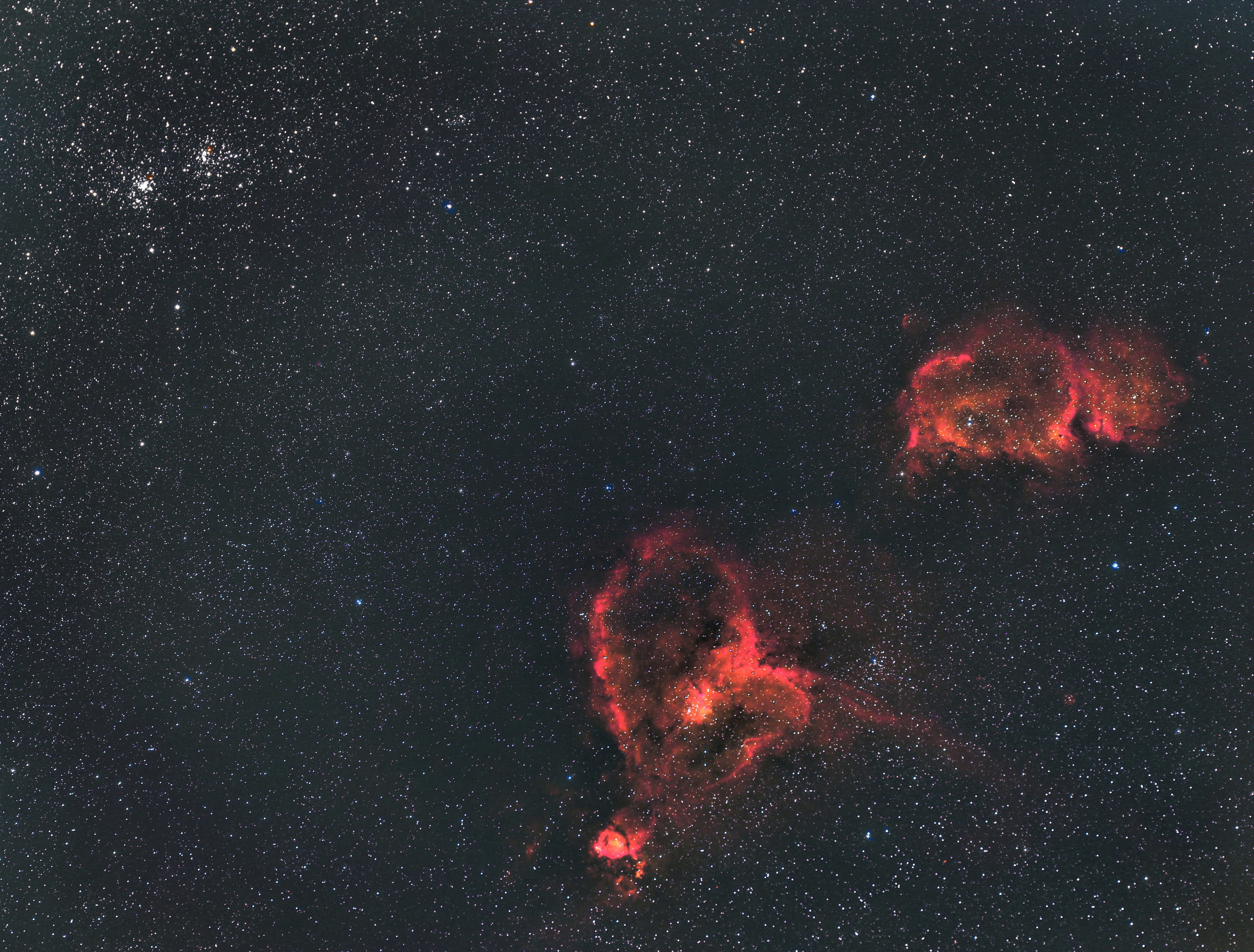 The HEART NEBULA (IC 1805, Sharpless 2-190), lies 7500 light years away from Earth and is located in the Perseus Arm of the Galaxy in the constellation Cassiopeia. It was discovered by William Herschel on 3 November 1787. It is an emission nebula showing glowing ionized hydrogen gas and darker dust lanes. The brightest part of the nebula (a knot at its western edge) is separately classified as NGC 896, because it was the first part of the nebula to be discovered. The nebula's intense red output and its morphology are driven by the radiation emanating from a small group of stars near the nebula's center. This open cluster of stars, known as Melotte 15, contains a few bright stars nearly 50 times the mass of our Sun, and many more dim stars that are only a fraction of our Sun's mass. Westerhout 5 (Sharpless 2-199, LBN 667, SOUL NEBULA) is an emission nebula located in Cassiopeia. Several small open clusters are embedded in the nebula: CR 34, 632, and 634 and IC 1848. The object is more commonly called by the cluster designation IC 1848. STAR CLUSTERS are very large groups of stars. Two types of star clusters can be distinguished: globular clusters are tight groups of hundreds to millions of old stars which are gravitationally bound, while open clusters, more loosely clustered groups of stars, generally contain fewer than a few hundred members, and are often very young. Open clusters become disrupted over time by the gravitational influence of giant molecular clouds as they move through the galaxy, but cluster members will continue to move in broadly the same direction through space even though they are no longer gravitationally bound; they are then known as a stellar association, sometimes also referred to as a moving group. The two globular clusters shown here are in the constellation Cepheus, which is next to the constellation Cassiopeia. Technical data: - Imaged from the Tony Horvatin Observatory, within the E.C. Carr Astronomical Observatory complex, in Ontario, Canada. - ZWO monochrome astronomical camera, sensor cooled to - 15C - 135mm f2 lens - Celestron German Equatorial mount - Tracking was only the native tracking software, that is no 2nd-level PHD guiding ... this thanks to the short focal length. A very precise polar alignment was done beforehand, though, using a Celestron Polar Finderscope - about 30 minutes in Hydrogen alpha light - about 30 minutes in Oxygen III light - about 30 minutes in Suphur II light - with all calibration frames - Data captured with Sequence Generator Pro - focus achieved using Half Flux Radius readings on stars, within Sequence Generator Pro - Data processed in PixInsight |
|
Supernova remnant - The Veil
Nebula complex
Including the Eastern Veil, the Western Veil and Pickering's Triangle 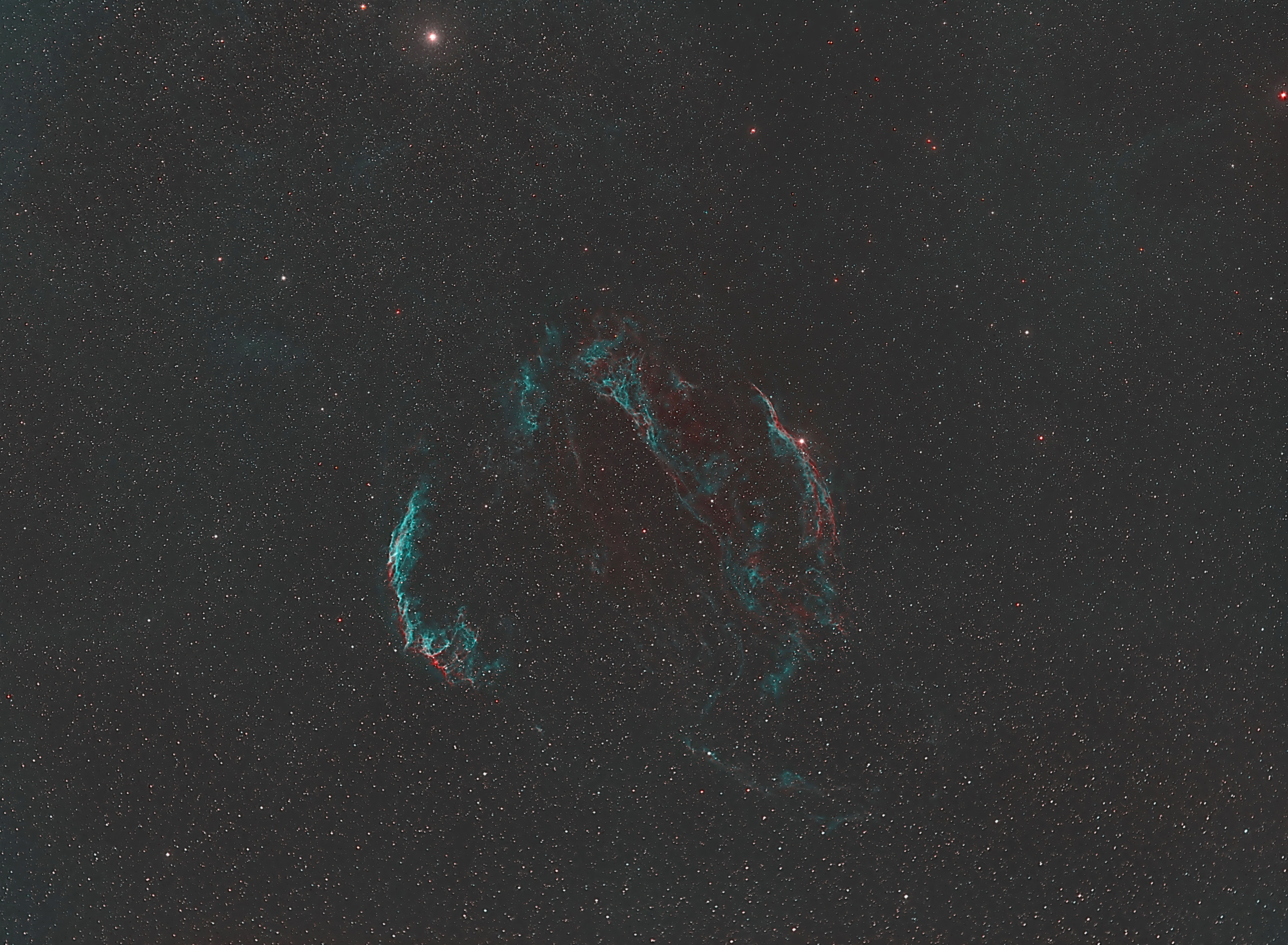 Another summer treat for Northern latitudes is this supernova remnant, the Veil Nebula, in the constellation Cygnus. It is a huge cloud of heated and ionized gas and dust. This area is about six times the size of a full Moon and is about 2,400 light years away from Earth. The diameter of this nebula is about 130 light years. This is a supernova remnant (SNR): The structure resulting from the explosion of a large star. It is bounded by shock waves and consists of ejected material expanding from the explosion and the interstellar material it sweeps up and shocks along the way. Supernova explosions result when either a massive star runs out of fuel, then collapsing inward due to its own gravity to form a neutron star or a black hole, or a white dwarf star may accrete material from a companion star until it reaches a critical mass and undergoes a thermonuclear explosion. Technical data: - Imaged from the Tony Horvatin Observatory, within the E.C. Carr Astronomical Observatory complex, in Ontario, Canada. - ZWO monochrome astronomical camera, sensor cooled to - 15C - 135mm f2 lens - Celestron German Equatorial mount - Tracking was only the native tracking software, that is no 2nd-level PHD guiding ... this thanks to the short focal length. A very precise polar alignment was done beforehand, though, using a Celestron Polar Finderscope - about 45 minutes in Hydrogen alpha light - about 45 minutes in Oxygen III light - with all calibration frames - Data captured with Sequence Generator Pro - focus achieved using Half Flux Radius readings on stars, within Sequence Generator Pro - Data processed in PixInsight (high, thin cloud bedevilled this data collection, resulting in a degraded final image) |
North America & Pelican
nebulae
Cosmic delights at the tail of The Swan  The large constellation Cygnus -- The Swan -- cuts across a wide swath of the Milky Way, our home galaxy. As a result of this, this region of our sky is rich in deep space delights. Here are some of them.. The North American Nebula gets its name from its uncanny resemblance to the shape of the North American continent. The Pelican Nebula, just to the right of the North America Nebula gets its name from its resemblance to a pelican. The dust and reflected light across this vast region make for an interesting image. In all, this image is the equivalent of about 6 Full Moons wide, by about 10-12 Full Moons deep. This image represents about 90 minutes' worth of exposure in Hydrogen alpha light. Camera used was a ZWO 1600 astronomy camera, with its sensor cooled to -15C (to reduce static "noise" in the data). A 135mm f2 camera lens, set at f2.8, was used, along with a Celestron German Equatorial Mount, which moved precisely with the apparently moving sky. Over these 90 minutes of exposures, the sky rotated nearly 23 degrees -- and this computer-driven mount and imaging equipment had to stay precisely "on target" throughout the time period. Including the "calibration frames" that are required for this kind of imaging and subsequent processing, this image is the result of a PixInsight processing of a total of about 300 separate images. The bi-monthly "Journal" of the Royal Astronomical Society of Canada published this image, earlier this year. 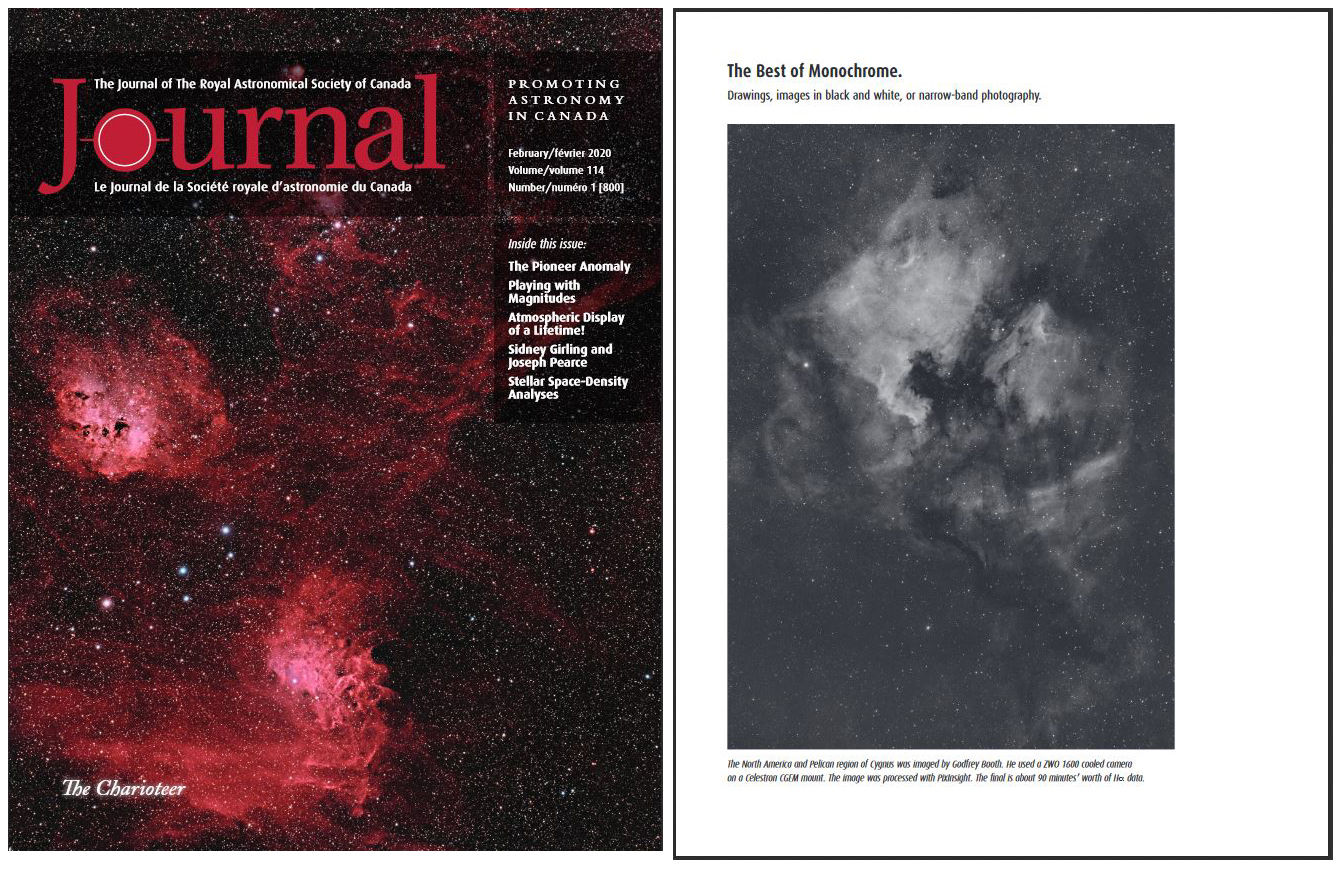
|
Elephant Trunk Nebula
A national treasure 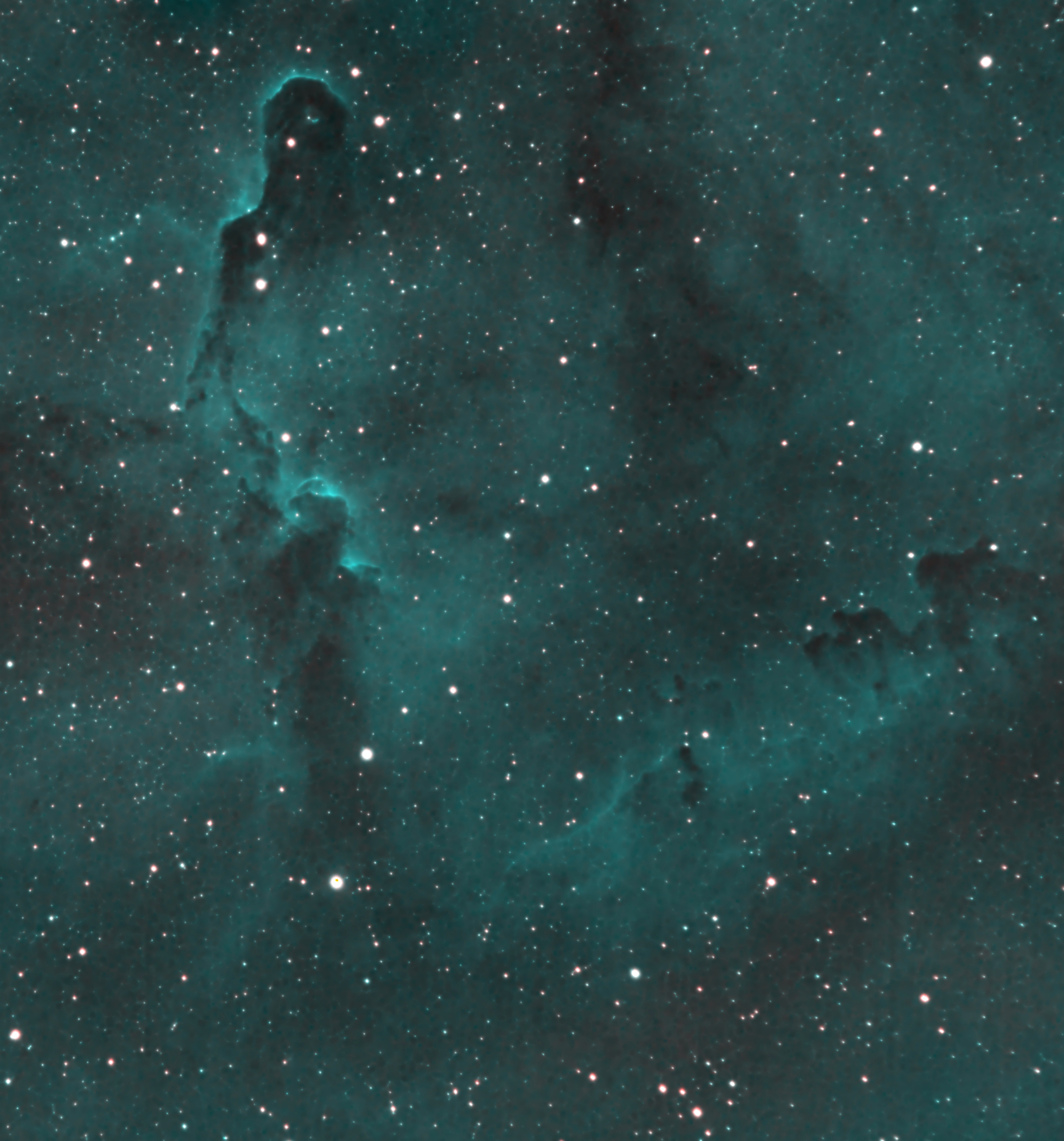 The Elephant's Trunk Nebula is a concentration of interstellar gas and dust within the much larger ionized gas region IC 1396 located in the constellation Cepeus about 2,400 light years away. The piece of the nebula shown here is the dark, dense globule IC 1396A; it is commonly called the Elephant's Trunk nebula because of its appearance at visible light wavelengths, where there is a dark patch with a bright, sinuous rim. The bright rim is the surface of the dense cloud that is being illuminated and ionized by a very bright, massive star that is just to the east of IC 1396A. The entire IC 1396 region is ionized by the massive star, except for dense globules that can protect themselves from the star's harsh ultraviolet rays. The Elephant's
Trunk Nebula is now thought to be a site of
star formation, containing several very young
(less than 100,000 yr) stars that were
discovered in infrared images in 2003. Two
older (but still young, a couple of million
years, by the standards of stars, which live
for billions of years) stars are present in a
small, circular cavity in the head of the
globule. Winds from these young stars may have
emptied the cavity. |
The David Dunlap Observatory
A national treasure 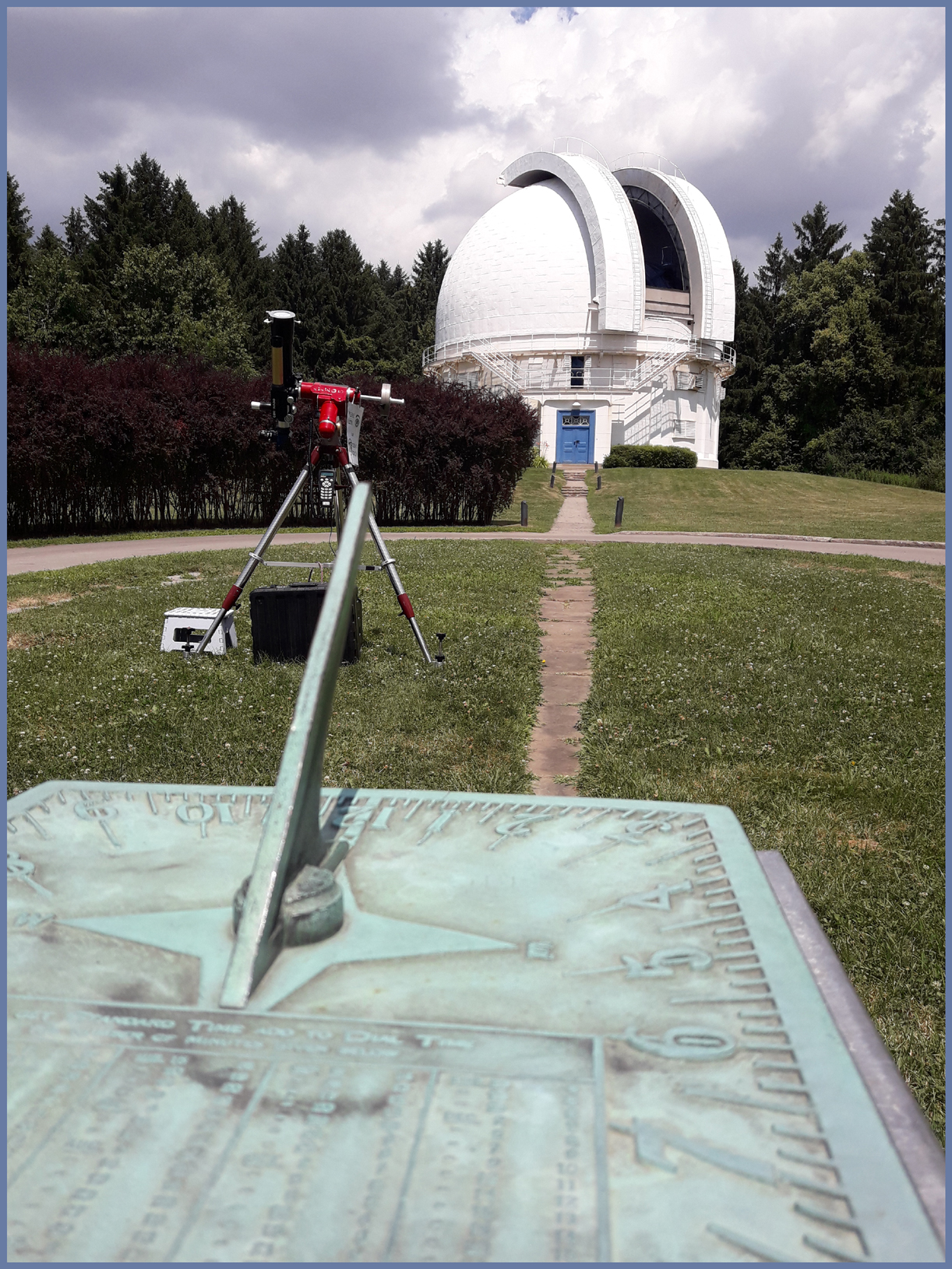 Truly, a national treasure. RASC people are often here, conducting education outreach, presenting seminars, workshops, courses, etc. And sometimes -- even running the 27-ton telescope! Currently in the works, is a proposal to offer hands-on workshops on processing astro images for people who have already collected their own raw data. Stay tuned ... The workshops will likely be held in the large administration building next to dome, and not in this image. The 74-inch telescope in this dome is spectacular ... and that is an understatment. |
|
Sadr
region, in Cygnus
 The star Sadr, found in the constellation Cygnus is located in a remarkably busy part of the Milky Way, as seen from Earth. That's Sadr, pretty well in the middle of this image. It is an Arabic name, meaning roughly "The Hen's Chest." It is also the central star in the asterism we, at northern latitudes, refer to as the Northern Cross. This image was only a test of a remote/Wi-Fi imaging rig ... 10-minutes exposure, only, of this spectacular region of our sky. This is a raw, unprocessed image. Once properly processed it will improve significantly. This data was gathered through a Hydrogen-alpha filter only, so it is going to stay black and white. Imaged from Oakville, Ontario, Canada, on a very humid night, with lots of urban light pollution. The Ha filter cuts through all that atmospheric much and allows images such as this one to happen. Also, the special astro camera had its sensor cooled to -15C during these exposures, to reduce the "noise" in the data. Apart from all the nubular reflections and dark dust regions, you can see the Crescent Nebula floating there, toward the upper right. This is a supernova remnant -- what is left of a star that blew itself up. Compared to our own star, the Sun, Sadr is an enormous star, with 12 times our Sun's mass and about 150 times our Sun's radius. Also, Sadr is emitting over 33,000 times as much energy as our own star, the Sun. |
The
Iris Nebula
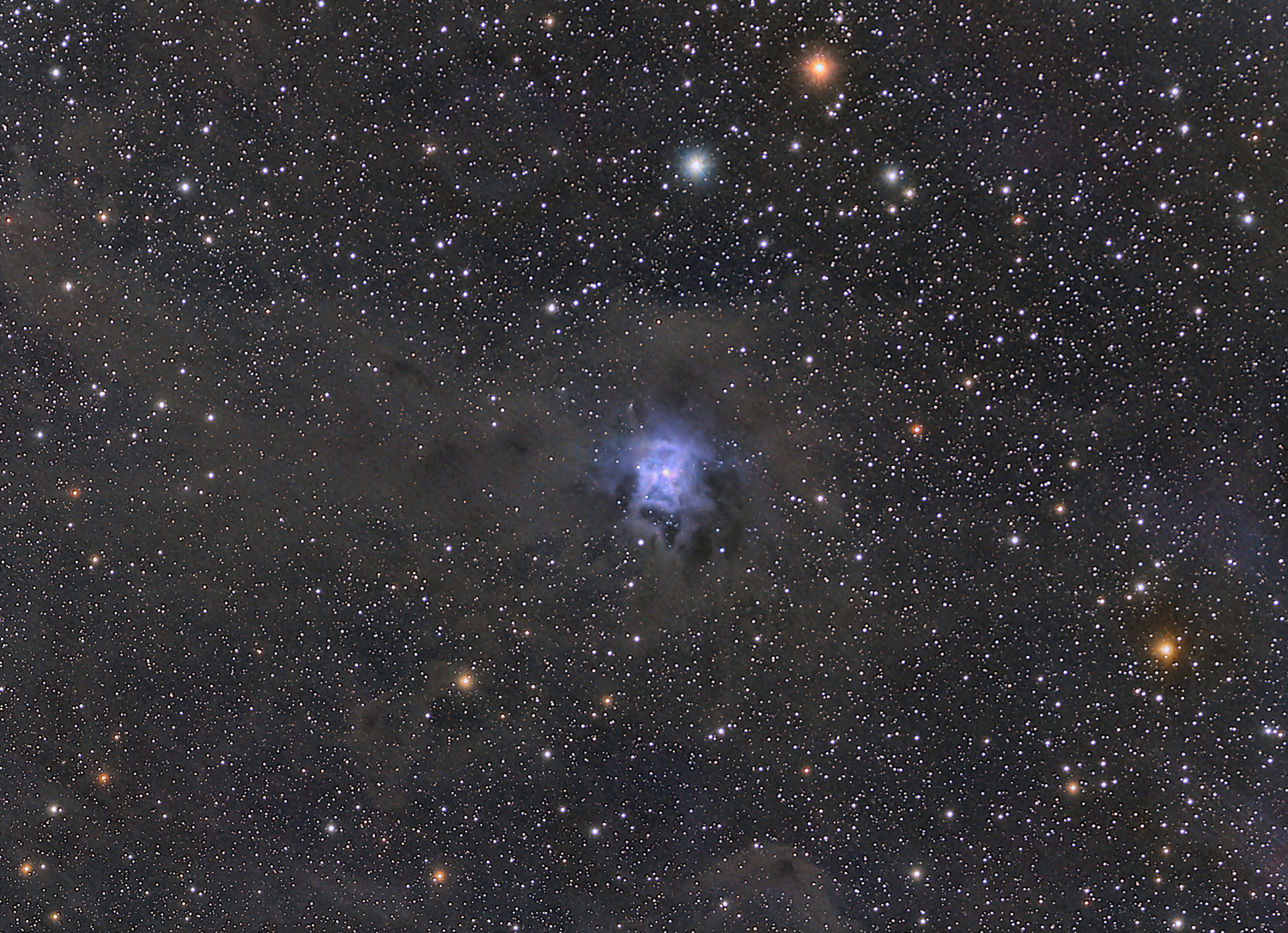 One of the prettiest Deep Sky Object the pretty Iris Nebula, found in the constellation Cepeus. It is a bright reflection nebula, lit up by a star cluster, deep within the nebula. It is about 1,300 light years from Earth and about six light years across. Also, from our Early point of view, it is about two-thirds the size of our Moon. The dust that is clearly visible in the region adds an interesting perspective to this image. Note also the different coloured stars, with the redder stars tending to be older and the blue-white ones tending to be younger and more vibrant. Data was gathered in May, while at the Carr Astronomical Observatory for some special projects. Technical details: Esprit 400mm f5 Apochromatic, ZWO monochrome cooled 1600 camera, with R, G, B and UV-IR filters. Cooled to -15C. Processed in PixInsight and PhotoShop. Celestron CGEM mount and PHD Guiding. |
The
Rho Ophiuchi Cloud Complex
May 6 8 , 2019 Click
the image to see a larger version.
The Rho Ophiuchi Cloud Complex is a challenge to image at these northern latitudes (approx. 43° N). This image was collected over two nights in early May of this year, from the viewing pad at the Carr Astronomical Observatory, in Canada. This target is extremely low in the southern sky and is only there for a short part of the year. The Rho Ophiuchi cloud complex is a dark nebula of gas and dust that is located 1° south of the star ρ Ophiuchi of the constellation Ophiuchus. At an estimated distance of 131 ± 3 parsecs, this cloud is one of the closest star-forming regions to the Solar System. This cloud covers an angular area of 4.5° × 6.5° on the celestial sphere. It consists of two major regions of dense gas and dust. The first contains a star-forming cloud (L1688) and two filaments (L1709 and L1755), while the second has a star-forming region (L1689) and a filament (L1712–L1729). These filaments extend up to 10–17.5 parsecs in length and can be as narrow as 0.24 parsecs in width. Some of the structures within the complex appear to be the result of a shock front passing through the clouds from the direction of the neighboring Sco OB2 association. Temperatures of the clouds range from 13–22 K, and there is a total of about 3,000 times the mass of the Sun in material. Over half of the mass of the complex is concentrated around the L1688 cloud, and this is the most active star-forming region. There are embedded infrared sources within the complex. A total of 425 infrared sources have been detected near the L1688 cloud. These are presumed to be young stellar objects, including 16 classified as protostars, 123 T Tauri stars with dense circumstellar disks, and 77 weaker T Tauri stars with thinner disks. The last two categories of stars have estimated ages ranging from 100,000 to a million years. The first brown dwarf to be identified in a star-forming region was Rho Oph J162349.8-242601, located in the Rho Ophiuchi cloud.[better source needed] One of the older objects at the edge of the primary star-forming region was found to be a circumstellar disk seen nearly edge on. It spans a diameter of 300 AU and contains at least twice the mass of Jupiter. The million-year-old star at the center of the disk has a temperature of 3,000 K and is emitting 0.4 times the luminosity of the Sun. ~~~~~~~~~~~~~~
The bright orange star, lower centre, is Antares, which is also known as 'The Heart of the Scorpion,' because it lies centrally within the constellation Scorpius. This image was taken using a camera and lens only, mounted on a tracking device. Specifically, it was a Canon T5i DSLR, with a 135mm f2 lens, stopped at f2.8. The camera and lens were mounted on a SkyWatcher tracker. In all, about 2-1/2 hour's worth of exposures were needed to get this image. The subs (individual exposures) were 10-seconds each, meaning about 900 individual exposures. Plus the same again -- and more -- of calibration frames, as the image processing moved forward over about a six week period. The data was processed chiefly with PixInsight. Backyard EOS was used to control the camera during data acquisition. This image is about 10° wide. See the Astrometry.net graphic, below, for more content. |
|
Widefield
image within Ursa Major
early May 2019 Click
the image to see a larger version.
This
is a widefield view of the Big Dipper stars
Mizar and Alcor, the smaller
one. This stellar pair form the bend in
the handle of the Big Dipper. In the past, naked eye observation of this pair was used to determine how good one's eyesight was. If you could see both stars, you were confirmed as having excellent vision. Also in this image is the galaxy known formally as Messier 101, but more commonly as The Pinwheel Galaxy. It is circumpolar in the Northern hemisphere. Mizar and Alcor are two stars forming a naked eye double in the handle of the Big Dipper (or Plough) asterism in the constellation of Ursa Major. Mizar is the second star from the end of the Big Dipper's handle, and Alcor its fainter companion. The traditional name Mizar derives from the Arabic المئزر miʼzar meaning 'apron; wrapper, covering, cover'. Alcor was originally Arabic سها Suhā/Sohā, meaning either the ‘forgotten’ or ‘neglected’ one; notable as a faintly perceptible companion of Mizar. Mizar, also designated Zeta Ursae Majoris (ζ Ursae Majoris, abbreviated Zeta UMa, ζ UMa), is itself a quadruple system and Alcor, also designated 80 Ursae Majoris (80 UMa), is a binary, the pair together forming a sextuple system. This is a widefield image of this part of the northern sky. Also in this is the famous spiral galaxy known formally as Messier 101, or more commonly as The Pinwheel Galaxy. ~~~~~~~~~~~~
Imaged at the Carr Astronomical Observatory, in Canada. Equipment used: Canon T5i DSLR, 135mm f2 lens, mounted to a SkyWatcher tracker. Processed with PixInsight. Total exposure: Approximately one hour, plus calibration frames. It is worth noting that this image contains a wealth of deep sky objects, as shown in this Astronometry.net plate solve: |
|
Total
Lunar Eclipse
of January 20-21, 2019 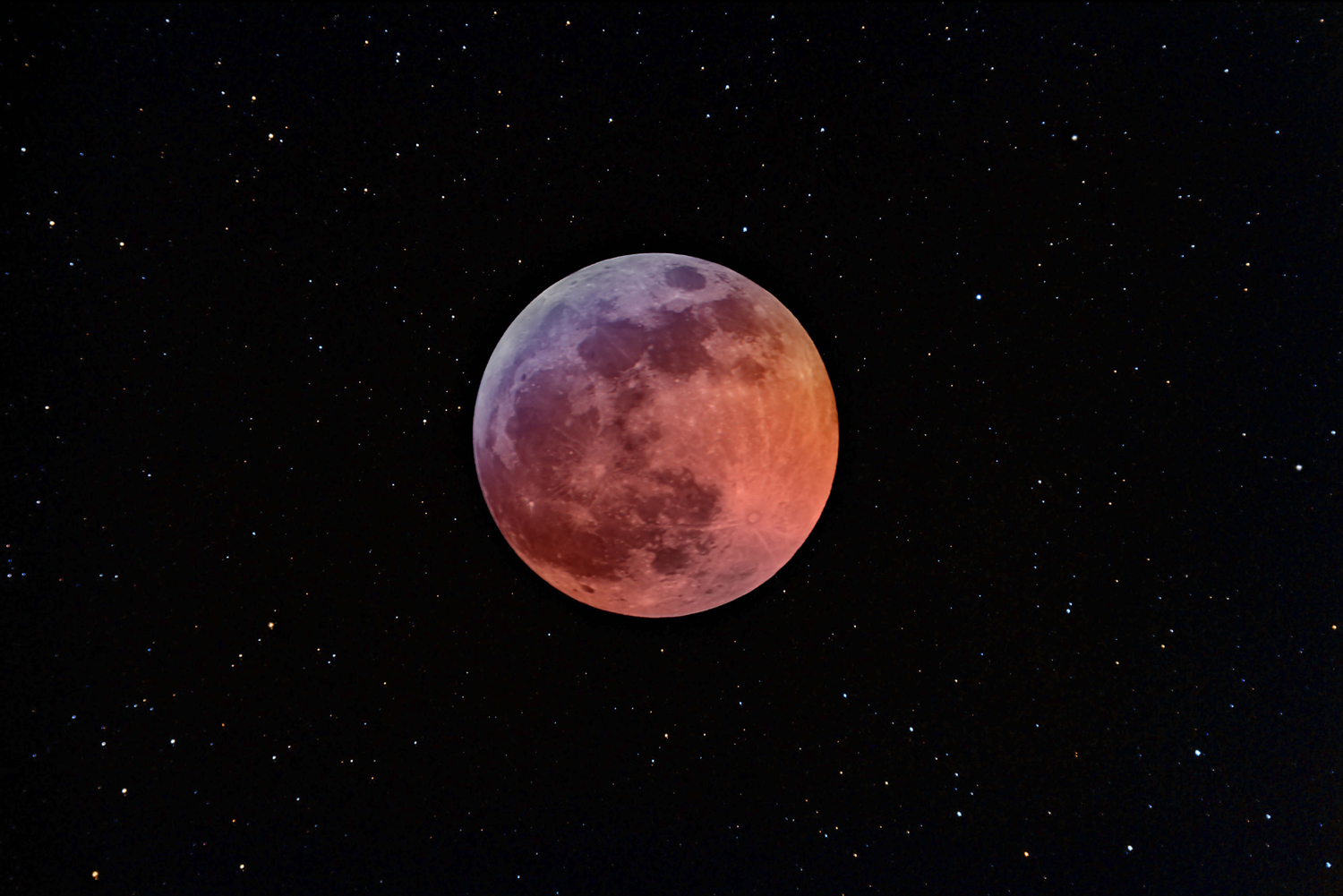 We were lucky enough to be well-positioned to witness the Total Lunar Eclipse of Jan. 20-21 recently. We saw it directly above our home, on Oakville, Canada. Even more surprising, this eclipse occurred in the middle of our Winter, when skies are normally the worst of the year -- for three months. Deep snow too. Temperature was -17.1 C. Well, as luck would have it, the evening in question was spectacularly clear. An amazing -- and very welcome -- coincidence! To make matters even more astounding, about two hours before the Total Lunar Eclipse began, the International Space Station passed directly across the the full moon. And this full moon was closer to Earth than normal, meaning it became what is called a "Super moon." This image is a composite of approximately one minutes' worth of exposure on the Moon, which was actually extremely dim during the eclipse, and four minutes' worth of exposures on the star field. Note the different colours of the stars, this is correct, they really are coloured this way. Recently, we were informed that this image was selected to be published in the 2020 calendar of the Royal Astronomical Society of Canada ... woo hoo! (and thank you!)  Video of the Total
Lunar Eclipse click here:
NB: Please set your
YouTube window to its highest quality ... go to the Sprocket icon, lower
right corner of the YouTube window and select
highest quality. Video of the International Space Station transiting the Supermoon, click here: -------------------------------------------------------------------
Here's another Moon image, a few weeks later. This was done to test some new optics that -- hopefully -- were going to produce a Moon image that would just about perfectly fit in the camera's sensor without cropping off any of the target. The Field of View calculations that supported the acquisition of the extra optics (a Celestron 0.7x Focal Reducer) would alter the focal length of a Schmitt-Cassegrain telescope from 2031mm to 1422mm with the result of getting the whole Moon in the picture. It seems to work perfectly. Bonus here is that this also applies to solar images, too, as the Moon and Sun are -- from our perspective -- just about exactly the same size when seen in our sky. I like the detail in the image, although it was blurred slightly by some stiff winds acting on the imaging rig at the time. In some of the lunar craters you can see high central peaks, which an observer cannot see visually. 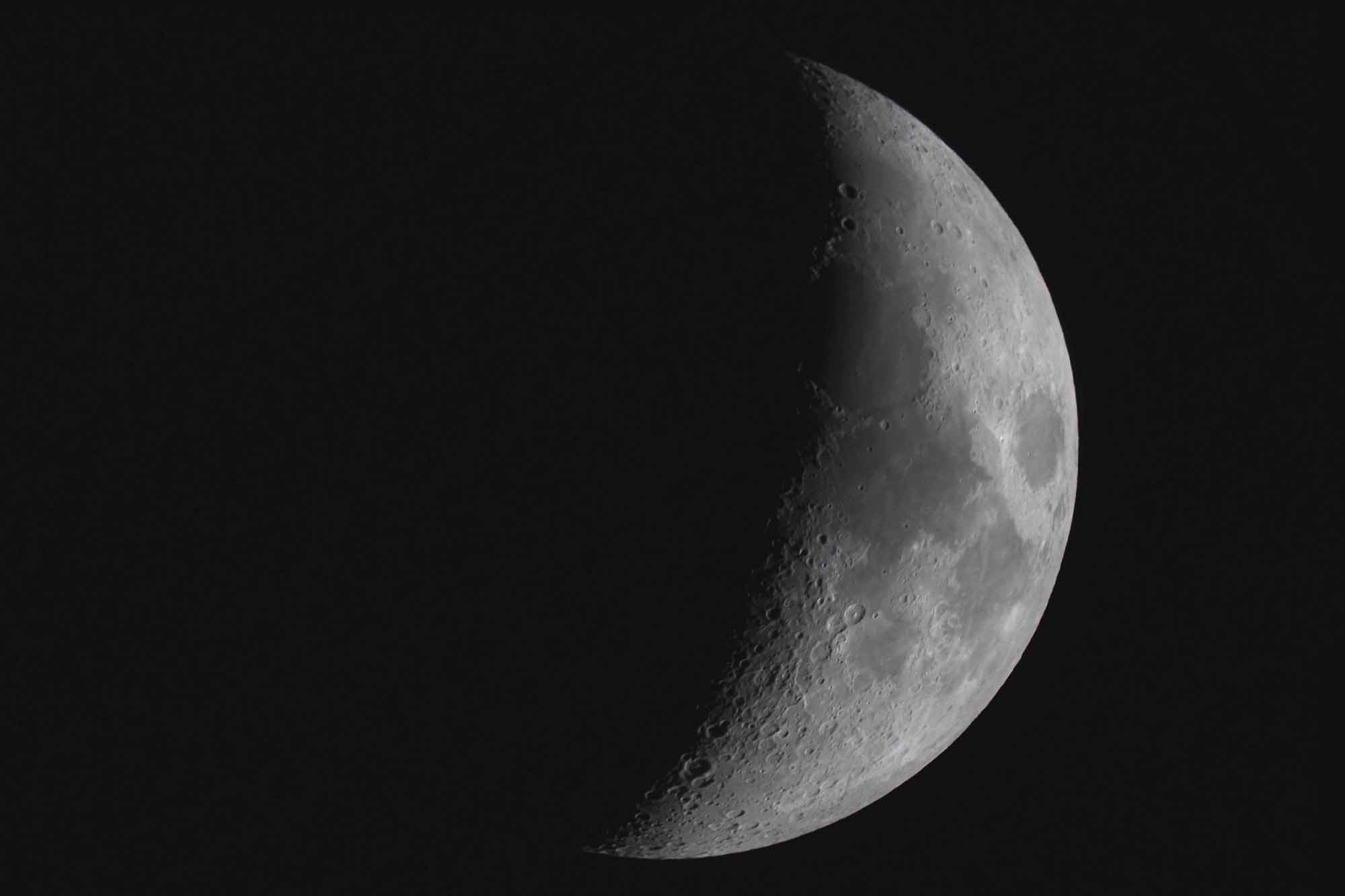 |
Astrophotography - images that are out of this world .... and then some ... !  The Heart Nebula: Also known as the 'Valentine Nebula', this Deep Sky Object lies about 7,500 light years from Earth and is located in the Perseus Arm or our home galaxy, the Milky Way. Found in the constellation Cassiopeia, The Heart Nebula was discovered in 1787 by William Herschell. It is an emission nebula that shows glowing ionized hydrogen gas and darker dust lanes. The small group of stars near the nebula's centre are producing the radiation that causes the hydrogen to ionize - and which allows us to see it. This group of stars, known as an open cluster, has many dim stars that are only a fraction the size of our Sun - but is also has bright stars 50 times the mass of our own Sun. Imaged in Hydrogen alpha light from our own backyard, in Oakville, Canada. For a Black & White image, in Hydrogen Alpha light only, click HERE 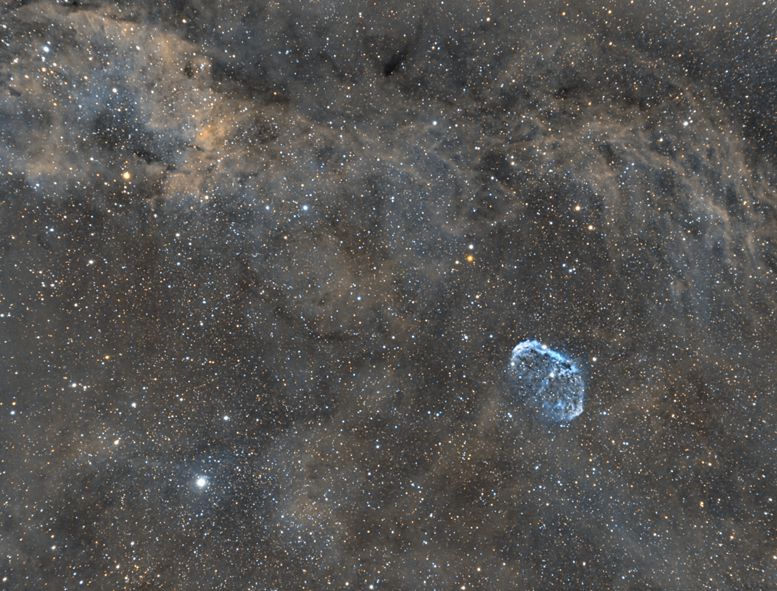 Click for larger image The Crescent Nebula: Beautiful to look at, but one has to understand that this is a snapshot, so to speak, of part of the stellar life cycle, more specifically, stellar death and cosmic recyling. The 'floating brain' shape is defined by various shock waves. The molecular/dust cloud in this region only adds to the visual appeal of this image. There are other versions of this image elsewhere on this website but this particular is rendered in the Hubble Space Telescope colour palette, with one extra and important processing step. This image represents about five hours' worth of one-minute exposures, in Hydrogen alpha, Oxygen III and Sulphur II, processed in PixInsight. Imaging equipment was set up in the Tony Horvatin Observatory, part of the larger E.C. Carr Astronomical Observatory, in Ontario, Canada, over three nights in August 2018. The site is owned and operated by the Royal Astronomical Society of Canada - Toronto Centre. ================================== More information on RASC: Royal Astronomical Society of Canada More information on RASC-TC: RASC Toronto-Centre  Click for larger image The Cygnus Wall: This is an interesting part of the larger North America Nebula, in the constellation Cygnus. The bright area in the image is a vibrant star creation region that is producing a lot of Hydrogen alpha light, which is what most of this image is composed of. The dark regions of dust lend a spectacular contrast to the image... ---------
From
Wikipedia: The
North America Nebula is large, covering
an area of more than four times the size of
the full moon; but its surface brightness is
low, so normally it cannot be seen with the
unaided eye. Binoculars and telescopes with
large fields of view (approximately 3°) will
show it as a foggy patch of light under
sufficiently dark skies.
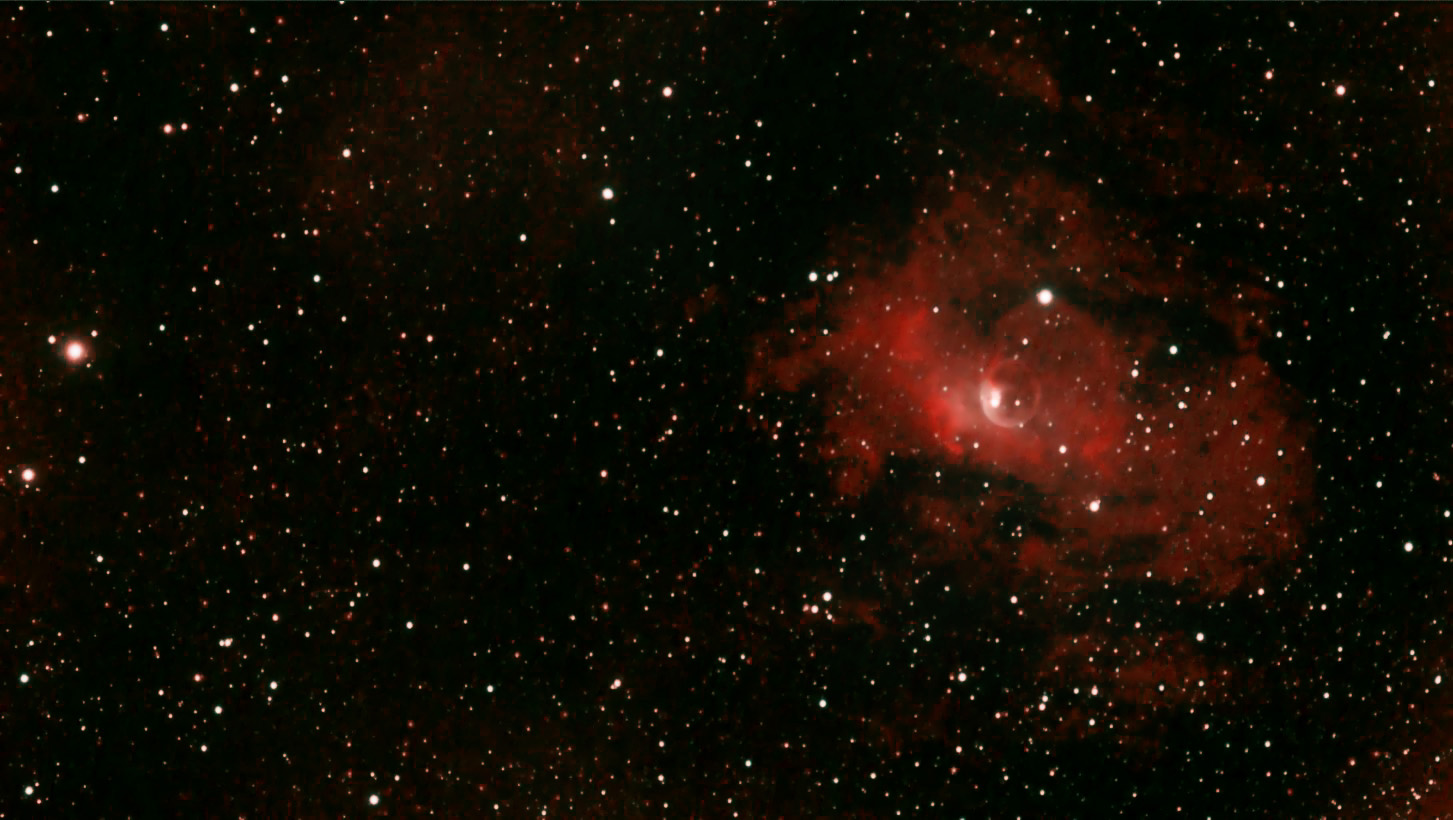 The Bubble Nebula: It's easy to see why we call this exploded star The Bubble Nebula. From
WIkipedia:
NGC
7635, also known as the Bubble
Nebula, Sharpless 162, or Caldwell
11, is a H II region emission
nebula in the constellation Cassiopeia. It
lies close to the direction of the open
cluster Messier 52. The "bubble" is created
by the stellar wind from a massive hot, 8.7
magnitude young central star, SAO 20575
(BD+60°2522).
The nebula is near a giant molecular cloud which contains the expansion of the bubble nebula while itself being excited by the hot central star, causing it to glow. It was discovered in 1787 by William Herschel. The star BD+60°2522 is thought to have a mass of about 44 M☉. I have been working on gathering data for this image for some time and, even though this image is improved over the earlier version, I still hope to pursue it again, this time using a Schmidtt-Cassegrain system with an Off-Axis Guider, that should produce a very good image. 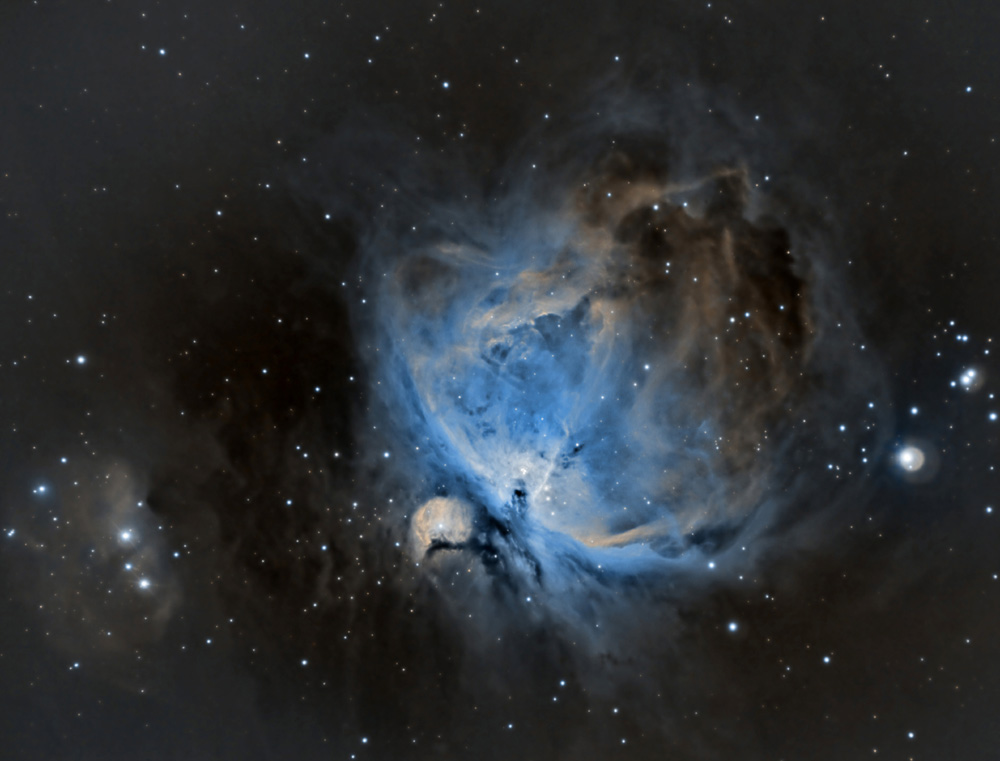 Click for larger image Messier 42 - The Great Orion Nebula: In Northern latitudes, this bright nebula is a Winter favourite. From
WIkipedia:
The Orion
Nebula (also known as Messier 42,
M42, or NGC 1976) is a diffuse nebula
situated in the Milky Way, being south of
Orion's Belt in the constellation of Orion.
It is one of the brightest nebulae, and is
visible to the naked eye in the night sky.
M42 is located at a distance of 1,344 ± 20 light years
and is the closest region of massive star
formation to Earth. The M42 nebula is
estimated to be 24 light years across.
It has a mass of about 2,000 times that of
the Sun. Older texts frequently refer to the
Orion Nebula as the Great Nebula in
Orion or the Great Orion Nebula.
The Orion Nebula is one of the most scrutinized and photographed objects in the night sky, and is among the most intensely studied celestial features. The nebula has revealed much about the process of how stars and planetary systems are formed from collapsing clouds of gas and dust. Astronomers have directly observed protoplanetary disks, brown dwarfs, intense and turbulent motions of the gas, and the photo-ionizing effects of massive nearby stars in the nebula. 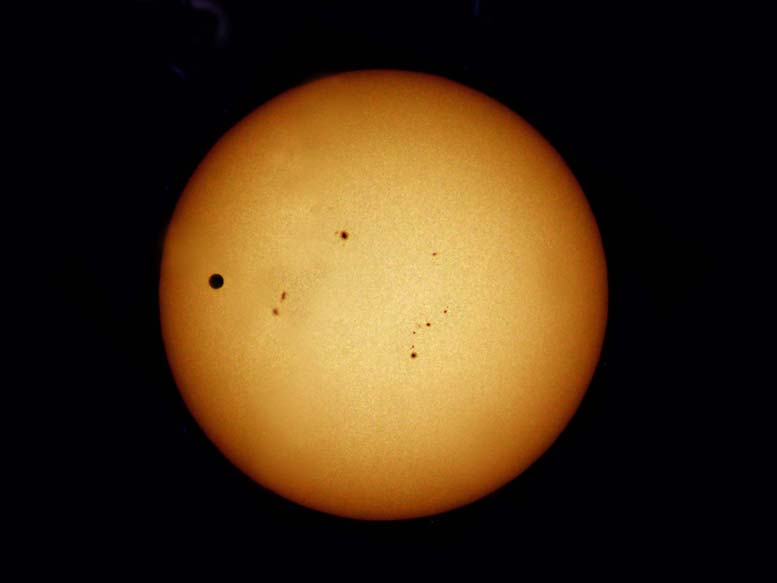 Click for larger image Transit of Venus: From 2012 ... this is the movement of the planet Venus "in front" of the Sun. Actually, it is just a unique alignment of our solar system that places our second-planet-from-the-Sun between our Earth and our nearest star's solar disk. Transits of Venus are among the rarest of predictable astronomical phenomena. They occur in a pattern that generally repeats every 243 years, with pairs of transits eight years apart separated by long gaps of 121.5 years and 105.5 years. The periodicity is a reflection of the fact that the orbital periods of Earth and Venus are close to 8:13 and 243:395 commensurabilities. The last transit of Venus was on 5 and 6 June 2012, and was the last Venus transit of the 21st century; the prior transit took place on 8 June 2004. The previous pair of transits were in December 1874 and December 1882. The next transits of Venus will take place on 10–11 December 2117, and 8 December 2125. This image was actually captured using an entry-level consumer telescope, with it set up near the tomato plants in our backyard, in Oakville, Ontario. IMPORTANT: You must never look at the Sun without proper and safe equipment. Not using proper safety here can cause irreparable vision loss.  The Pleiades: Also known as The Seven Sisters, this open cluster of stars is a winter favourite and can be found in the constellation of Taurus (The Bull). The Pleiades is one of the closest star clusters nearest Earth and easily visible without magnification. Think of star clusters as cosmic chandeliers, hanging in the space above and below our home galaxy. The blue reflection from dust is always appealing. Click to enlarge 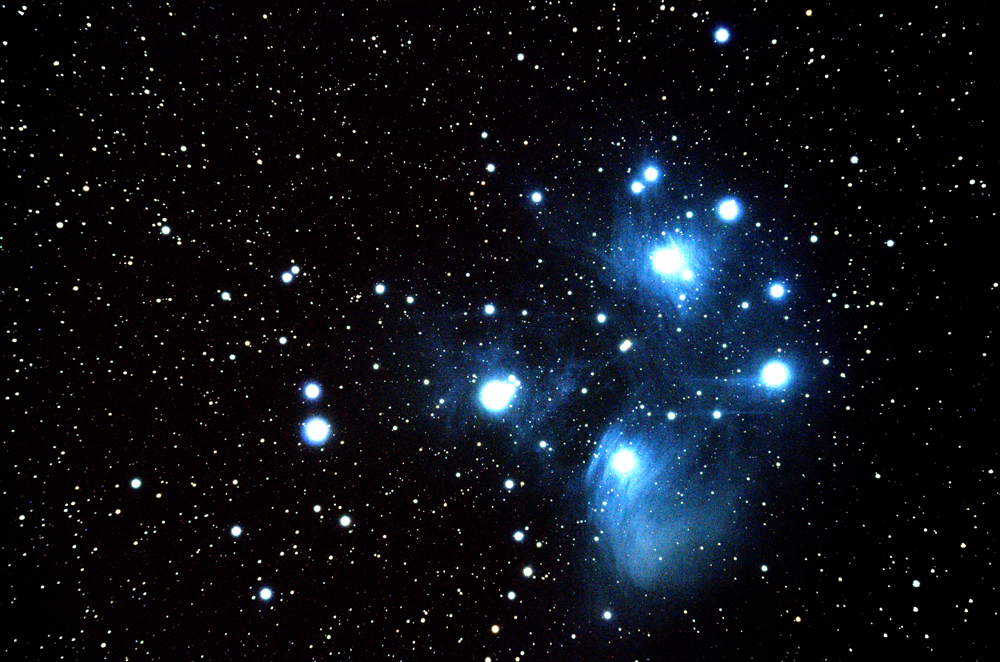 Perseid Meteor: The top image shows a Perseid meteor streaking down, just to the right of the Big Dipper. This image was taken at the Carr Astronomical Observatory. That's the home/sleeping quarters of the CAO, to the left of the image. What is not in the picture are the many actual observatories on this site, near Collingwood, Ontario, Canada. The lower image, courtesy STELLARIUM, shows the stars etc. that are in the upper image. ---------
From
Wikipedia:
https://en.wikipedia.org/wiki/Perseids The
Perseids are a prolific meteor shower
associated with the comet Swift–Tuttle. The
meteors are called the Perseids because the
point from which they appear to hail (called
the radiant) lies in the constellationPerseus.
 The EASTERN VEIL NEBULA - C33: This image represents about six hours worth of exposure, using a special astronomical camera, with its sensor cooled to -20C. Image data was collected over September and October, 2017, at several different sites, including the Carr Astronomical Observatory. The Eastern Veil, in the Constellation Cygus (The Swan), is a supernova remant. It is from supernovae that the universe gets all of the elements from about Iron up, on the Periodic Table of Elements, through a process called Supernova Nucleosynthesis. For more on this, click: NUCLEOSYNTHESIS  LAGOON and TRIFID nebula: This image represents merely four minutes worth of data, on the region of Sagittarius where you can find the larger Lagoon Nebula and its smaller cosmic neighbour, the Trifid Nebula. The region is now so close to the horizon that I am not confident I will be able to collect any more data on it this year. We'll see what tomorrow brings .... Imaged at the E.C. Carr Astronomical Observatory. Techy stuff: Some people have asked how images like this can be captured. Well, it is not easy and there are 100 things that can go wrong when you are doing this work. The two images above, show some of the software interfaces that are used when running imaging instruments this way. The top image is how we keep track of the "guiding" and the lower image represents a message from the computer+software+telescope+camera to rotate the camera a certain amount to achieve a particular image composition, which was selected earlier and saved to the imaging system's memory. And if having 100 things that can go wrong and stop you dead in your tracks isn't enough of a disincentive, there is the reality that you generally have to stay up all night, often in the cold. OK, one last example. above .... this is a calculation that informs how a piece of computer-driven hardware is configured. To do this well, this calculation should be done with every imaging run. Most of the time, I just estimate the value but think that I am now moving to just making this brain-buster part of every "set up."  THE EAGLE NEBULA: This deep sky region is very low to the South, at this location, making it a challenge to image. This image represents three hours exposure, with one hour at the North Frontenac Dark Sky Preserve, in Eastern Ontario, and with two hours at the Carr Astronomical Observatory, near Collingwood, also in Ontario. The so-called Eagle, roughly in the centre, is where you will find the famous Pillars of Creation. ---------
From Wikipedia:The Eagle Nebula (catalogued as Messier 16 or M16, and as NGC 6611, and also known as the Star Queen Nebula and The Spire) is a young open cluster of stars in the constellation Serpens, discovered by Jean-Philippe de Chéseaux in 1745–46. Both the "Eagle" and the "Star Queen" refer to visual impressions of the dark silhouette near the center of the nebula,[2][3] an area made famous as the "Pillars of Creation" imaged by the Hubble Space Telescope. The nebula contains several active star-forming gas and dust regions, including the Pillars of Creation.  BODE'S GALAXY & CIGAR GALAXY: Image is of Messier 81 & Messier 82. aka Bode's Galaxy and the Cigar Galaxy. Canon T5i: iso1600 about 35 X 60-seconds and the remainder X 90-second exposures T = approx. 75mins ISO1600 No calibration frames were
used -- because the Long Exposure Noise
Reduction software was enabled during this
imaging session.
---------
From
Wikipedia:
Messier 81 (also known as NGC 3031 or Bode's Galaxy) is a spiral galaxy about 12 million light-years away, in the constellation Ursa Major. Due to its proximity to Earth, large size, and active galactic nucleus (which harbors a 70 million solar mass/supermassive black hole), Messier 81 has been studied extensively by professional astronomers. The galaxy's large size and relatively high brightness also make it a popular target for amateur astronomers. Messier 82 (also known as NGC 3034, Cigar Galaxy or M82) is a starburst galaxy approximately 12 million light-years away in the constellation Ursa Major. A member of the M81 Group, it is about five times more luminous than the whole Milky Way and has a center one hundred times more luminous than our galaxy's center. The starburst activity is thought to have been triggered by interaction with neighboring galaxy M81. As the closest starburst galaxy to Earth, M82 is the prototypical example of this galaxy type. SN 2014J, a type Ia supernova, was discovered in the galaxy on 21 January 2014. In 2014, in studying M82, scientists discovered the brightest pulsar yet known, designated M82 X-2. 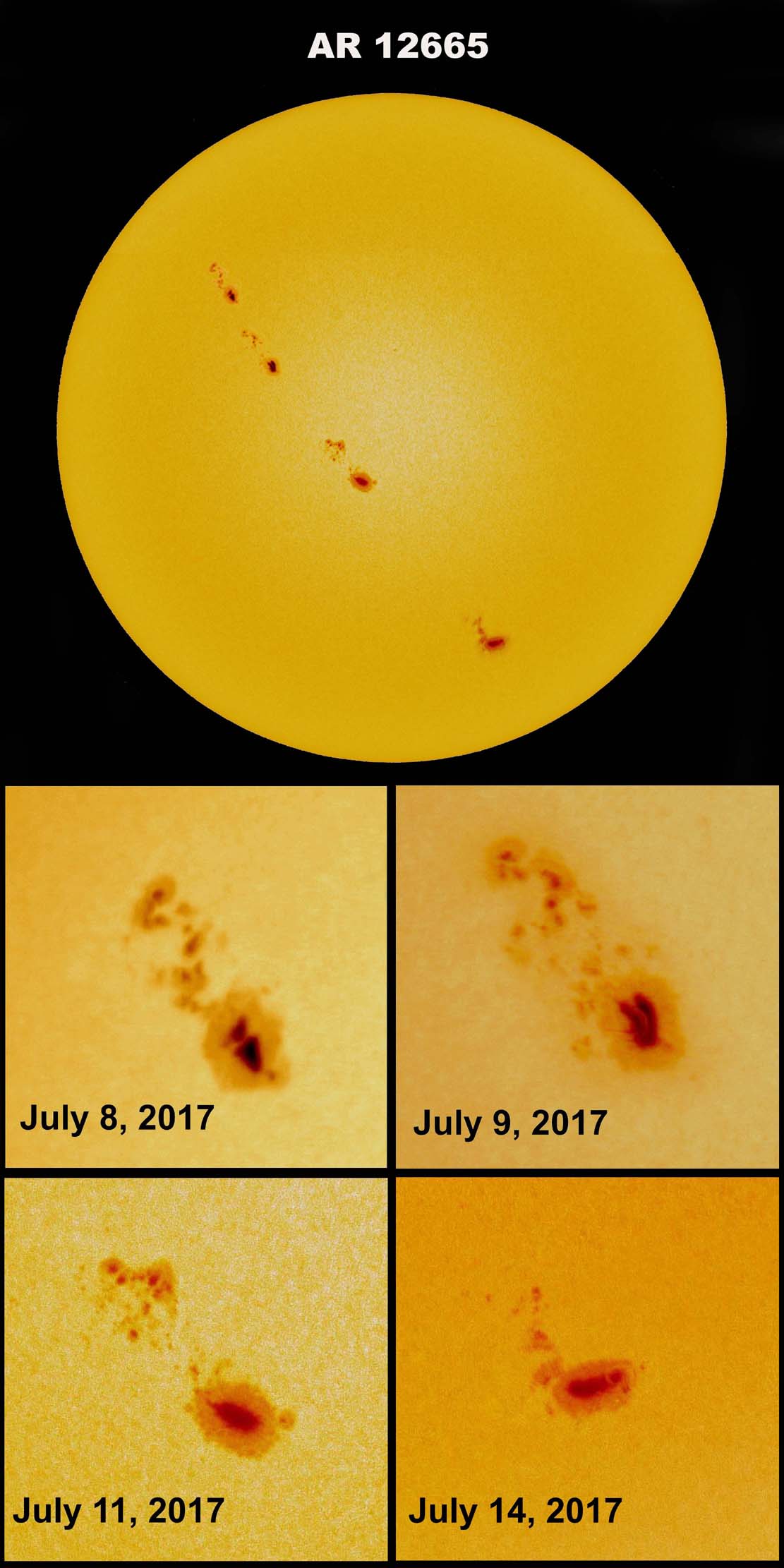 IMPORTANT: You must never look at the Sun without proper and safe equipment. Not using proper safety here can cause irreparable vision loss. AR 12665 - HUGE REGION OF SUNSPOT ACTIVITY. OK ... here's another one from the vault. Imaged in July 2017 from the backyard. Processed June 25, 2018. The image shows the changes in this vast area over six Earth days. It also shows the rotation of the sun, as well as its axis, relative to our home planet. ------------------ Wanna do science? OK, look at the image and consider the number of days represented by the spread of the sunspot images. From that, you should be able to figure out, roughly how long a solar 'day' is ... or, expressed a different way, how long does it take the Sun to do a full rotation? ----------------- Let's see if I can get this part right ... -- The total area of this sunspot region is about 690 millionths of a solar hemisphere ... or about 2141 million square kilometres. -- The magnetic classification is Beta Gamma ... A complex region in which the positive and negative polarities are so irregularly distributed that they can't be classified as a bipolar Sunspot group. If interested, you can read more about this here: https://www.spaceweatherlive.com/en/archive/2017/07/11/dayobs  A CLUSTER OF GALAXIES. These galaxies - and many more - are found in the constellation Virgo. These are always a treat when, at this northern latitude, we leave Winter and head into the so-called Spring 'galaxy season.' ABOVE: The answer .... about 30 galaxies. 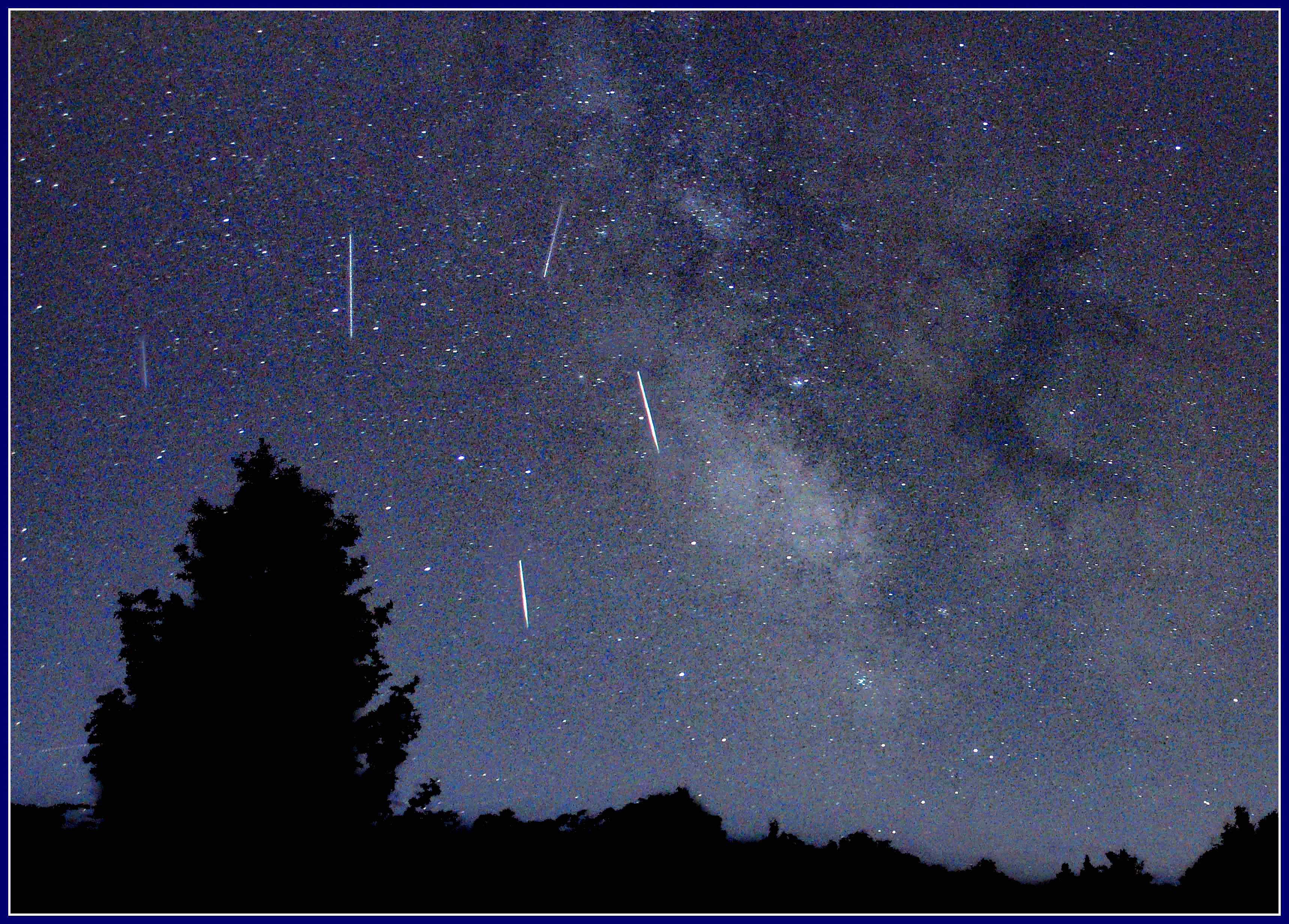 PERSEID METEORS and the Dark Horse. Imaged from Manitoulin Island, far from any light pollution. That is the centre of the Milky Way, rising vertically, just to the left of the Dark Horse. The Milky Way is our home galaxy.... 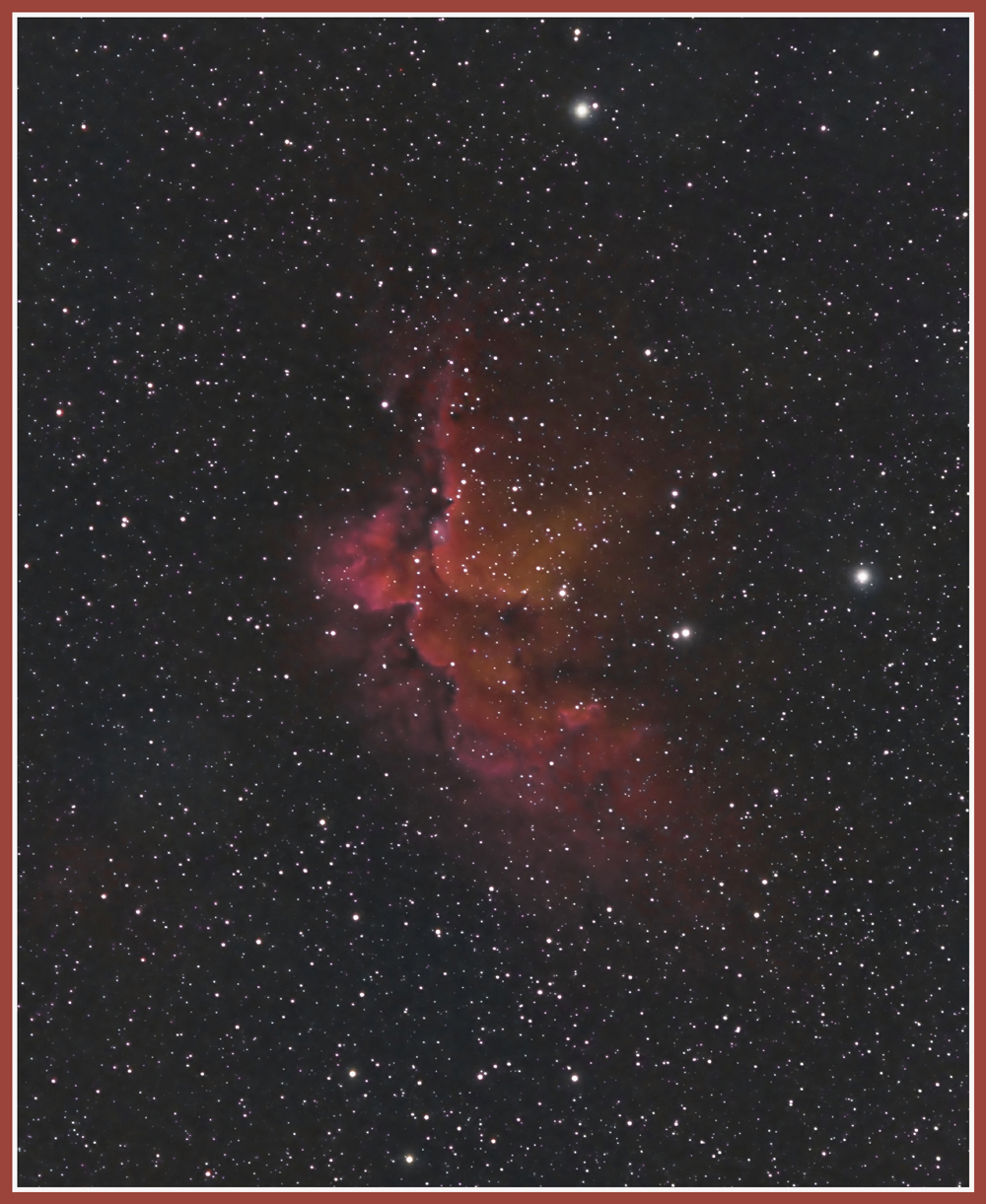 The Wizard Nebula is
an open cluster
discovered by Caroline Herschel
in 1787. To see this nebula imaged
in Oxygen III and Hydrogen alpha light
only, click here:
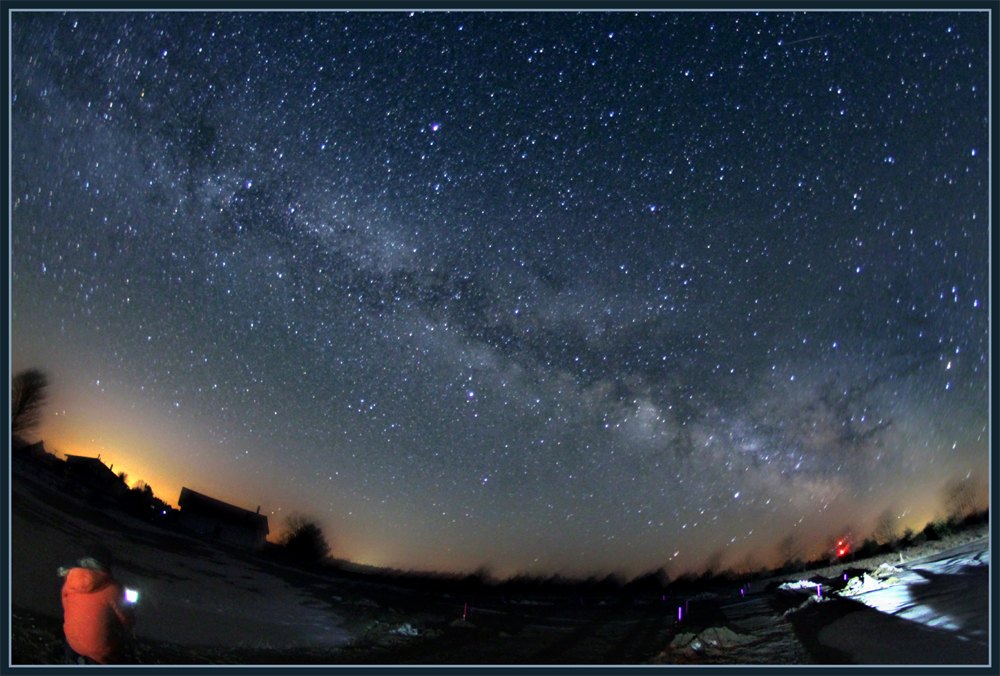 THE MILKY WAY: This image was captures in late April 2018, shortly after 2 a.m. in an area of very dark sky, in Eastern Ontario, Canada. This image is a stacking of 10 20-second exposures and processed in PixInsight. To see a larger version of this image, please just click on the picture. To see a 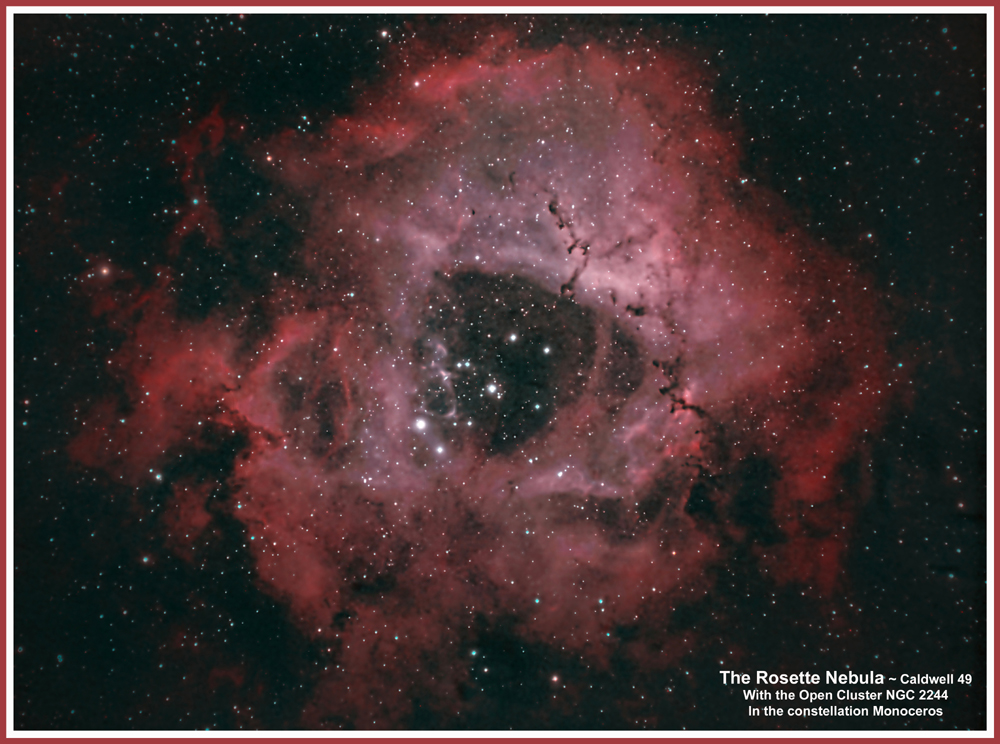 This is the
stunning ROSETTE NEBULA, in Monoceros.
More scientifically known as Caldwell 49, this
is a large spherical
H II region (circular in appearance) located near one end of a giant molecular cloud in the Monoceros region of the Milky Way Galaxy, our home galaxy. The open cluster of stars NGC 2244 (Caldwell 50) is closely associated with the nebulosity, the stars of the cluster having been formed from the nebula's matter. The cluster and nebula lie at a distance of some 5,000 light-years from Earth and measure roughly 130 light years in diameter. The radiation from the young stars excites the atoms in the nebula, causing them to emit radiation themselves producing the emission nebula we see. The mass of the nebula is estimated to be around 10,000 solar masses. A survey of the nebula with the Chandra X-ray Observatory has revealed the presence of numerous new-born stars inside optical Rosette Nebula and studded within a dense molecular cloud. Altogether, approximately 2500 young stars lie in this star-forming complex, including the massive O-type stars HD 46223 and HD 46150, which are primarily responsible for blowing the ionized bubble. Most of the ongoing star-formation activity is occurring in the dense molecular cloud to the south east of the bubble. The Deep Sky Object was imaged from our home, near Toronto, Canada. To see are larger format version of this same picture, please just click on it. Thanks for looking... 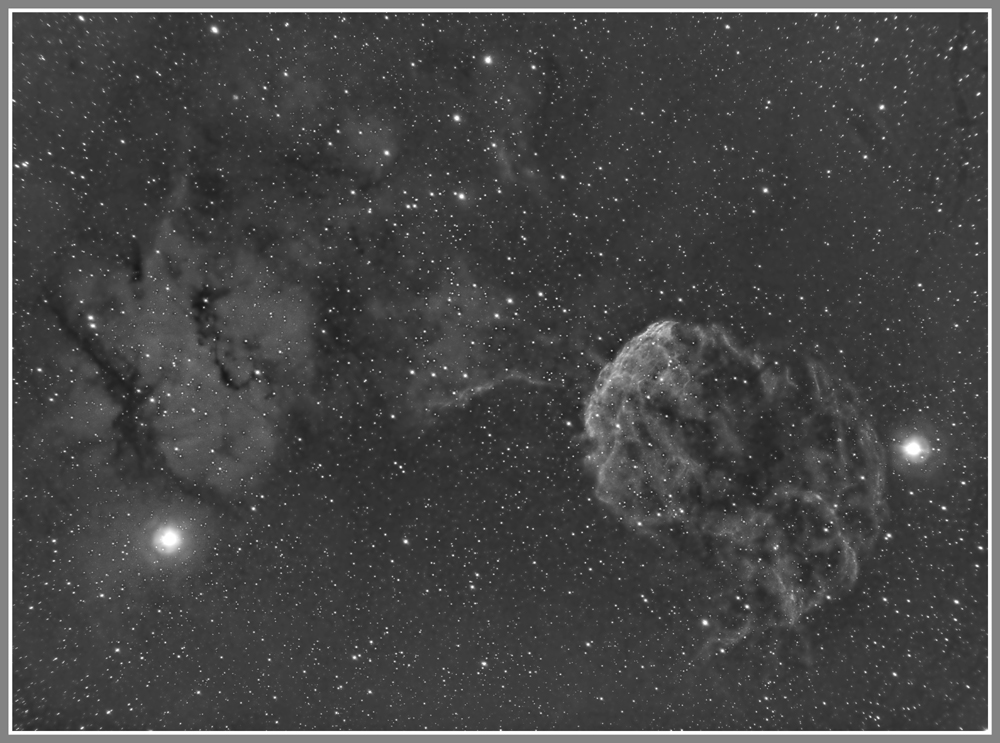 The
JELLYFISH NEBULA is a Galactic supernova
remnant in the constellation Gemini. To see are larger format
version of this same picture, please just
click on it. Thanks for looking...
Here is another image of the same target. This time, with a different telescope, with a longer focal length. Will try for more data on this next year, when it comes around again in the late-winter night sky. 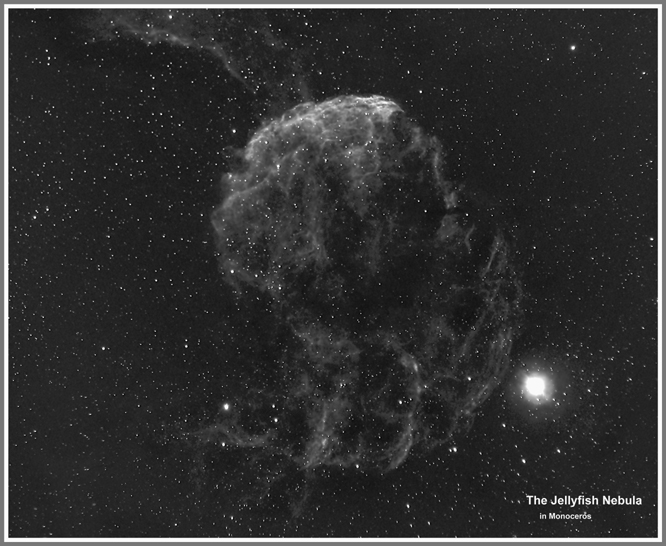 JELLYFISH NEBULA: To see are larger format version of this same picture, please just click on it. Thanks for looking... |
||||||||||||||||||
>>> To see a photo of Connie's Galaxy, please click here: 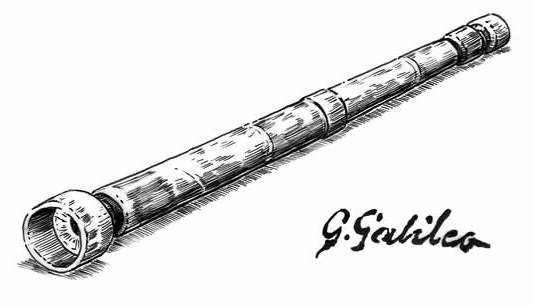 |
>>> To see a photo of the Horsehead and Flame nebulae, please click here:  |
>>> To see a photo of the Orion and Running Man nebulae, please click here:  |
>>> To see a photo of the planet Mercury passing in front of the Sun, please click here: 
|
>>>
To see a photo of the Crescent
Nebula, in Hydrogen-alpha light,
please click here:
 |
>>>
To see a photo of Alexandra's Galaxy,
please click here:
 |
>>>
To see a photo of the star Sadr (The
Hen's Chest),
please click here:
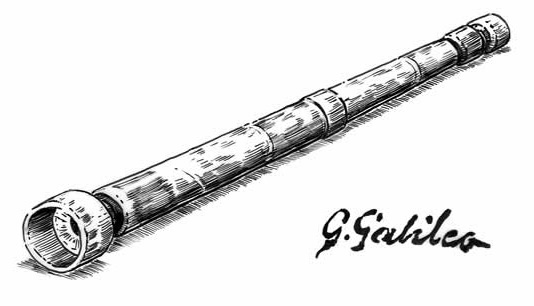 |
>>>
To see photos of the Total Solar
Eclipse, please click
here:
 |
Please come back soon.


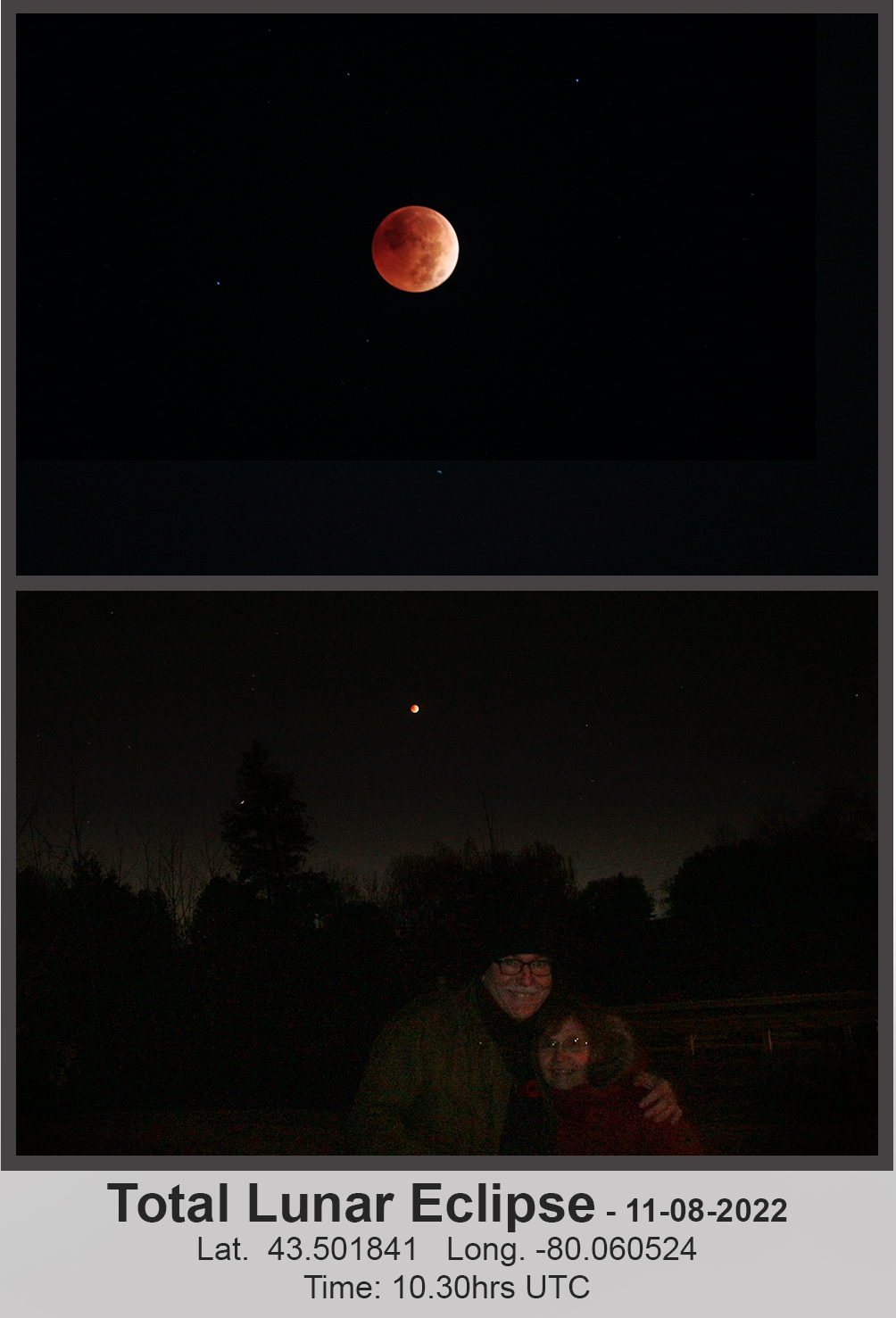 Above, the photo is a mosaic … a
photo illustration, if you will … composed of
11 or 12 separate images, taken this morning
(Nov. 8, 2022) around 5.30 a.m.,
ostensibly of the total lunar eclipse.
Above, the photo is a mosaic … a
photo illustration, if you will … composed of
11 or 12 separate images, taken this morning
(Nov. 8, 2022) around 5.30 a.m.,
ostensibly of the total lunar eclipse.
